 german radios - cn
german radios - cn
 german radios - cn
german radios - cn
 german radios - cn
german radios - cn
Anno: 1966/1967
Valvole ECC85 ECH81 EAF801 EF184 EM87 EM87 ECC808 ECC808 ECC83 ELL80 ELL80
Semiconduttori 4× AF126
Principio generale Supereterodina (in generale); ZF/IF 460/10700 kHz
N. di circuiti accordati 6 Circuiti Mod. Amp. (AM) 12 Circuiti Mod. Freq. (FM)
Gamme d'onda Onde medie (OM), lunghe (OL), corte (OC) e MF (FM).
Tensioni di funzionamento Alimentazione a corrente alternata (CA) / 110-125; 220 Volt
Altoparlante 2 altoparlanti / Ø 21 cm = 8.3 inch
Dimensioni (LxAxP) 730 x 240 x 250 mm / 28.7 x 9.4 x 9.8 inch
Stereo-Decoder
Potenza d'uscita 2 x 9 W
Peso netto 10.5 kg / 23 lb 2 oz (23.128 lb)
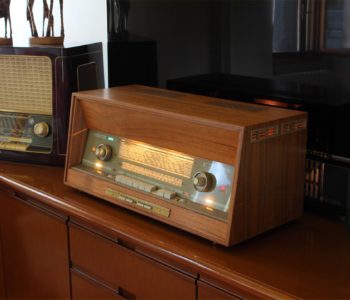 freiburg studio - cn
freiburg studio - cn
The Saba Freiburg Studio is almost identical to the Freiburg 14 and Freiburg Studio A.
The latter has a different design of the dialglass and the stereo decoder mounted standard, with its indicator on front.
The Saba Freiburg Studio is however ready for mounting a stereo decoder, so just insert it in the special socket after removing the plug.
The description is therefore the same as the Freiburg 14 model that has been previously reviewed.
The Saba Freiburg Studio are the highest expression of German production with regard to tube receivers equipped with automatic search.
No German receiver can give more, and none contains all the features and performances that Freiburg Studio have.
Electronically, it is the same machine used in the Saba Freiburg 14 or Saba STudio A, so refer to this page for the technical description, but the flexibility is very different.
In this description I will focus precisely on this versatility.
- The first advantage is that being without speakers the cabinet is much more compact, and this allows you to position it in the environment with much more ease.
- The second advantage is that is possible to pair the device with the most suitable speakers and position the speakers in the most appropriate way for ideal listening.
These possibilities offered by receivers, including the Saba Freiburg Studio, are extremely important. If well used they can radically change the sound of a system.

Bluetooth receiver embed
Each radio is equipped with a cable for connection to any digital device.
- Bluetooth receiver embed – The unit is equipped with a BLUETOOTH receiver powered directly by the receiver power supply. This makes it possible to control the amplifier from any external digital device as an IPAD, a Smartphone, or a sophisticated multimedia station. So you can hear your preferred web station or your lossesless file without cables on the room. Wireless Receiver can be equipped upon requests.
– Multi Platform Connection – A customized adaptation cable to connect any digital device as Iphone, Smartphone, Laptop, CD Player etc. will be provided with this radio. This special cable suits the different impedances between the modern equipment and the receiver. Furthermore the two stereo channels flow into one without increasing the load to the input unit.
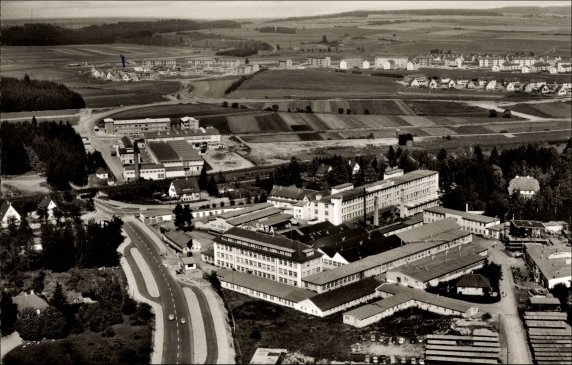

SABA is the acronym for Schawarzwälder-Apparate-Bau-Anstalt meaning engineering institute of Technological appliances of the Black Forest.
The company was founded back in 1835 by Joseph Benedikt with the initial name of Jockele-Uhren, but only in 1923 the production of radio devices began and the company went under the name of SABA.
Toward the end of the 20s SABA became famous with the well-known S35 and in the following years it became the second German producer after Telefunken. During the war SABA produced military equipment and in 1945 the company was completely destroyed by a bombing.
In 1947 the production of radio devices began again and SABA distinguished itself immediately for ist avant-garde and high- quality production.
hey also began to produce TVs (the first PAL color TV is a SABA), house appliances and medical equipment. Many Italians used to work there. The Alnico Greencone loudspeakers became popular for their linearity, power handling, constant impendence that would be employed in each Hi-Fi devices of that time.
The radio devices with motorized tuning became popular as well and SABA became the representative German brand meaning quality, reliability and detailed precision. In the 1970s the decline began. According to specialized magazines of that time not having a Japanese device at that time meant not having Hi-Fi. In the 80s Thompson took over SABA. In the 90s the other way around, having a Japanese device of the 70s meant not having Hi-Fi. They found out that they functioned with a 96% counterreaction and that a device with 0.001 db from 1 to 100 KHz extension did not necessarily sound good.
We do not trust our ears and we do trust what other people say not necessarily with a good purpose.
2007: due to insolvency SABA disappeared from the TLC (Chinese) and Thompson (French) joint venture, and SABA ceased to exist.
Year of production: 1963-64
10 AM Circuits
13 FM Circuits
Wavebands: Medium Waves (OM), Long Waves (OL), Short waves (OC), FM (UKW)
5 Greencone loudspeakers:
2 x 10" Alnico woofers
2 x 8" Alnico mid/woofers
1 Elliptical tweeter
Dimensions (LHD):: 27,6 x 17.9 x 12.2 inch
Net weight: 53.6 lb
14 Tubes: EC92 EC92 ECH81 EF89 EM87 EBF89 EF86 EF86 ECC83 ELL80 ELL80 EM84 EABC80 ECL80
Ferrite rotating aerial
Automatic tuning research
Optional remote control
FM stereo decoder arrangement


Rotating ferrite curve with lightened window indicating its position.
The ferrite curve can be rotated through a big knob which is coaxial to the volume knob. Inside the piece of furniture there is a dipole for the FM reception and a directable ferrite curve for the AM reception.
The device is equipped with separated tuning mechanisms for AM and FM bands and for each of the FM bands.
There is only one tuning knob but the selector changes on a cable and pulley system that are separated according to the band.
Worth noticing is the accuracy and the complexity of the motorized FM group.


The magic eye indicating the tuning of each station is new.
The tuning system is a masterwork.
It is a motor with windings supplied in a phase shifted by some capacitors. It permit to change the motor rotation direction of according to whether the search is in one sense or another.
The tuning is centered by drawing part of the signal from the CAC circuit and by using a relais controlled by a tube.
As already mentioned, calibration is rather complex and it cannot be put into practice without referring to SABA’s original manuals.
Below a detail of the engine and the scheme section to control the automatism.


Another interesting feature is the volume control.
The knob does not automatically control the volume potentiometer. It controls through an unknot push-back.
The motorized remote control has a slight friction effect which strengthens the resistance when you turn the knob.
The first small window that can be seen on the left side indicates whether the ferrite curve is inserted and its position.
On the left side you can also find the volume control (with incorporated loudness) and the ferrite curve rotation control.
Right above the volume control there is a magic eye indicating the perfect tuning of each station.
Below you can see the Mono/Stereo indicator and further below the bass control knob.
The AM bands with Short, Medium and Long Waves and the FM displays.
Starting from the lefthand corner you can see the Musik/Sprache, Stereo/Mono, AUX input buttons, the band switch buttons, the Long, medium, short waves and FM switch buttons and the motorized tuning system (Automatik) button.
Lastly the ON/OFF button.
Next to it the acutes control knob is to be found.
The Musik/Sprache equalizer indicator.
On the right, the tuning knob, which is supported by a big fly-wheel that renders its movement really pleasant.
The automatic tuning functioning indicator is to be found on the right as well.
Below two buttons for the automatic tuning functioning. Each button activates the automatic tuning mechanism in one or the other direction. By pushing one of those buttons the engine constantly activates the tuning indicator for a fast reposition.

Output for external speakers.
Socket for recorder (tonbandgerat).
Turntable input (Tonabnehmer)
AM and FM aerial inputs and ground socket.
Remote control inputs

 german radios - cn
german radios - cn
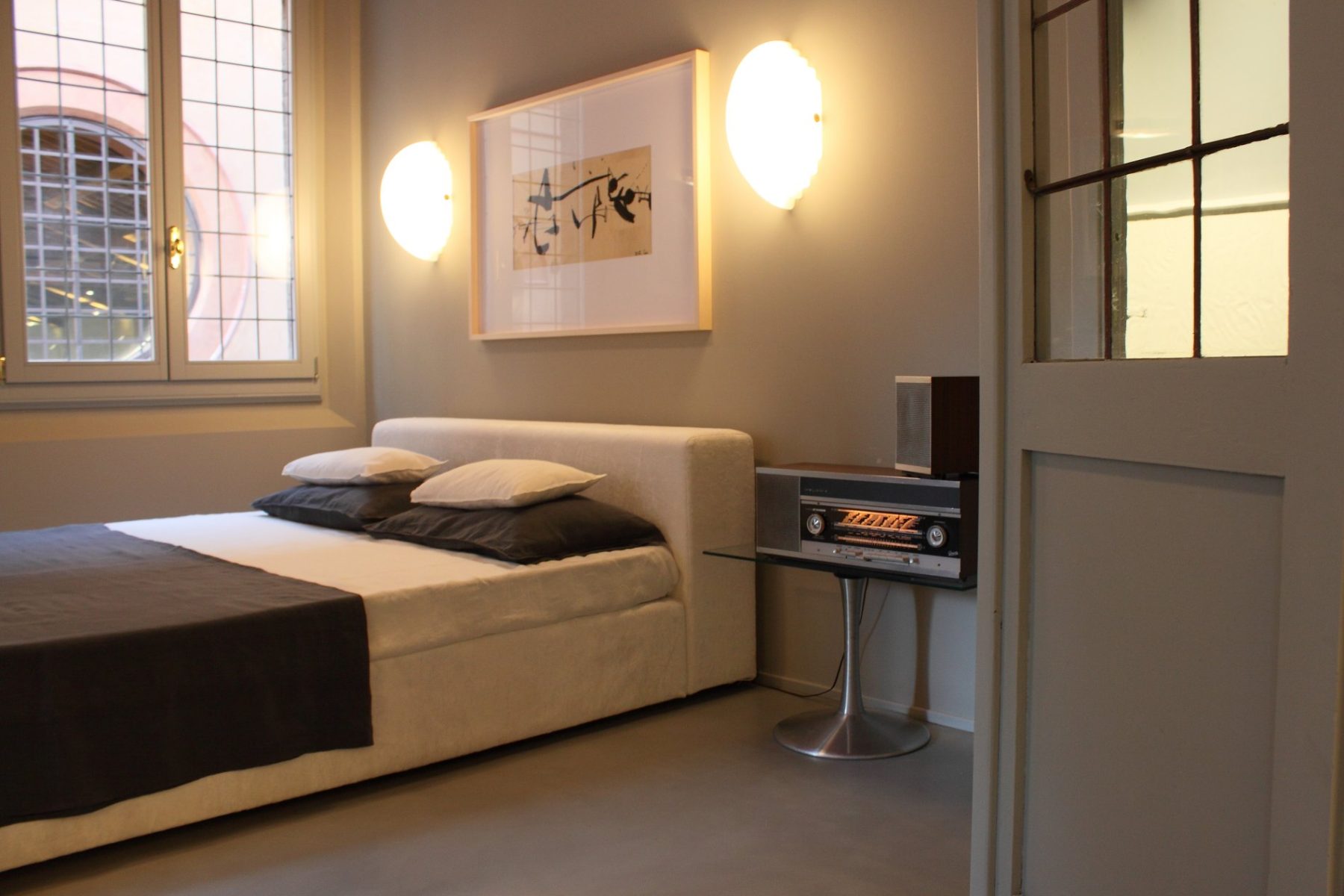

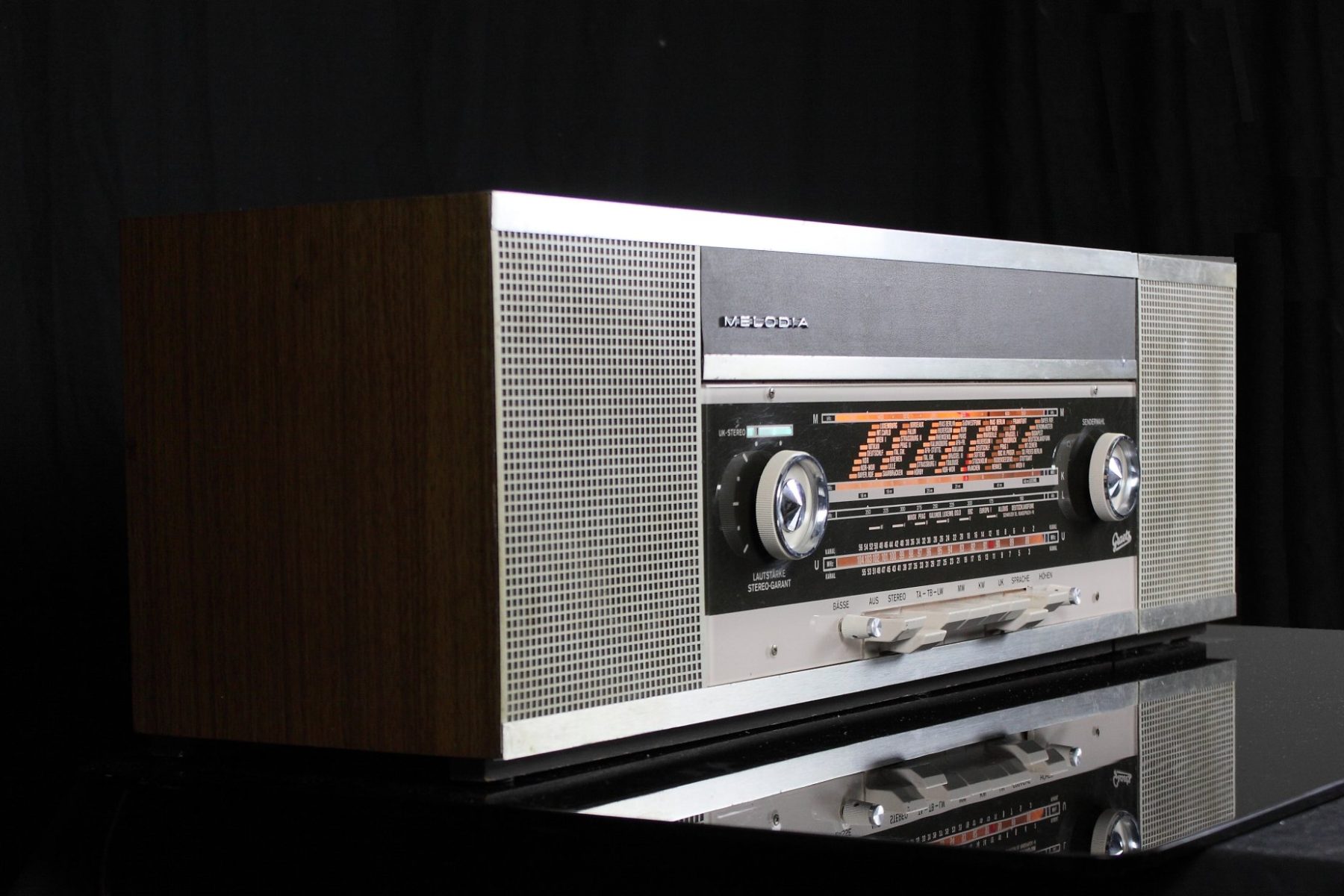

La Graetz Melodia 14F si distingue immediatamente dagli altri apparecchi prodotti nella metà degli anni 60 dalla prestigiosa marca di Berlino per il look modernissimo che faceva largo uso di metalli e plastiche.
Questo interessante esperimento di design lo si ritrova, oltre che sulla Melodia 14F, solo sul modello Stereo Unit 250.
Confrontando, nelle foto a destra, il modello Melodia 1118 finita di produrre solo l'anno prima e la Melodia 14F , non si può non rimanere impressionati dall'incredibile evoluzione stilistica dei due apparecchi.
Da sempre i prodotti Graetz sono stati caratterizzati da design ricercato e curatissimo, ma negli anni '60 c'è stata una vera e propria accelerazione anticipando uno dei più grandi movimenti creativi degli anni 70 conosciuto sotto il nome di "Space Age".
Dalla famosissima "Ball Chair" del grande designer Finlandese Eero Aarnio, alla Lampada Eclisse dell'italiano Vico Magistretti.
La Space Age sperimenta nuovi materiali e questo rende possibile esplorare forme nuove, precedentemente difficili da realizzare.
Molte aziende realizzano in quegli anni degli insuperati "oggetti" tecnologici oggi molto ricercati.
Tra i produttori di apparecchiature tecnologiche cito solo, oltre naturalmente alla Graetz con la Melodia 14F Stereo Unit 250, la Grundig con la serie di diffusori acustici HI-FI sferici AudioRama e l'italianissima Brionvega con la sua Tv Algol e la Radio cubo.
Nel 64 Charles Mingus lascia il contrabbasso per registrare l'album "Mingus Plays Piano", debuttano i "The Velvet Underground", e "The Who", in Italia si forma il gruppo "I giganti" e concludo la recensione rubandogli il loro grido di battaglia - Mettete dei fiori nei vostri cannoni ...
La Sezione Amplificatore è composta da una EL84 in classe A per ciascun canale, pilotata da una sezione del doppio triodo ECC83.
Il potenziometro di Volume è dotato di presa per la correzione fisiologica. (Giallo). Come noto infatti quando si ascolta a volume molto basso le note basse e quelle acute non vengono percepite con la stessa intensità sonora delle note medie, che appaiono nettamente in prevalenza.
Il Controllo di bilanciamento (Blu) è inserito tra i due canali all'uscita del preamplificatore.
La Rete di Controreazione (Rosso) è stata progettata per ridurre la distorsione ed equalizzare la risposta in frequenza dell'apparecchio. Infatti l'apparecchio è dotato di autonomi altoparlanti per ciascun canale. Questi altoparlanti pur essendo a larga banda e di ottima qualità non sono in grado di riprodurre fedelmente l'intera banda udibile. la loro risposta in frequenza infatti decade agli estremi, in particolare quello basso. Il circuito di controreazione compensa le cadute di efficienza dei diffusori ai due estremi della frequenza. Il risultato è una risposta sorprendentemente lineare su una banda di frequenze molto estesa. Non ci si aspetta un suono del genere da diffusori così piccoli, e questo è il modo in cui è stato ottenuto.
Anche la Sezione Radio è molto curata.
La caratteristica più interessante è l'elevata selettività di questo apparecchio dovuta al doppio stadio di Media Frequenza. Infatti sono visibili nelle foto i due pentodi EF89 ed i numerosi trasformatori MF.
In FM è stato implementato addirittura un ulteriore trasformatore accordato all'interno del convertitore per rendere ancora più stabile ed insensibile ai disturbi la ricezione di queste frequenze.
Infine la batteria di Altoparlanti.
La Graetz 922 Luxus monta 6 altoparlanti. Quattro altoparlanti sono disposti frontalmente e due sono collocati ai lati.
I quattro altoparlanti frontali sono due tweeter e due ellittici largabanda. I tweeter sono posti davanti ai largabanda, sullo stesso asse. Questa particolare disposizione ha il grande vantaggio che la provenienza del suono è assimilabile a quella prodotta da una sorgente puntiforme.
Questa caratteristica si traduce in un diagramma di dispersione molto lineare, e quindi di una acustica nell'ambiente molto più regolare che non se tweeter e woofer fossero disposti uno in fianco all'altro.
I due altoparlanti laterali sono, a questi livelli di potenza, dei Mid/Tweeter, e permettono un ascolto equilibrato da qualunque posizione ci si ponga rispetto alla radio, frontalmente o lateralmente.
Quest'ultima caratteristica rende l'apparecchio molto godibile nell'ascolto quotidiano. Non verrà più voglia di accendere l'impianto stereo ...


Bluetooth receiver embed
Each radio is equipped with a cable for connection to any digital device.
- Bluetooth receiver embed - The unit is equipped with a BLUETOOTH receiver powered directly by the receiver power supply. This makes it possible to control the amplifier from any external digital device as an IPAD, a Smartphone, or a sophisticated multimedia station. So you can hear your preferred web station or your lossesless file without cables on the room. Wireless Receiver can be equipped upon requests.
- Multi Platform Connection - A customized adaptation cable to connect any digital device as Iphone, Smartphone, Laptop, CD Player etc. will be provided with this radio. This special cable suits the different impedances between the modern equipment and the receiver. Furthermore the two stereo channels flow into one without increasing the load to the input unit.

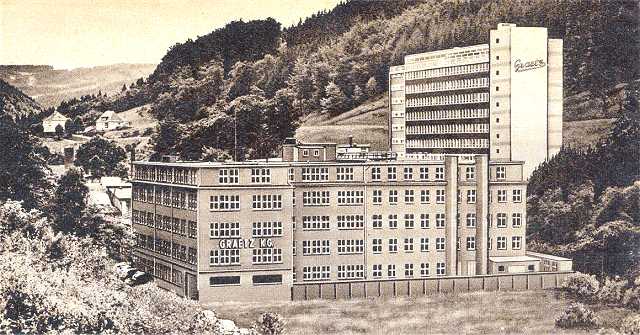
The Ehrich & Graetz metalworks was a factory established in 1866 in Berlin by Albert Graetz (1831–1901) and the tradesman Emil Ehrich (died 1887) under the name "Lampen-Fabrik Ehrich & Graetz OHG" (E&G).
By 1897 the firm was controlled by Albert's sons, Max Graetz, and Adolf Graetz. The company grew rapidly, and in 1899 factory complexes were built in Berlin, in the United States, France, the UK, and Bombay.
Around 1910-1916 Max Graetz developed the famous Petromax Lantern. Around 1925 the factory also produced radios, and other electrical appliances under the name Graetzor.
In the Second World War, just as in the First World War, the company was part of the war industry. With the use of forced laborers from France, Russia and the Netherlands the company made huge gains in production.
At the end of April 1945 the factory was claimed by the Russian army.
In 1949 the firm became part of the "peoples" program, "VEB-VolksEigenerBetrieb" and since 1950 "VEB Fernmeldewerk, Berlin Treptow (RFFT)." VolksEigenerBetrieb, means that the factory was owned by the people for the people (Communism)
In 1948 Erich, and Fritz Graetz founded a new company in Altena, Germany known by the name The Graetz Firm, which was successor to the lost family company in Berlin. The new company produced mainly radios and televisions.
In 1961 the company was then sold to Standard Elektrik Lorenz (SEL) AG, but since 1987 has been to the present owned by the Finnish company Nokia.
Year of production: 1966/68
Superheterodyne IF 460/10700
6 AM Circuits
10 FM Circuits
Wavebands:
Medium Waves(OM), Long Waves (OL)
Short waves (OC), FM (UKW)
Loudspeakers:
2 Elliptical Fullrange
Dimensions (LHD): 750 x 225 x 190 mm / 29.5 x 8.9 x 7.5 inch
Net weight: 10 kg / 22 lb 0.4 oz
7 Tubes: ECC85, ECH81, EBF89, ECC83, EMM803, 2xEL84


Gli altoparlanti sono due Lorez LP 1318/19/105 AF con magnete in Alnico. Sono molto efficienti. I 4 Watt di ciascuno dei due canali viene trasformato così in una notevole pressione acustica.
Per un ascolto a volume "normale", non fastidioso, la manopola viene posizionata ad ore 11.
La potenza sonora quindi è abbondantemente sufficiente per sonorizzare anche ambienti di medie dimensioni.
In tal modo la risposta dinamica è molto pronta, ed i bassi sono frenati ma molto presenti.
Questa caratteristica permette di sfruttare appieno l'ingresso AUX con file digitali lossesless o CD fornendo una riproduzione brillante e ricca di dinamica.
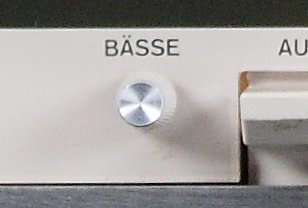
In linea con le più moderne tendenze (dell'epoca) vi è un unico tasto di equalizzazione, il tasto Sprache (Voce) che attenua le frequenze basse ed acute rendendo più intellegibile le trasmissioni dove prevale il parlato.
Ai lati troviamo le due manopole di controllo dei toni.
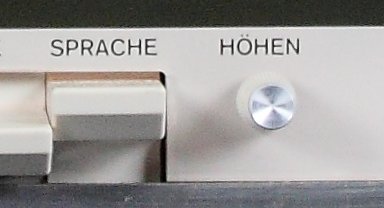
The unit is equipped with mechanisms that keep AM and FM bands separate very simple to use.
The tuning knob is single, but a selector switch commutes between cable systems (all steel made) and pulleys dedicated to each band.
The movement is transferred to both mechanisms with a system of pulleys and separated gears.

L'occhio magico ha una doppia funzione.
La sezione di sinistra (Rosa) indica che la stazione ricevuta sta trasmettendo in stereofonia.
La sezione di destra (Verde) indica la perfetta sintonia della stazione ricevuta.

Left from the top:
- The Magic Eye that indicates the perfect tuning of each station and the Stereo broadcast
- The volume control (with built-in loudness)
- Axially this balancing.
- The bass control knob
In the center:
The AM display for long, medium, short waves and the FM display.
Right from the top:
The tuning knob, whose movement is very pleasant being supported by a large flywheel
-The treble control knob.
The keyboard:
AUS - Switch off
STEREO - Stereo
TA - Turntables
TB (TA + LW) - Tape Recorder
LW - Long Waves
MW - Medium Waves
SW - Short Waves
UK - FM
SPREACHE - Voice

Output for external speakers, with the possibility of excluding the internal loudspeaker depending on how the DIN plug is inserted.
Socket for recorder (tonbandgerat).
Turntable input (Tonabnehmer)
AM and FM aerial inputs and ground socket

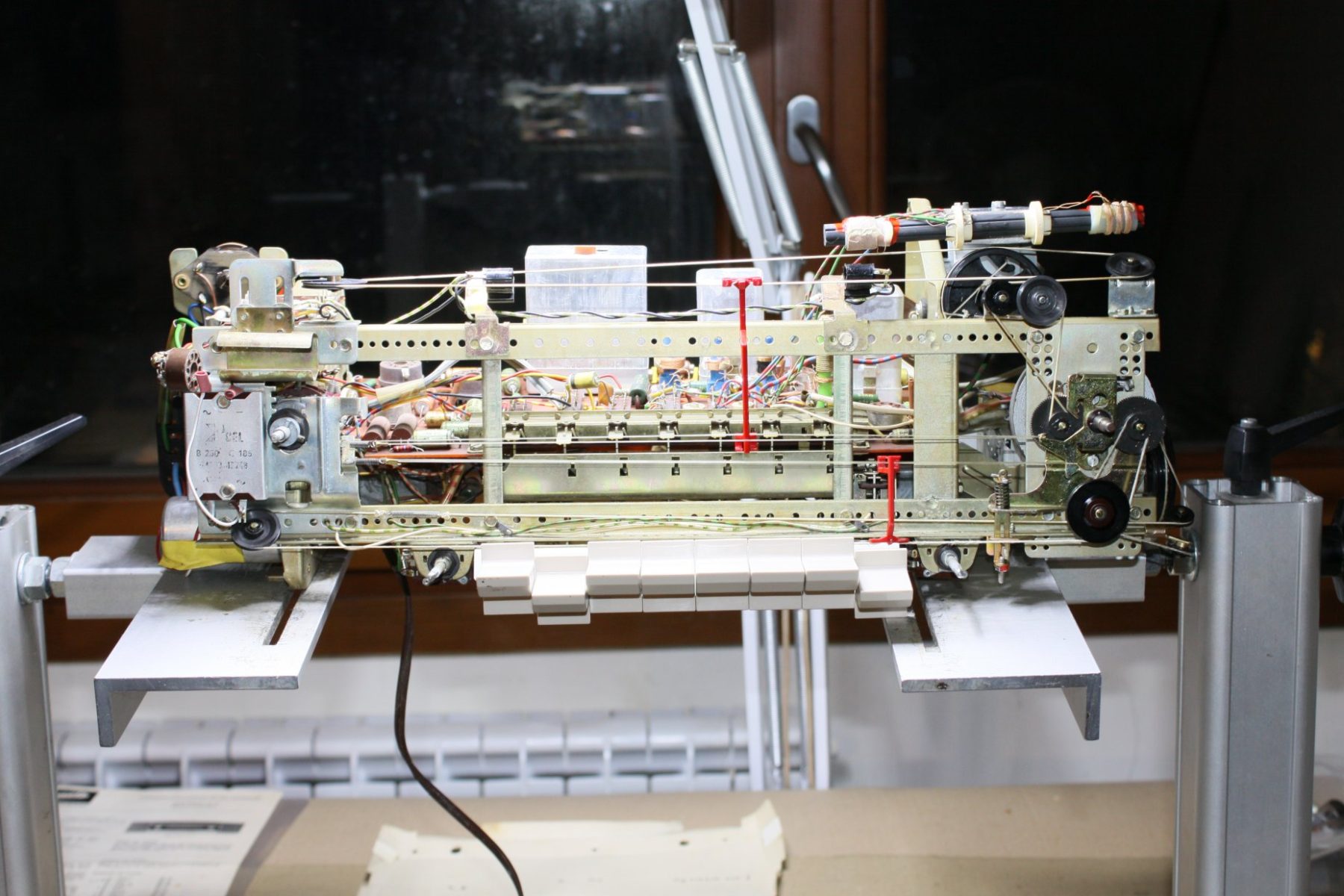





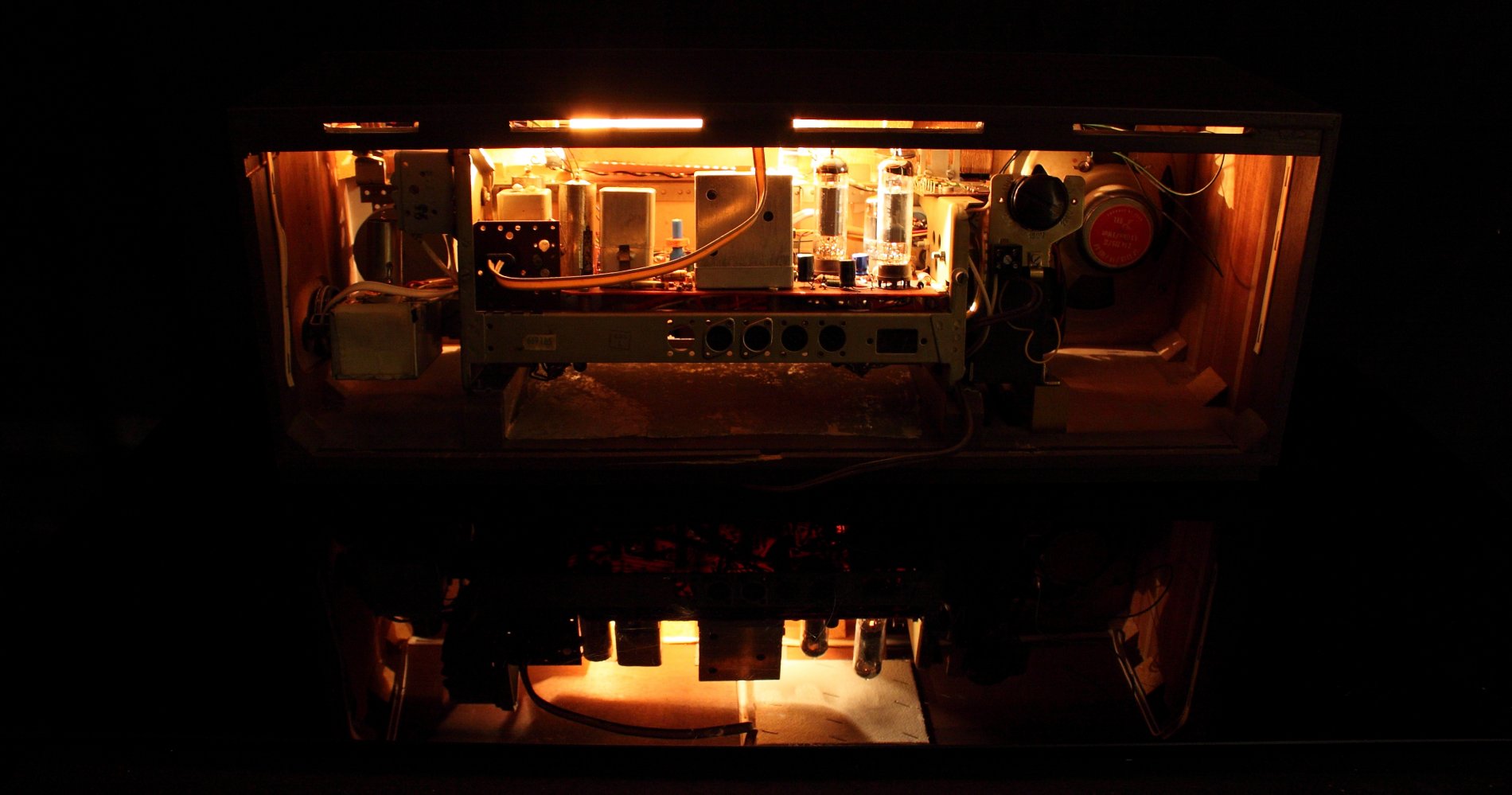
 german radios - cn
german radios - cn

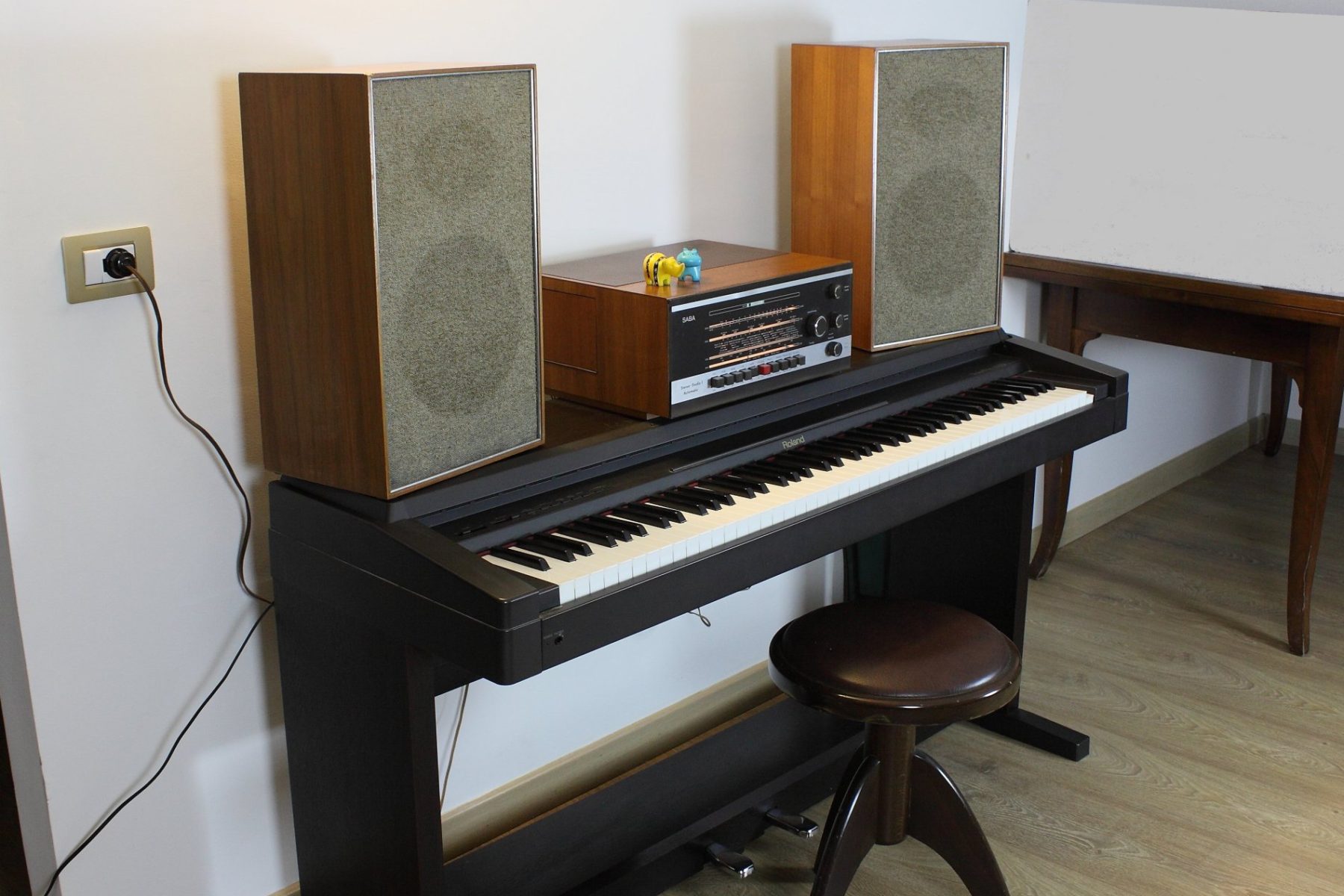






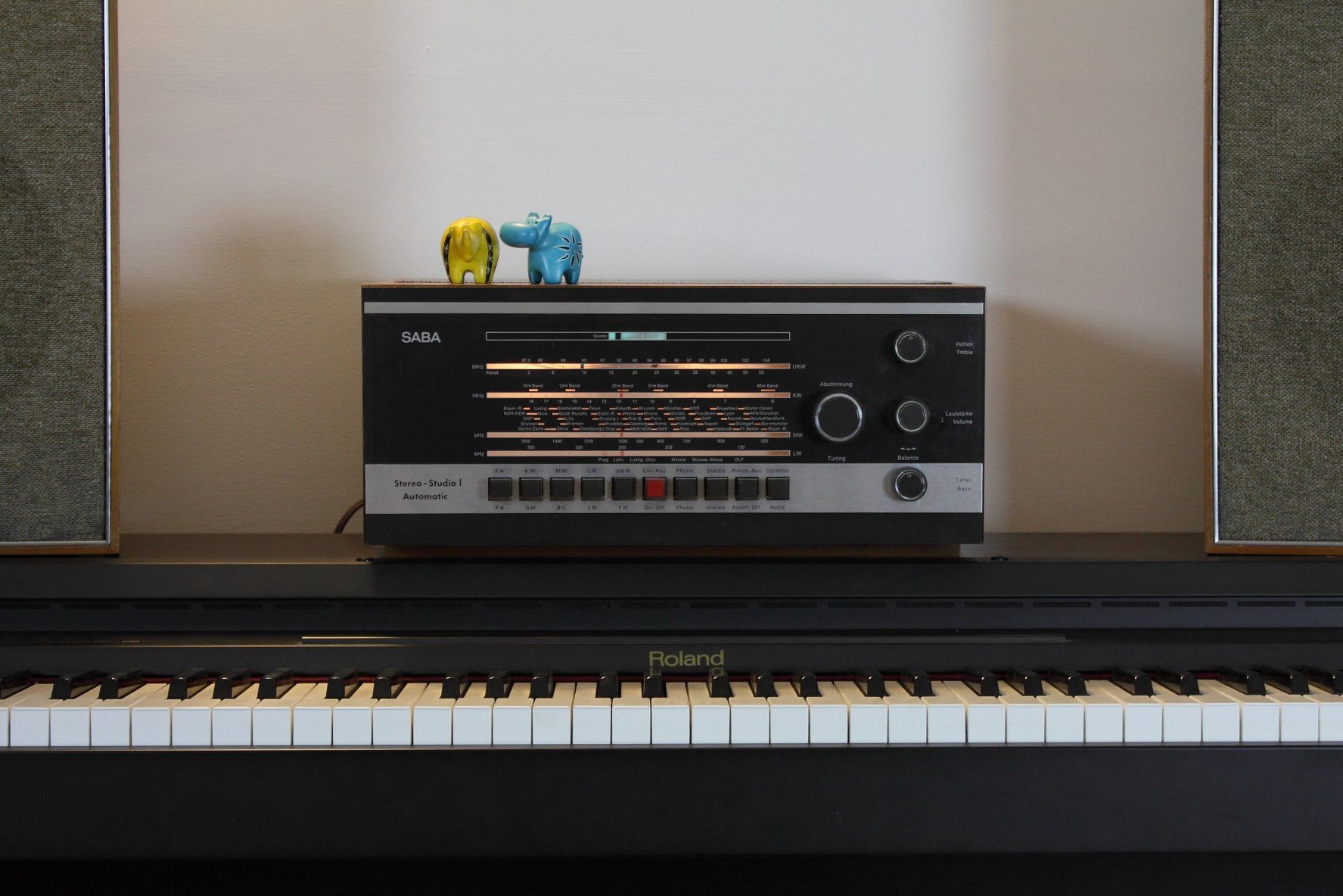




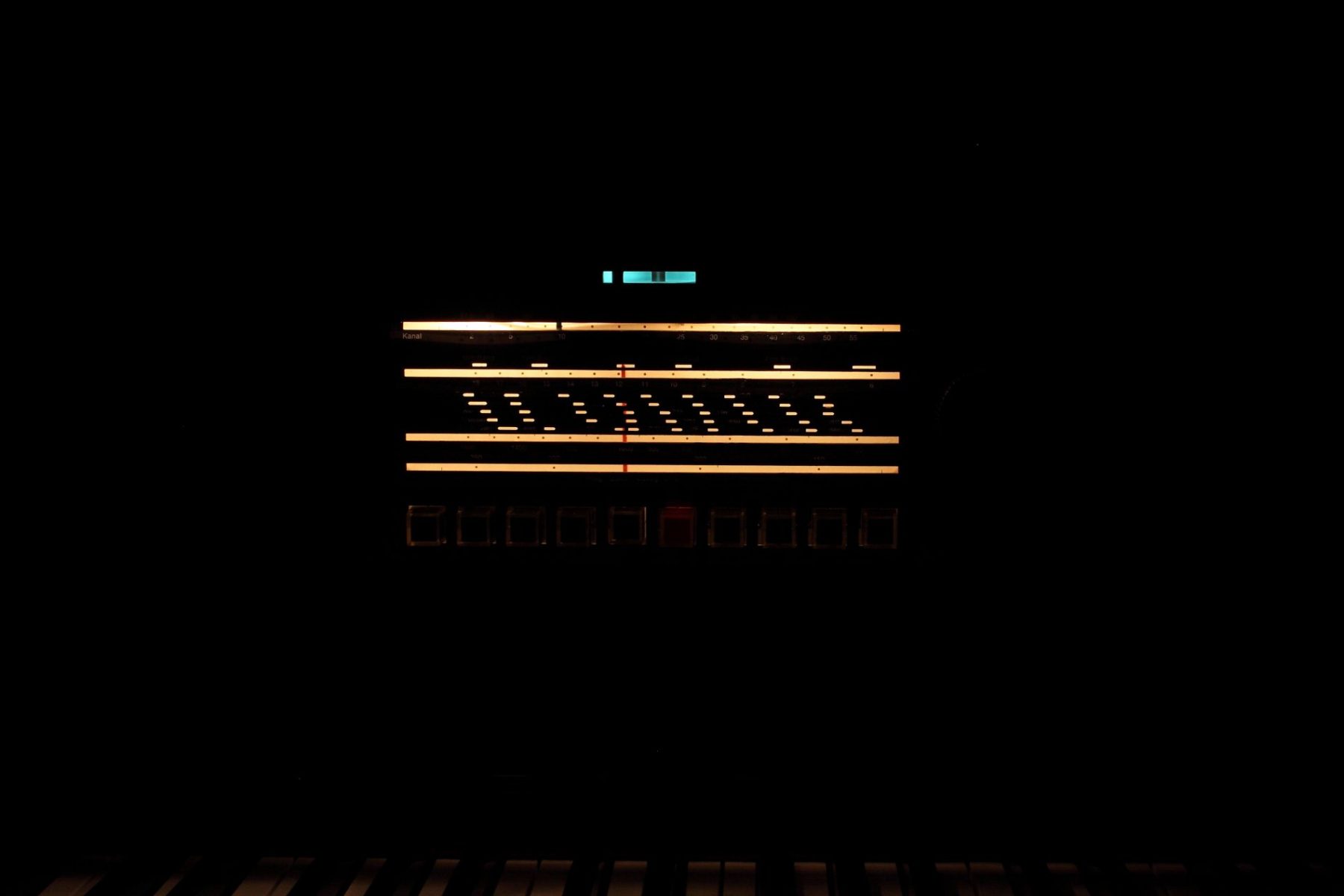
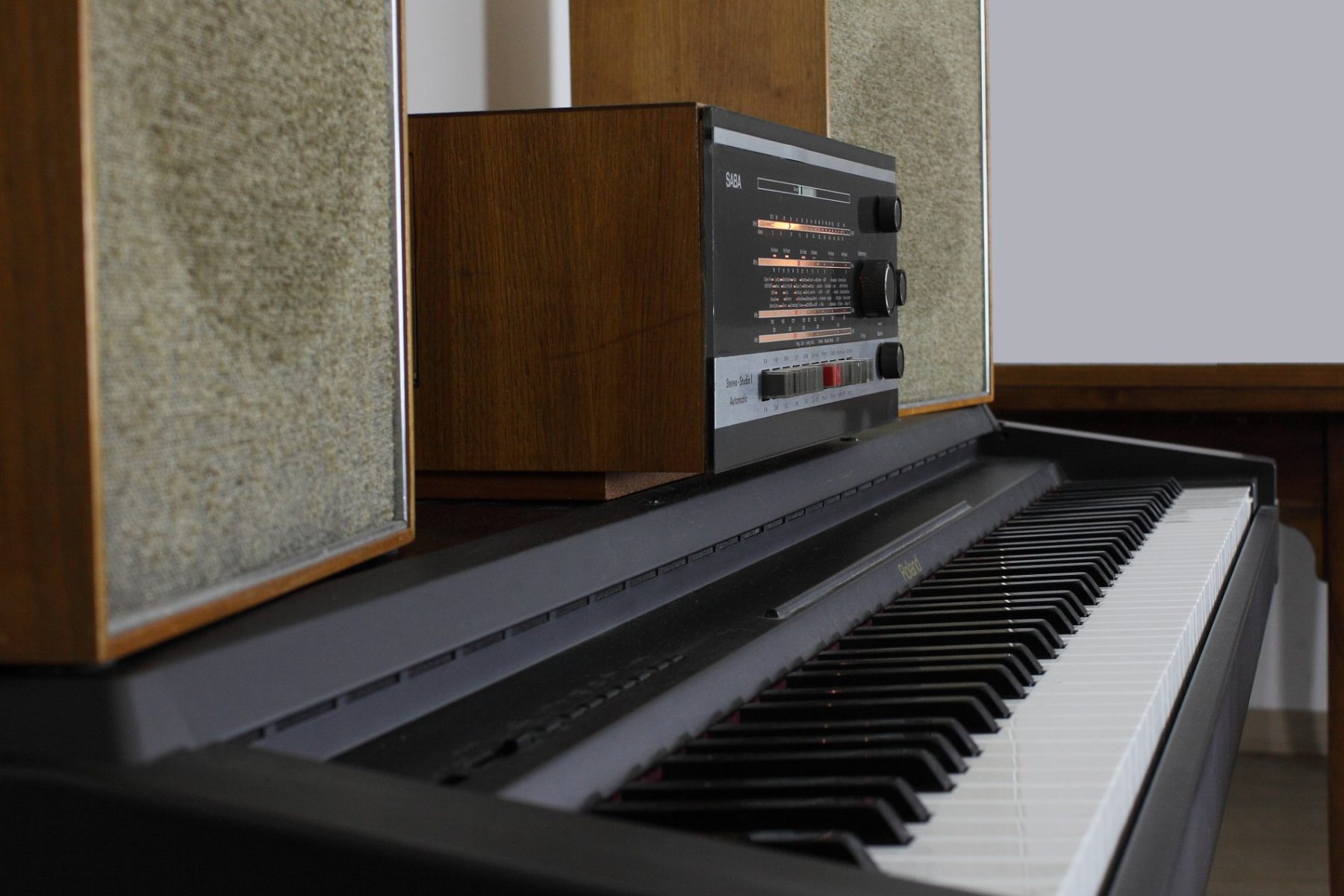

Saba Studio I is the latest Saba receiver built entirely with tubes, apart from the multiplexer. The next devices will have tube tuner section but solid state amplifier stage. A few years later the devices will be completely solid state.
This receiver constitutes an element of break in Saba's production. It sanctions the transition from a design that had remained unaltered from 1953 to a modern, essential and functional idea of industrial design.
The classic canons in the front panels of the German receivers are abandoned, like the windows with the tone controls indication, the tone knobs placed on the keyboard, the knobs symmetrically arranged on the sides of the dial glass etc.
The commands are grouped in the right side of the front panel. They are essential and simple to understand and use. They are also simple to build, which leads to a reduction in the risk of failure.
All the following devices will adopt this rationalization of the front, whose design philosophy will remain valid until the introduction of touch-control displays.
A second break with the past is the engineering oriented to the compaction of the elements.
Everything on this machine has been designed to reduce its size. This is a result that is difficult to obtain on a top range device.
Unfortunately, the restoration of this device was particularly complex due to the need to dismantle many components and entire schede in order to access the circuit sections in question.
The final stage uses excellent ECC808 double triode as preamplifiers and ECLL800 double pentode and triode as final tubes.
Also the radio section uses all multiple tubes, in order to contain the overall dimensions.
The Automatic Frequency Control is very efficient, in fact the frequency stability of this device is well known.
The sound is sweet and well defined, especially thanks to the large output transformators that do not saturate even at high levels of listening.
But the most important advantage is the use of separate loudspeaker boxes. First the cabinet is much more compact, and this makes it easier to place it in the room, second because it is possible to pair the device with the most suitable loudspeakers and place them in the most appropriate way for ideal listening.
These possibilities that the receivers offer, including the Saba Studio I, are very important. If well used they can radically change the sound of a system.
I quote the indication I gave in the description of Saba Freiburg Studio A, as I consider it very important.
Do not place the electronics between the two loudspeakers.
In the pictures the receiver is in the middle of the two loudspeakers, are exclusively for photographic needs.
In a real configuration it must be placed on one side.
Listening to music is a total experience and captivates other senses beyond hearing. Try to listen to a track in the dark and then listen to the same track in the light in your home. Also, listen to the same track used as a soundtrack watching a film. Lastly, try to listen to the same track once more watching the video of the concert.
In all these cases, and in many other situations, the brain will detect and develop sound in different ways. It will create different feelings even though we are listening to the same track.
Placing the electronics in the middle of the loudspeakers distorts our perception of the sound.

Bluetooth receiver embed
Each radio is equipped with a cable for connection to any digital device.
- Bluetooth receiver embed - The unit is equipped with a BLUETOOTH receiver powered directly by the receiver power supply. This makes it possible to control the amplifier from any external digital device as an IPAD, a Smartphone, or a sophisticated multimedia station. So you can hear your preferred web station or your lossesless file without cables on the room. Wireless Receiver can be equipped upon requests.
– Multi Platform Connection – A customized adaptation cable to connect any digital device as Iphone, Smartphone, Laptop, CD Player etc. will be provided with this radio. This special cable suits the different impedances between the modern equipment and the receiver. Furthermore the two stereo channels flow into one without increasing the load to the input unit.


SABA is the acronym for Schawarzwälder-Apparate-Bau-Anstalt meaning engineering institute of Technological appliances of the Black Forest.
The company was founded back in 1835 by Joseph Benedikt with the initial name of Jockele-Uhren, but only in 1923 the production of radio devices began and the company went under the name of SABA.
Toward the end of the 20s SABA became famous with the well-known S35 and in the following years it became the second German producer after Telefunken. During the war SABA produced military equipment and in 1945 the company was completely destroyed by a bombing.
In 1947 the production of radio devices began again and SABA distinguished itself immediately for ist avant-garde and high- quality production.
hey also began to produce TVs (the first PAL color TV is a SABA), house appliances and medical equipment. Many Italians used to work there. The Alnico Greencone loudspeakers became popular for their linearity, power handling, constant impendence that would be employed in each Hi-Fi devices of that time.
The radio devices with motorized tuning became popular as well and SABA became the representative German brand meaning quality, reliability and detailed precision. In the 1970s the decline began. According to specialized magazines of that time not having a Japanese device at that time meant not having Hi-Fi. In the 80s Thompson took over SABA. In the 90s the other way around, having a Japanese device of the 70s meant not having Hi-Fi. They found out that they functioned with a 96% counterreaction and that a device with 0.001 db from 1 to 100 KHz extension did not necessarily sound good.
We do not trust our ears and we do trust what other people say not necessarily with a good purpose.
2007: due to insolvency SABA disappeared from the TLC (Chinese) and Thompson (French) joint venture, and SABA ceased to exist.
Year of production: 1964-65
Operating voltages: 115; 127; 220; 240 Volt.
8 AM Circuits
11 FM Circuits
Wavebands: Medium Waves (OM), Long Waves (OL), Short waves (OC), FM (UKW)
Output power: 2 x 11W
Stereo-Decoder: Saba E1
Dimensions (LHD): 390 x 180 x 315 mm / 15.4 x 7.1 x 12.4 inch
Net weight:14 kg / 30 lb 13.4 oz
9 Tubes:: ECC85 ECH81 EF89 EBF89 EMM803 2xECC808 2xECLL800

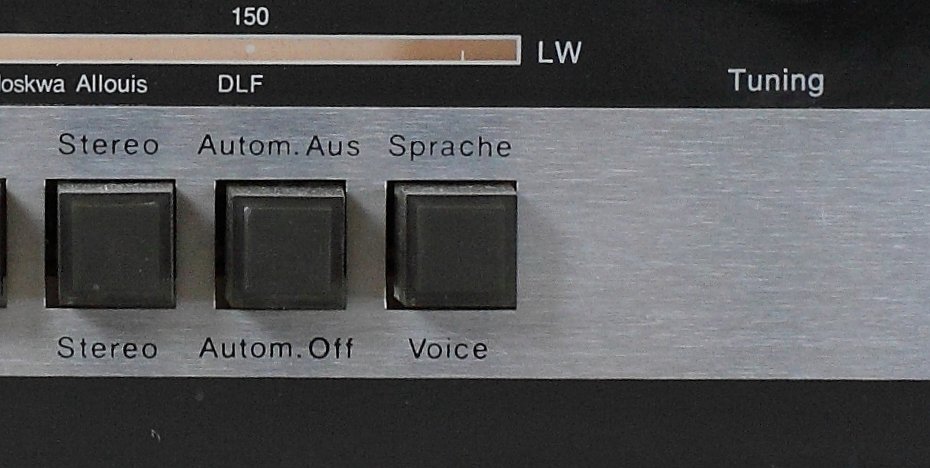
The correction system of the frequency response is made of one button, SPRACHE/VOICE.
They allow the emphasis of high and low tones while listening to music and of medium tones while listening to spoken programs.
The device is equipped with separated tuning mechanisms for AM and FM bands and for each of the FM bands.
There is only one tuning knob but the selector changes on a cable and pulley system that are separated according to the band.
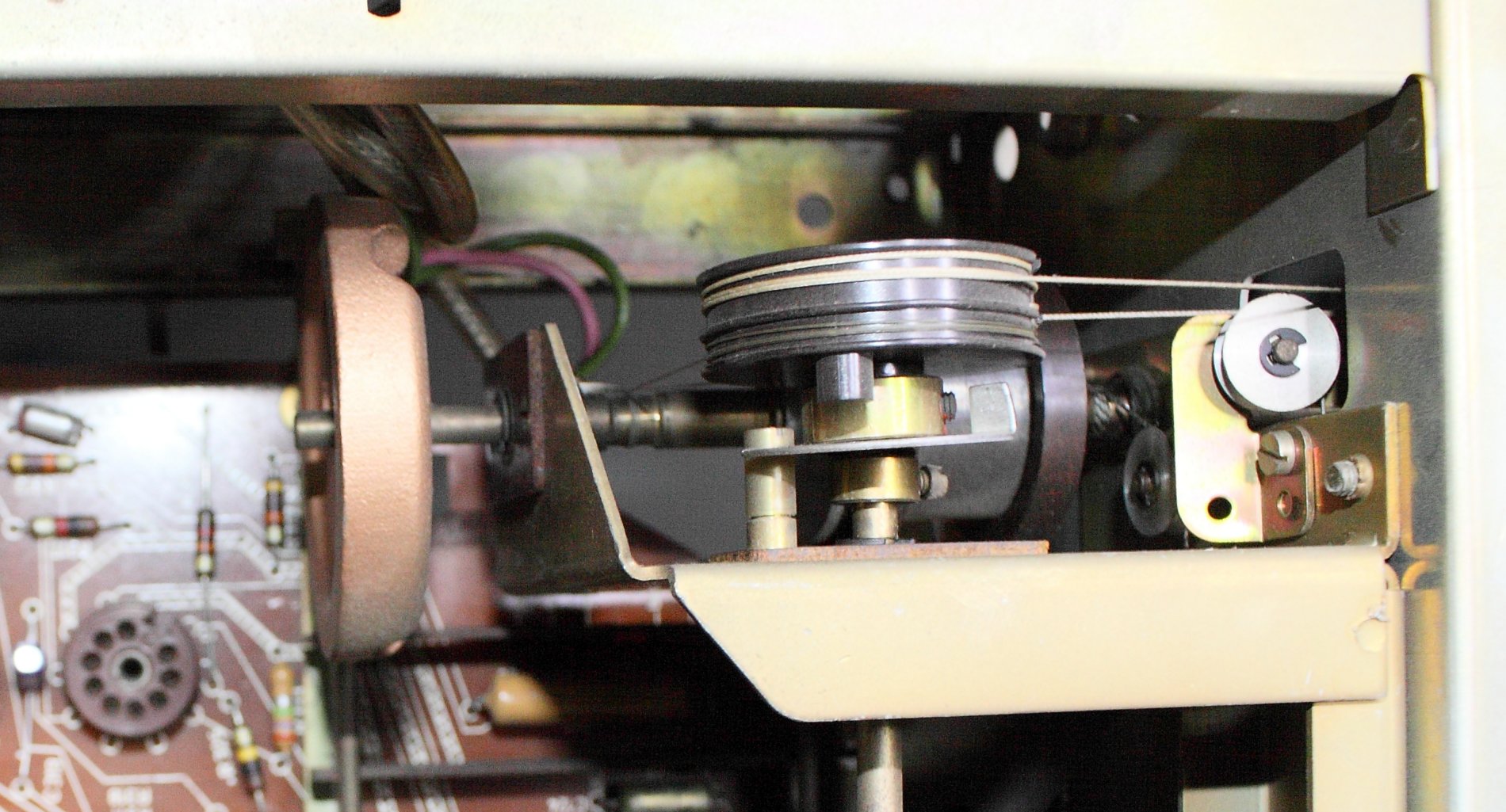

The tuning indicator is an EMM803. A tube that is rarely used and rather expensive. It is, in fact, a tuning indicator with a double display.
A section of the EMM803 is used to indicate the correct tuning of the stations.
The other section, the smaller one, is used to indicate that you are listening to a stereo station broadcasting.
Most of the radios and receivers do not have a stereo decoder, so listen in stereo is only possible when the phono input is selected.
Saba Studio I Automatic, instead, is equipped with the Saba E1 stereo decoder, so actual stereo listening is also possible in FM.
When pushed, the stereo button allows the listening and reception of FM stations in stereo.
If you are listening to an FM station that is broadcasting in stereo, this button inserts the stereo decoder, and the left and right channels work separately.
If the button is not pushed (mono) the input of the two channels is shorted, then the left and right channels process the same signal.

This unit is equipped with its original speakers and original packaging.
Here a list with the characteristics declared by the manufacturer:
SABA HI-FI Lautsprecherbox I
2 way Infinite Baffle Speaker
1 Tweeter 8x15 cm
1 Mid-Woofer 18x24 cm
Frequency response: da 65Hz a 16 kHz
Average Power: 15W
Max Power: 20W
Impedance 5 Ohm
Internal Box Volume 12 l
Measurements: 36 x 22 x 20,5 cm/14.2 x 8.7 x 8.1 inch

The keys have an indication of their function in German (line above) and in English (line below).
They have respectively the following functions:
FA - Ferrite Antenna insertion for Medium and Long Waves
KW - Shortwave
MW - Medium Waves
LW - Long Waves
UKW - FM
EIN-AUS - On / Off
Phono - Turntable / Aux Input
Stereo - Stereo / Mono switch
Autom.Aus - AFC insertion in FM (Automatic Frequency Control)
Sprache - Music / Voice switch
On the right side all the controls are placed
The first knob at the top (Hohen / Treble) is the treble one
Below we find the big tuning knob (Abstimmung / Tuning)
At the side you can see the volume knob (Lautstarke / Volume)
Coaxial with the volume knob you can see the left and right channel balance lever (Balance)
Below we find the low tone control knob (Tiefen / Bass)
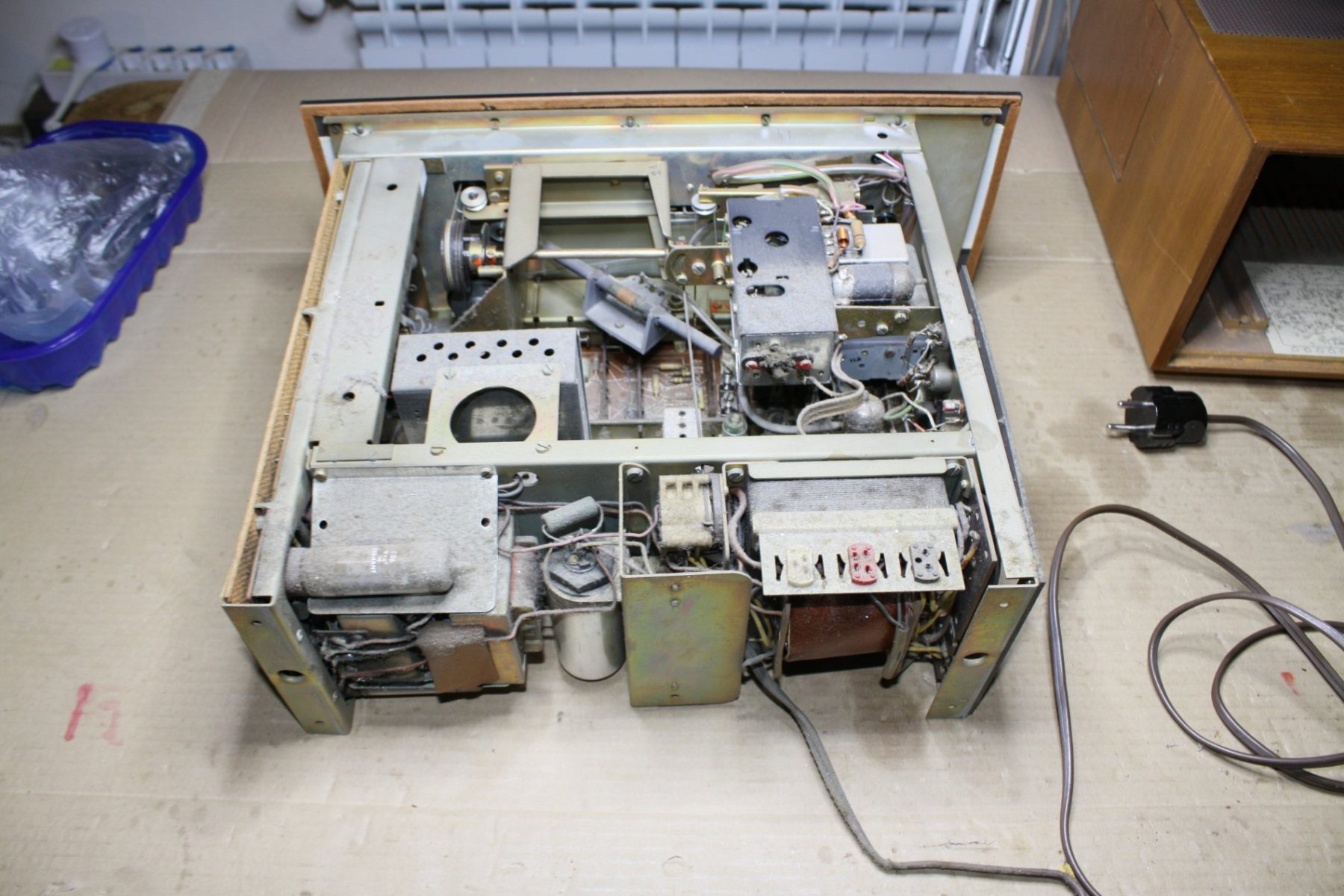





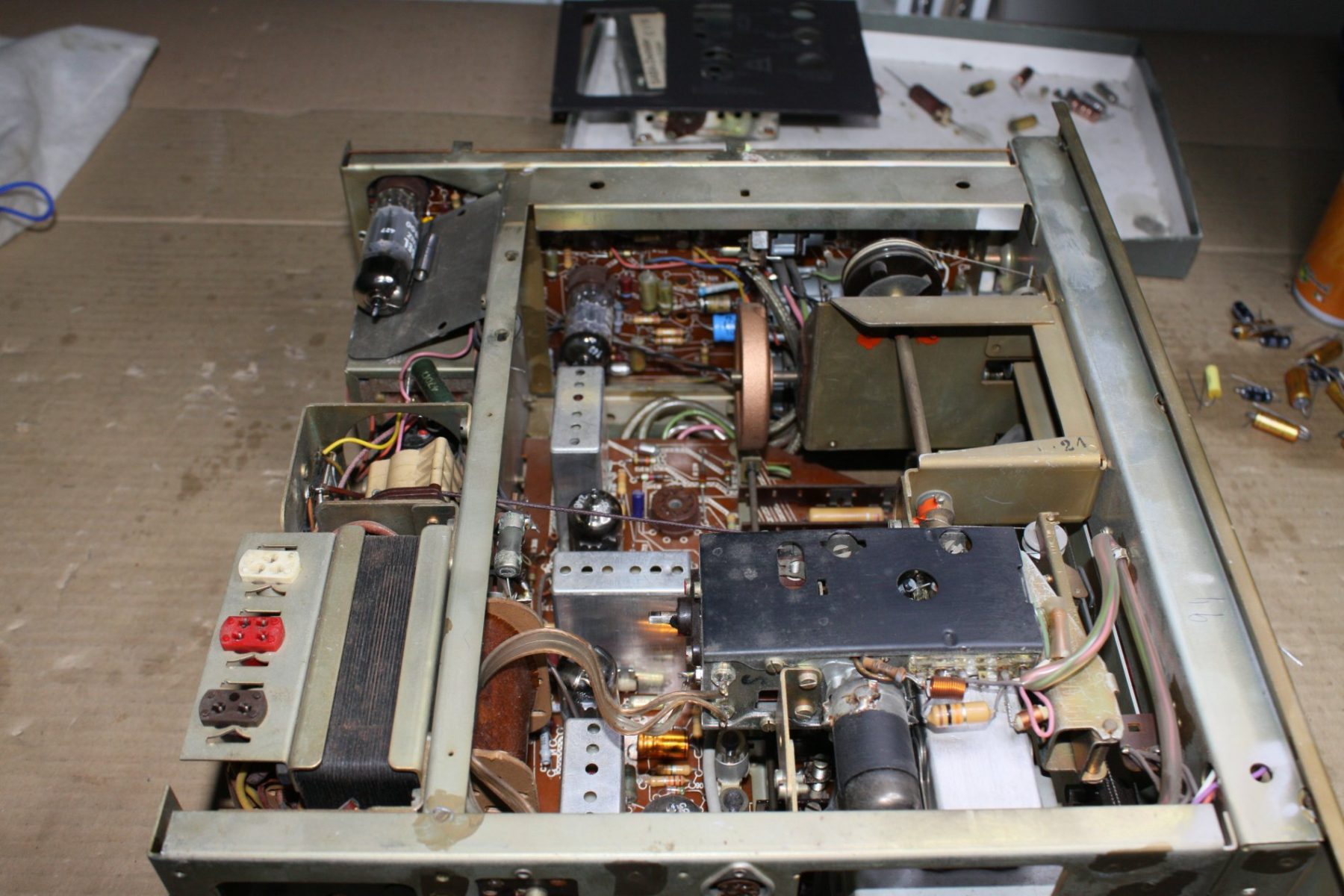
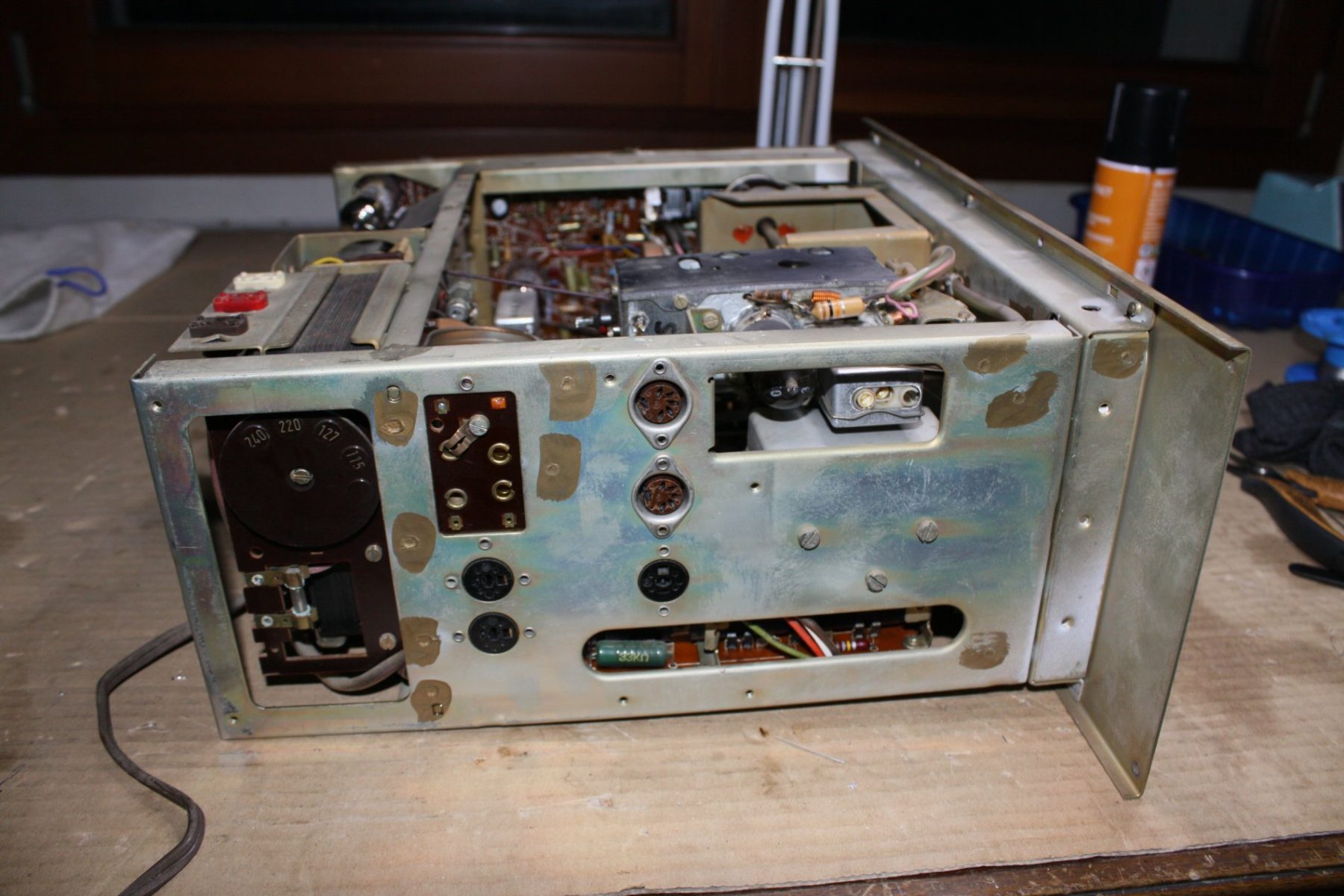

 922 - cn
922 - cn

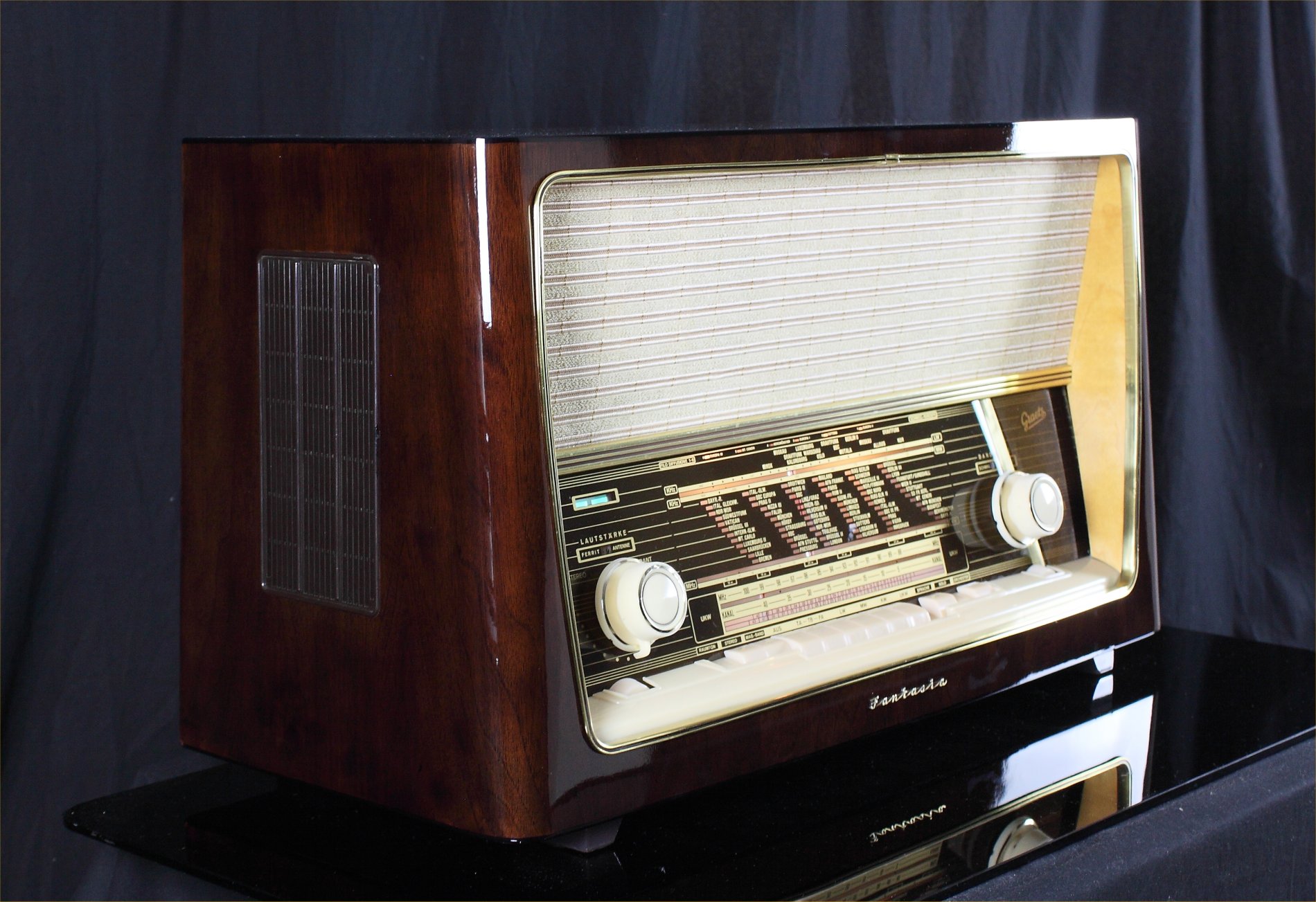
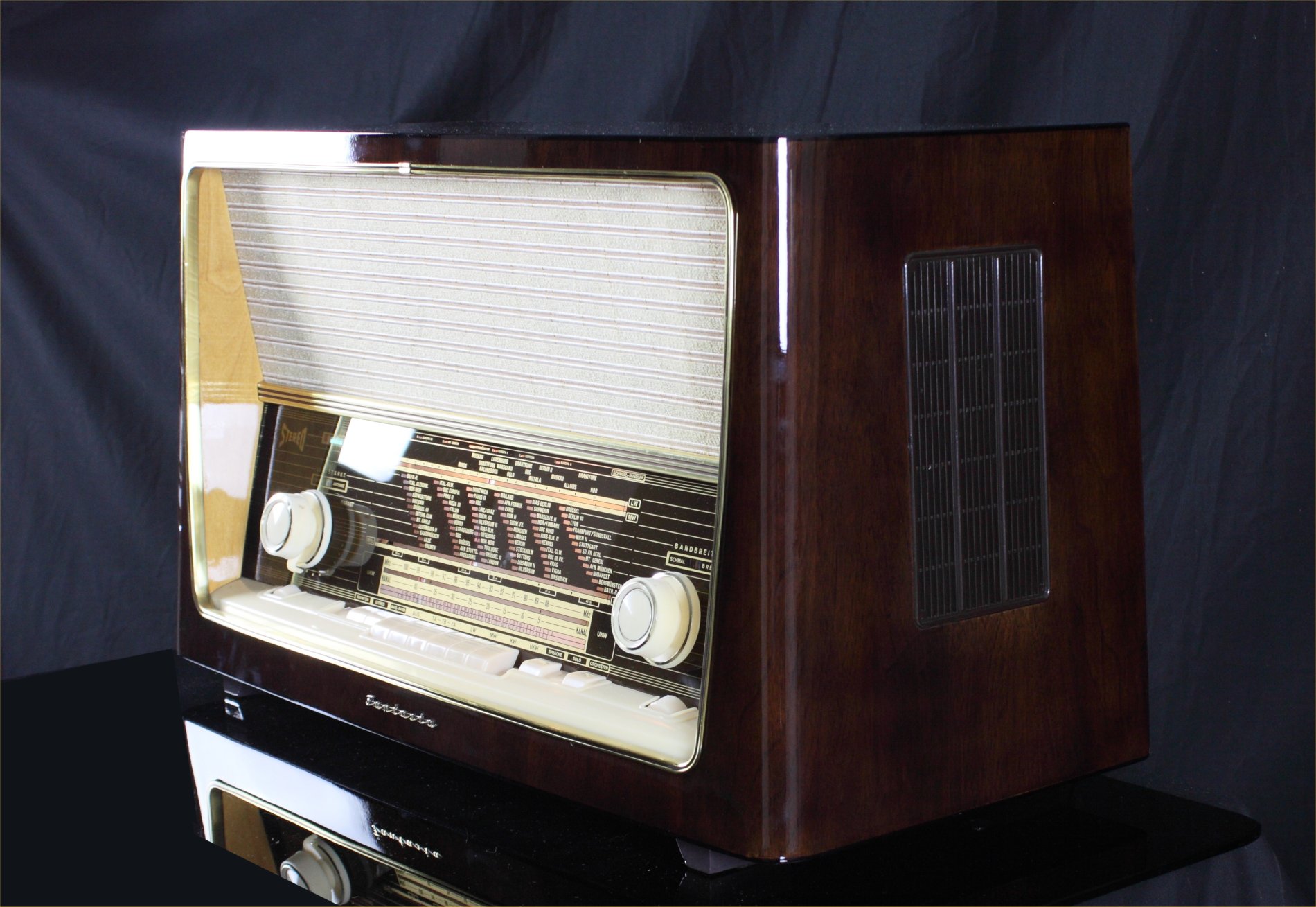


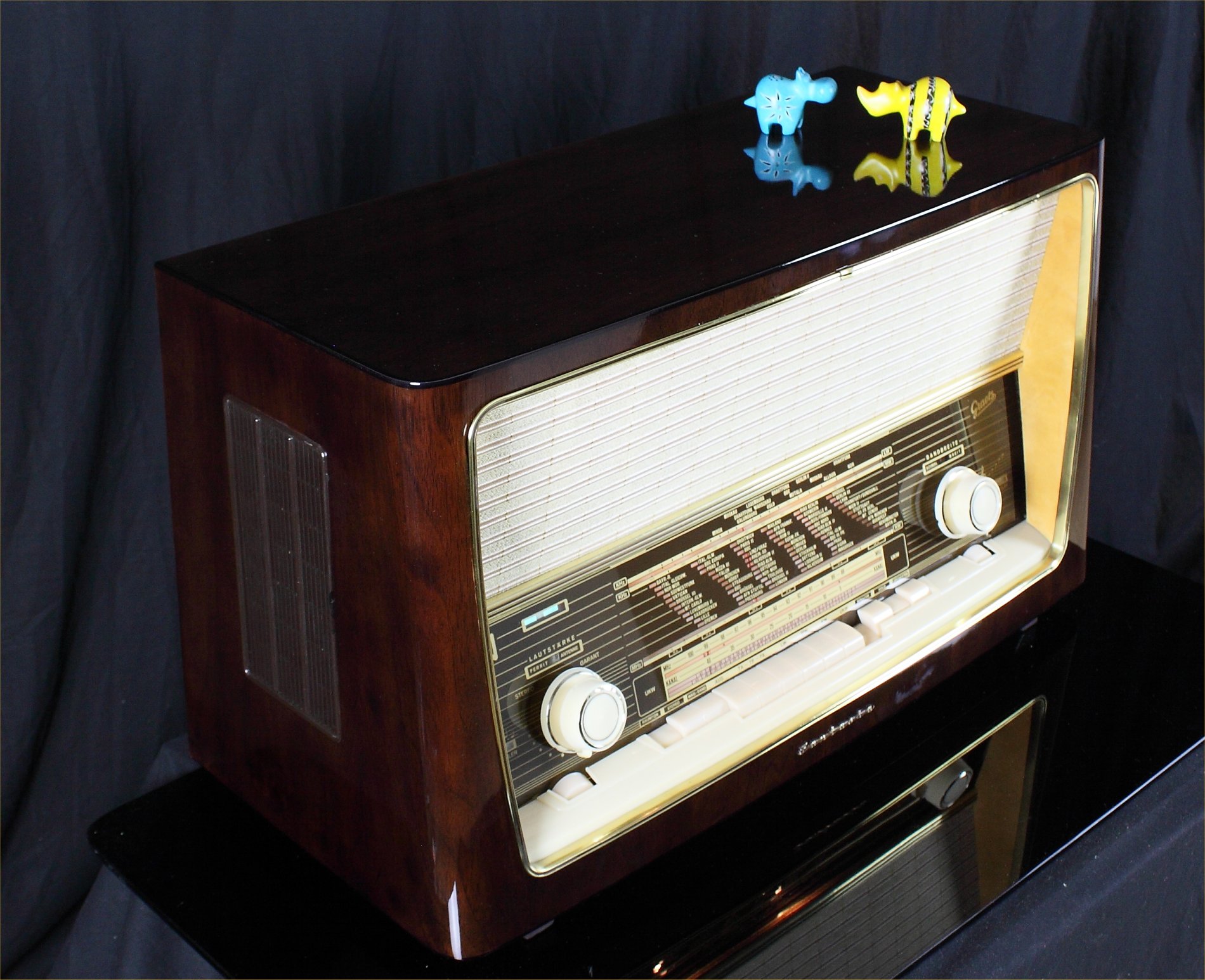





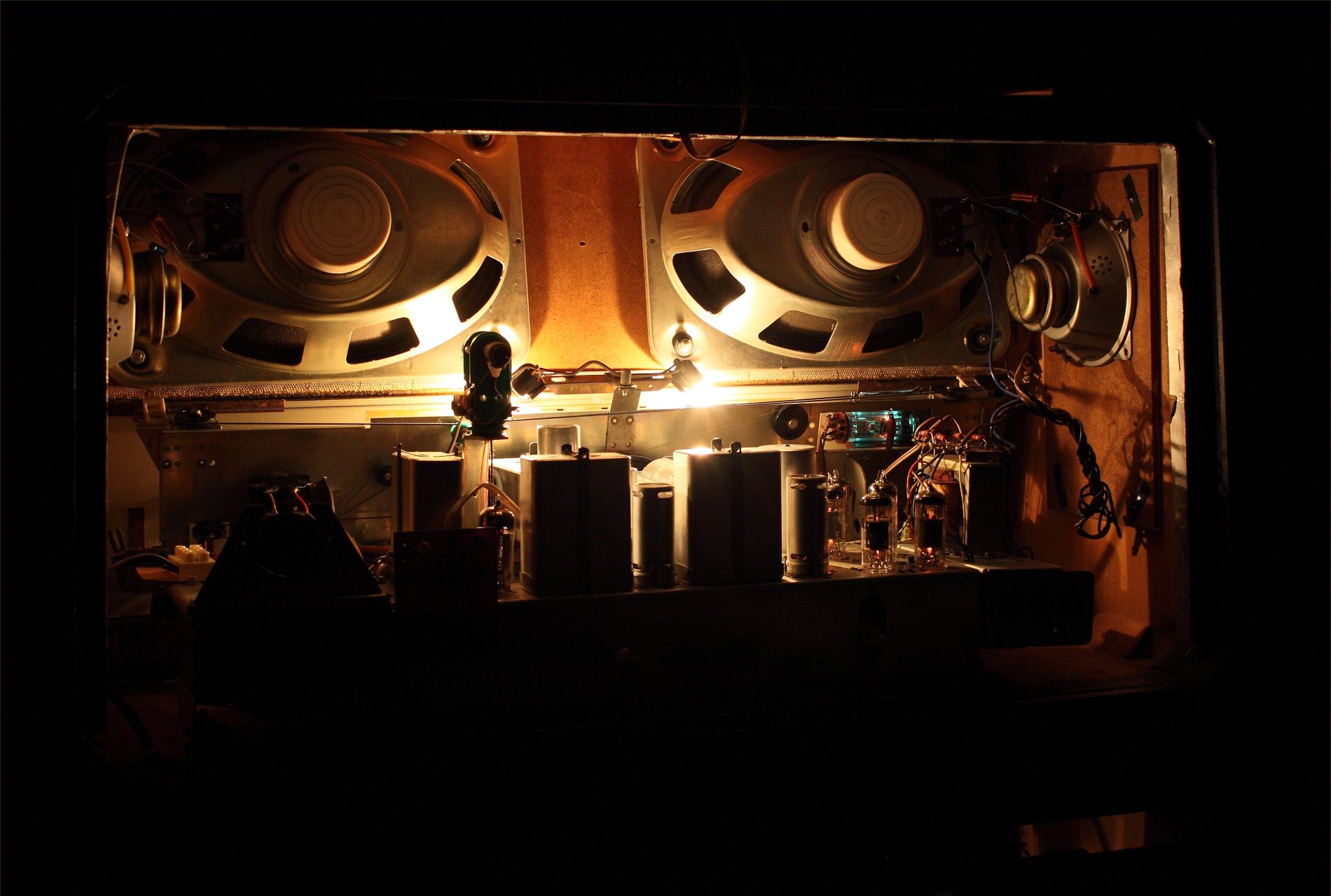
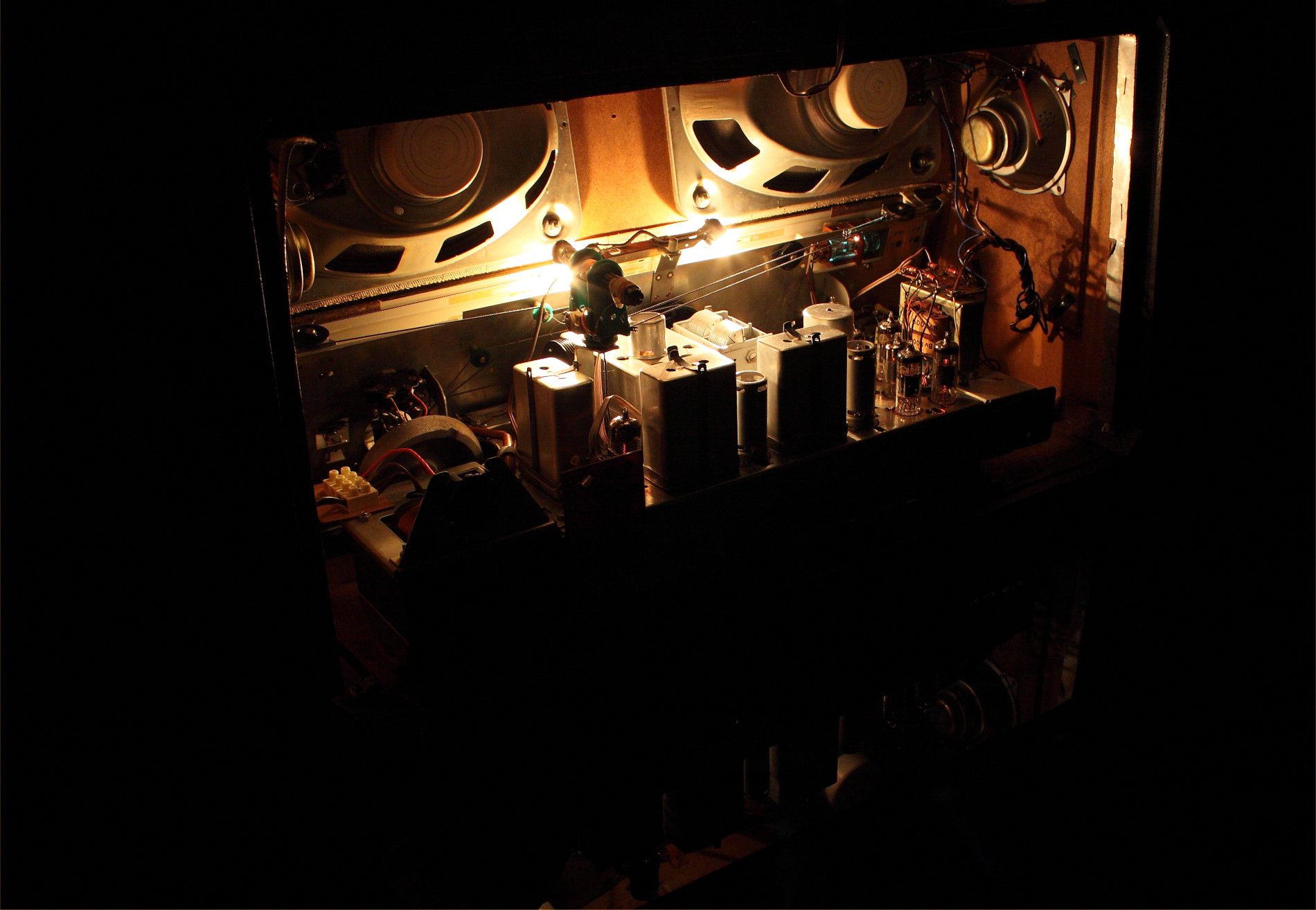

Graetz is one of the most prestigious German radio manufacturers. The Graetz Fantasia 922 Luxus - Stereosuper was the flagship model in 1960.
Graetz devices have always been appreciated for their refined and elegant finish, as much as for the innovative acoustic solutions and their respective patents.
In designing the line of their flagship model, Graetz designers chose a classical and statuary kind of elegance.
The cabinet is in dark wood and the paint is very shiny. The sides with their variable width make the profile look slimmer. The base looks wide and solid, without making cabinet look heavy.
The strongly embossed texture of the canvas covering the speakers, the golden lines highlighted on the dark display and the light knobs make the visual impression even more pleasant and lively.
The stylistic attention, as in Graetz's tradition, is very accurate.
The Amplifier Section is the best that could be imagined at the time.
The Volume potentiometer has two sockets for loudness (red). As known, in fact, when listening at a very low volume the bass frequencies and the treble are not perceived with the same sound intensity as the mid, which appear to be predominant.
The loudness modifies the response of the preamplifier stage specularly to the Fletcher-Munson curves. This allows to maintain the correct perception of the sound, even at low volume levels.
The Tone Control was designed using the complex Baxandall circuit (green). The advantage of such circuit is its high precision, while the disadvantages are its cost and construction complexity. Much simpler and cheaper circuits were normally used. But not in this device.
The Balance (pink) is inserted into the feedback circuit. It works by changing the percentage of signal that is downgraded/relegated to each of the two channels. This signal is in inverted phase compared to the main signal. In this way, by acting on the balance, the level of one channel is lowered in comparison with the other and, at the same time, the distortion is reduced.
By turning the knob at the ends, this type of balance does not cause a reset of the volume of the channels as in the modern balance control, but it is to be considered a “fine” adjustment of the level between the two channels.
The Phase Inverter (blue) is of the Catodina type. As an advantage, it is very well-balanced. This circuit is still used in hi-fi amplifiers.
The Push-Pull section (blue) uses two separate tubes (EL95) for each channel. The EL95 are pentodi expressly designed for audio use.
In the receivers, even high-class, provided with Push-Pull output power, bulbs were normally used, which enclosed multiple valves (ELL80, ECLL800). In this way, space and components were saved. But if one of the pentods inside thei complex tube decays differently, the reproduction is altered, with an exponential increase in the crossover distortion. These multiple tubes, once common, are rare and expensive today, so the replacement can be economically significant. The use of separate pentods, as in the Graetz Fantasia 922, eliminates this problem, and it is possible to select pairs of EL95 with the same characteristics.
Only the Graetz Fantasia 922 and 1022 and the Telefunken Opus 2430/2550 use 4 x EL95 in the stadio finale.
The Tuner Section is also very well taken care of.
The most interesting feature is the high selectivity of this device, due to the twin IF stage. The two EF89 pentods and the numerous IF transformers, in fact, are visible in the photos.
In FM an additional transformer has been implemented, accordato all'interno del convertitore in order to make more stable and insensibile ai disturbi the reception of such frequencies.
Finally, the L0udspeakers set.
The Graetz 922 Luxus features 6 loudspeakers. Four are placed frontally and two on the sides.
The four front loudspeakers are two tweeters and two oval wideband. The tweeters are placed in front of the wideband, on the same axis. This particular arrangement has the great advantage of making the origin of the sound close to that produced by a point source.
This characteristic corresponds to a very linear scatter diagram, and therefore to a much more regular realistic sound image than if the tweeters and the woofers were placed side by side.
The two loudspeakers placed on sides are, at such power level, the mid / tweeters, and allow a balanced listening from any position with respect to the radio, frontally or sideways.
This last feature makes the device very enjoyable as for daily listening. You will no longer want to turn on the HI-FI system ...

Bluetooth receiver embed
Each radio is equipped with a cable for connection to any digital device.
- Bluetooth receiver embed - The unit is equipped with a BLUETOOTH receiver powered directly by the receiver power supply. This makes it possible to control the amplifier from any external digital device as an IPAD, a Smartphone, or a sophisticated multimedia station. So you can hear your preferred web station or your lossesless file without cables on the room. Wireless Receiver can be equipped upon requests.
- Multi Platform Connection - A customized adaptation cable to connect any digital device as Iphone, Smartphone, Laptop, CD Player etc. will be provided with this radio. This special cable suits the different impedances between the modern equipment and the receiver. Furthermore the two stereo channels flow into one without increasing the load to the input unit.


The Ehrich & Graetz metalworks was a factory established in 1866 in Berlin by Albert Graetz (1831–1901) and the tradesman Emil Ehrich (died 1887) under the name "Lampen-Fabrik Ehrich & Graetz OHG" (E&G).
By 1897 the firm was controlled by Albert's sons, Max Graetz, and Adolf Graetz. The company grew rapidly, and in 1899 factory complexes were built in Berlin, in the United States, France, the UK, and Bombay.
Around 1910-1916 Max Graetz developed the famous Petromax Lantern. Around 1925 the factory also produced radios, and other electrical appliances under the name Graetzor.
In the Second World War, just as in the First World War, the company was part of the war industry. With the use of forced laborers from France, Russia and the Netherlands the company made huge gains in production.
At the end of April 1945 the factory was claimed by the Russian army.
In 1949 the firm became part of the "peoples" program, "VEB-VolksEigenerBetrieb" and since 1950 "VEB Fernmeldewerk, Berlin Treptow (RFFT)." VolksEigenerBetrieb, means that the factory was owned by the people for the people (Communism)
In 1948 Erich, and Fritz Graetz founded a new company in Altena, Germany known by the name The Graetz Firm, which was successor to the lost family company in Berlin. The new company produced mainly radios and televisions.
In 1961 the company was then sold to Standard Elektrik Lorenz (SEL) AG, but since 1987 has been to the present owned by the Finnish company Nokia.
Year of production: 1960/61
Superheterodyne IF 460/10700
8 AM Circuits
13 FM Circuits
Wavebands:
Medium Waves(OM), Long Waves (OL)
Short waves (OC), FM (UKW)
Loudspeakers:
2 Elliptical mid-woofers
4 Cone mid-tweeters
Dimensions (LHD): 680 x 395 x 310 mm / 26.8 x 15.6 x 12.2 inch
Net weight: 17 kg / 37 lb 7.1 oz
13 Tubes: ECC85, ECH81, 2 x EF89, EM84, EABC80, 3 x ECC83, 4 x EL95


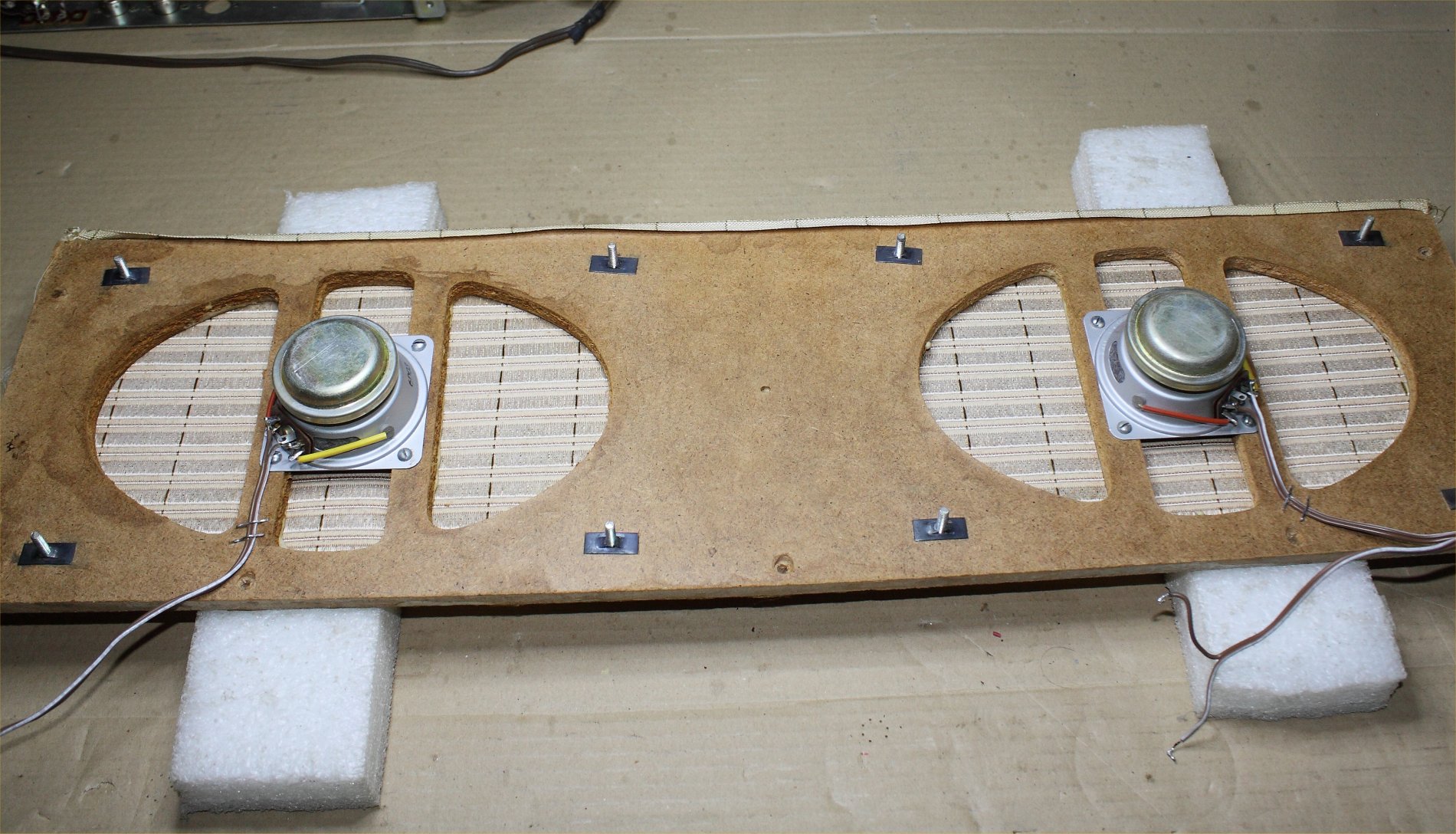

As previously mentioned, the most luxurious model produced by Graetz in 1960, the Fantasia 922, features 6 permanent magnet speakers.
The low and middle notes are reproduced by two large conical speakers, elliptical 26x17 cm.
High-pitched notes are reproduced by four cone loudspeakers. Two measuring 10 cm and two 6cm.
From the acoustic point of view, the interesting thing is not only the number of loudspeakers, but also their placement. The two 6 cm tweeters, in fact, are attached to the frontal Mid/Woofer, in a concentric position.
This is always my favourite placement and it is used in many of the best modern diffusers, such as KEF, TAD and Tannoy and many more.
The main advantage of a coaxial is the linearity of the off-axis response, both on the horizontal and vertical plane.
With the traditional positioning of the loudspeakers, the mid/woofer next to the tweeter, the off-axis listening is consistently disturbed by the phase cancellations caused by the length differences of the route between the two drivers.
The 3D graphics on the side display the measurements off the vertical axis of a box with coaxial loudspeaker KEF LS50 and one with traditional positioning of the YG Anat III. The difference is noticeable. (source: www.acousticfrontiers.com )
While frontally such an excellent configuration was used, what was done laterally is no less. In fact, on each side was installed a cone tweeter, protected by a metallic dome, Isophon HS10.
This loudspeaker has a very wide frequency response, from 1.000 to 20.000 Hz. So that all frequencies with pretty strong directivity features are reproduced also laterally.
The response to low frequencies is entrusted to the big frontal elliptics. In fact, low-frequency waves – as they are not directive by nature – do not need lateral loudspeakers in order to be perceived.
With this set of loudspeakers placed as described, the response is clearly quite linear from all angles, frontally, laterally and three-quarter.
As they are loudspeakers with an Alnico magnet, they are very efficient. The 7 Watts of each of the two channels are transformed into a noticeable acoustic pressure.
To provide a reference, during the listening at “normal” volume, not bothersome, a 0,2 Watt power delivery on the loudspeakers is measured.
The sound power is thus amply sufficient to sonorize even large environments.
The use of two separate Mid/Woofers has another advantage. The cones have less inertia compared to a larger single cone. In this way, the dynamic response is quick, and the lows are curbed and without resonance.
This feature allows to make the most of the AUX-in with lossesless digital files or CD, providing a brilliant reproduction rich in dynamism.

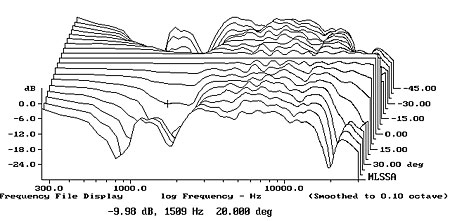
KEF LS50
vs.
YG Anat III
(fonte: www.acousticfrontiers.com )

Three keys are collected to the left of the main keyboard. The first two indicate respectively:
Raum(klang)Ton - Surround - The appliance works in MONO. It should be used when any of the keys LW, MW, SW, UK are pressed
Stereo - The appliance works in STEREO. It should be used when any of the TA, TB buttons are pressed.


The third key to the left side of the main keyboard is used to turn off the magic eye to avoid unnecessary consumption.
It must be used when the TA or TB keys are pressed and when you are tuned to a station in a stable manner and then there is no longer any interest in checking the correct centering.
Mag(isches)-Band – turns the Magical eye off

The Klangregister (Musical Register) group also consist of three buttons, which are very intuitive.
Sprache - Voice
Solo - Solo
Orchester - Orchestra
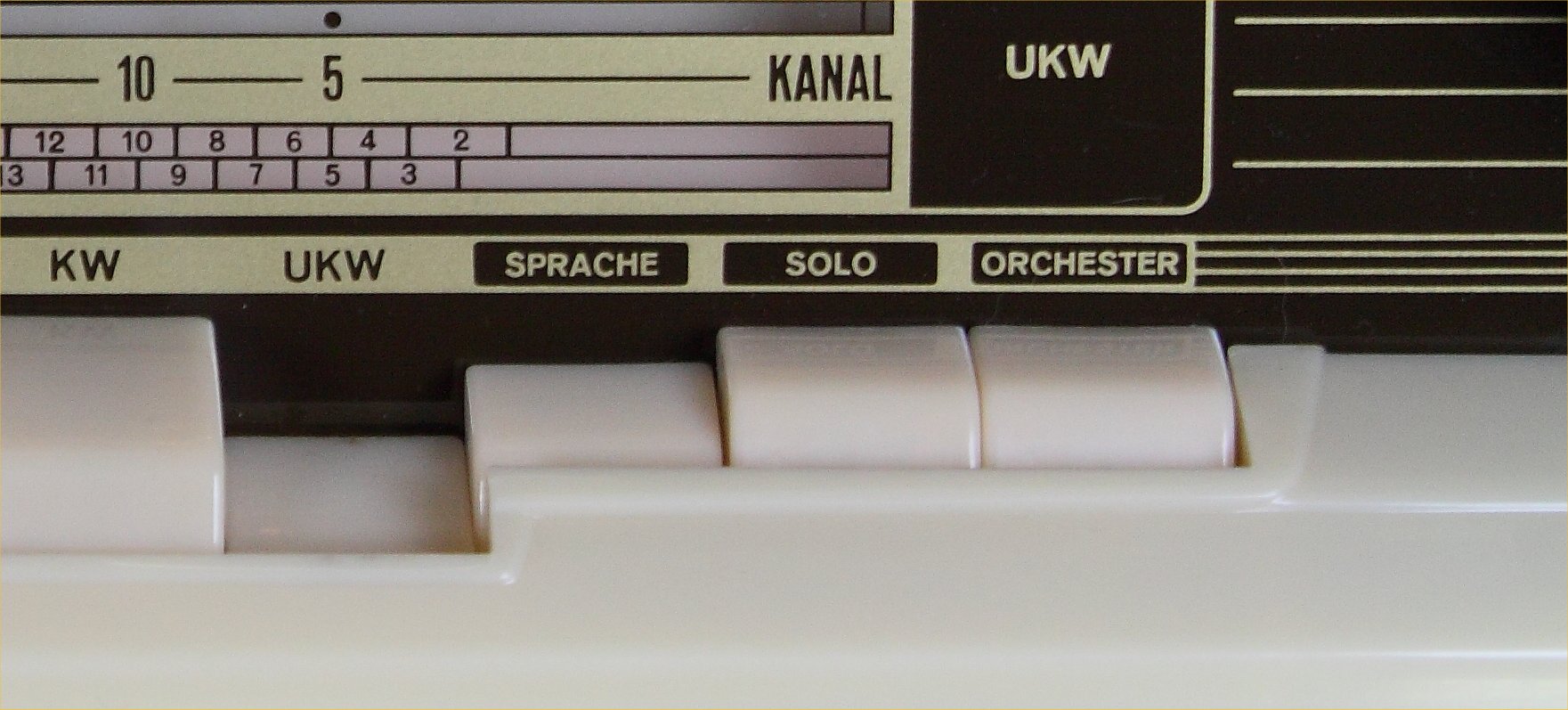
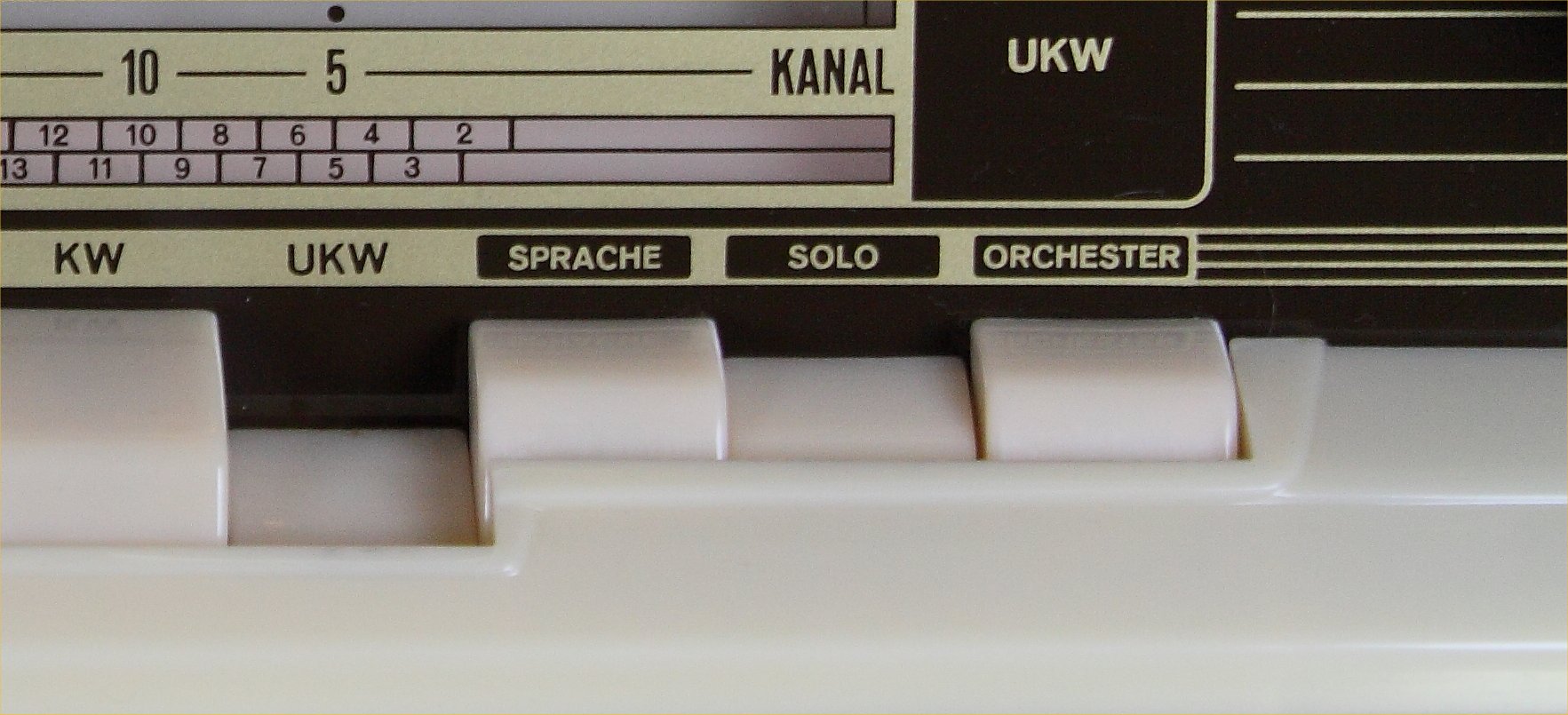
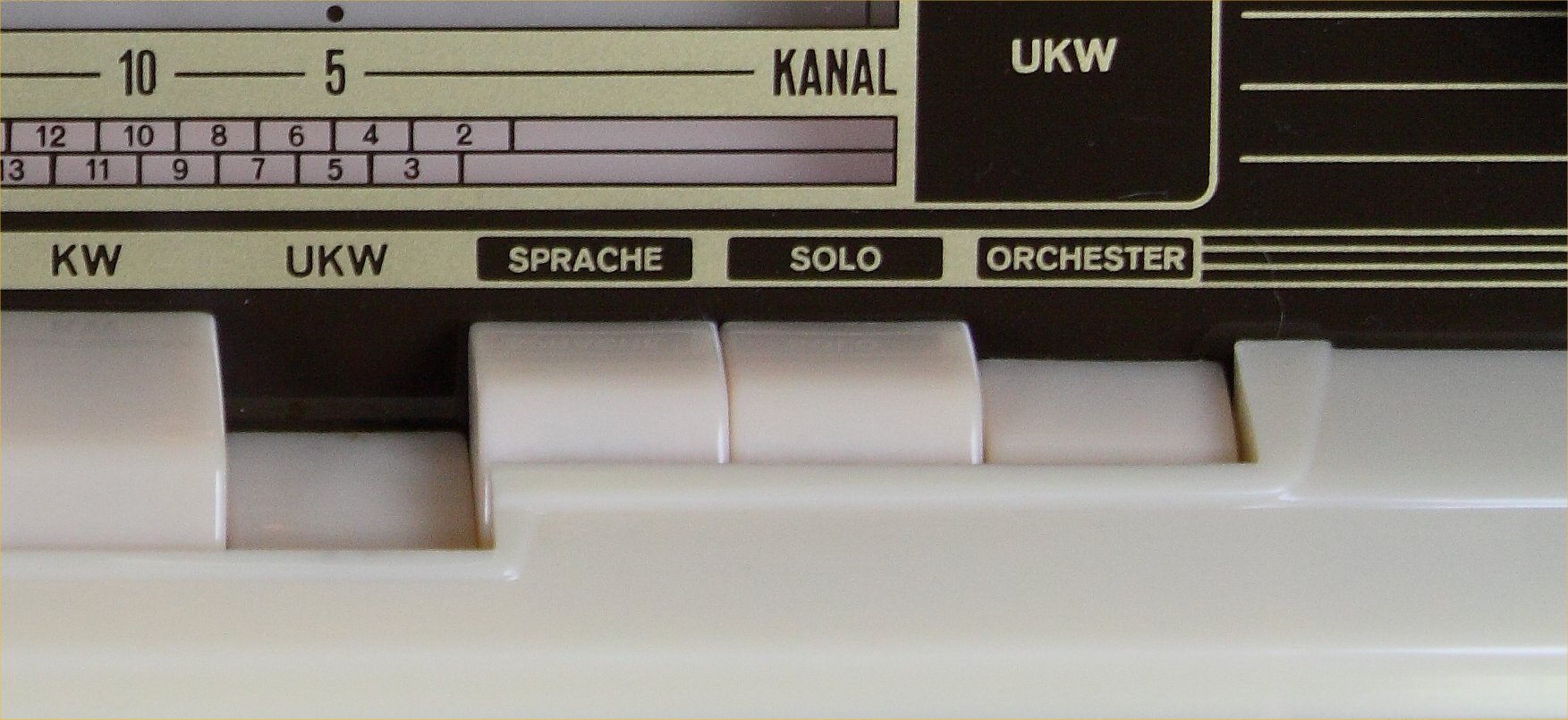
The tones control system is very efficient. Above the large tone control knobs there is a band that lights up gradually indicating the emphasis on the band on which it acts.
By pushing any of the Klangregister buttons, the tone-controls are excluded, since the frequencies connected with the chosen button are enhanced.
For this reason, the lights that enlighten the scale which indicates the tone-control position are turned off, too. They can be turned on again by pushing the Raumklang button and switching back to the manual setting of the favourite response curve.
BASS MAX

BASS FLAT

BASS MIN

TREBLE MIN

TREBLE FLAT
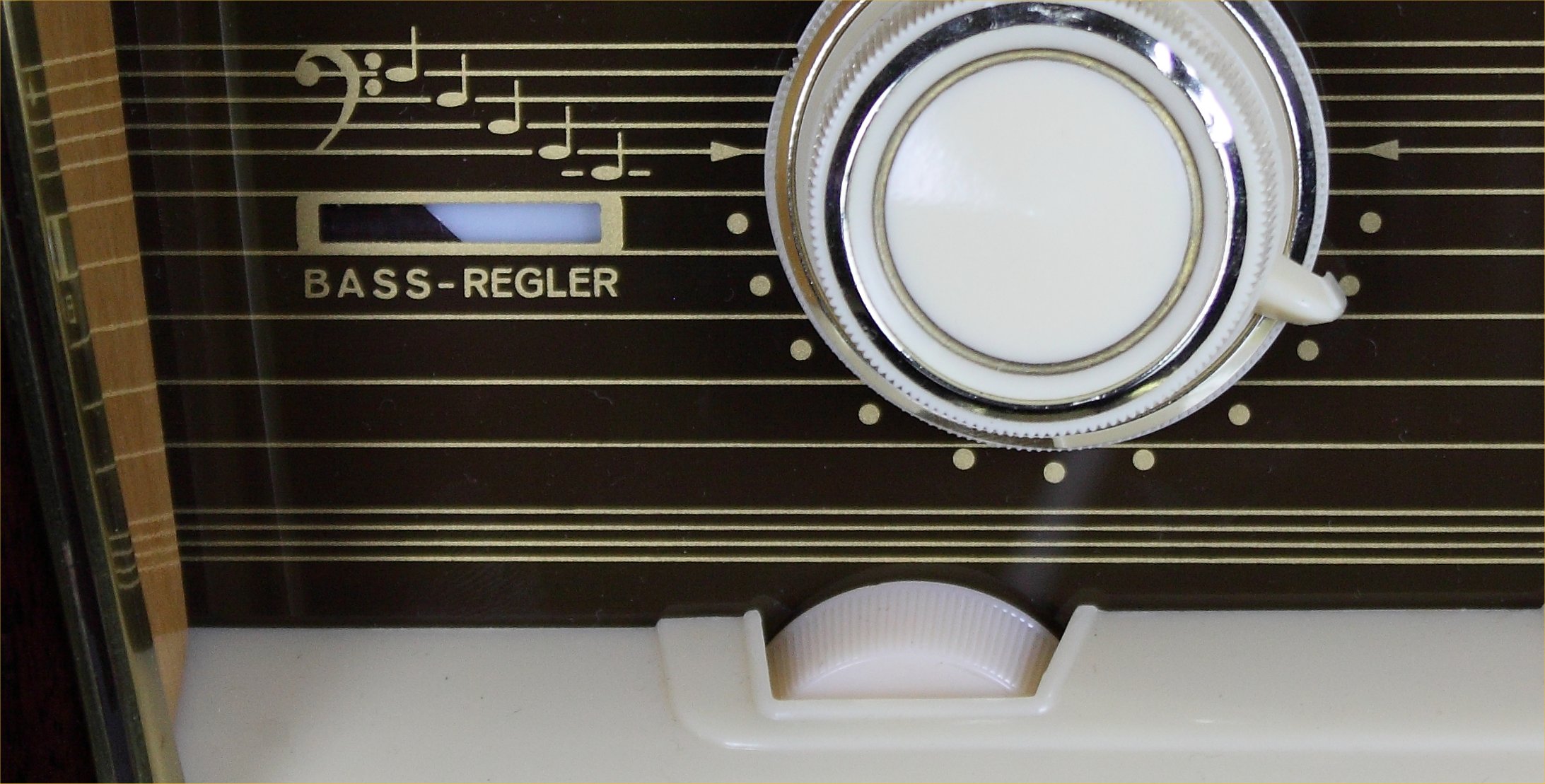
TREBLE MAX

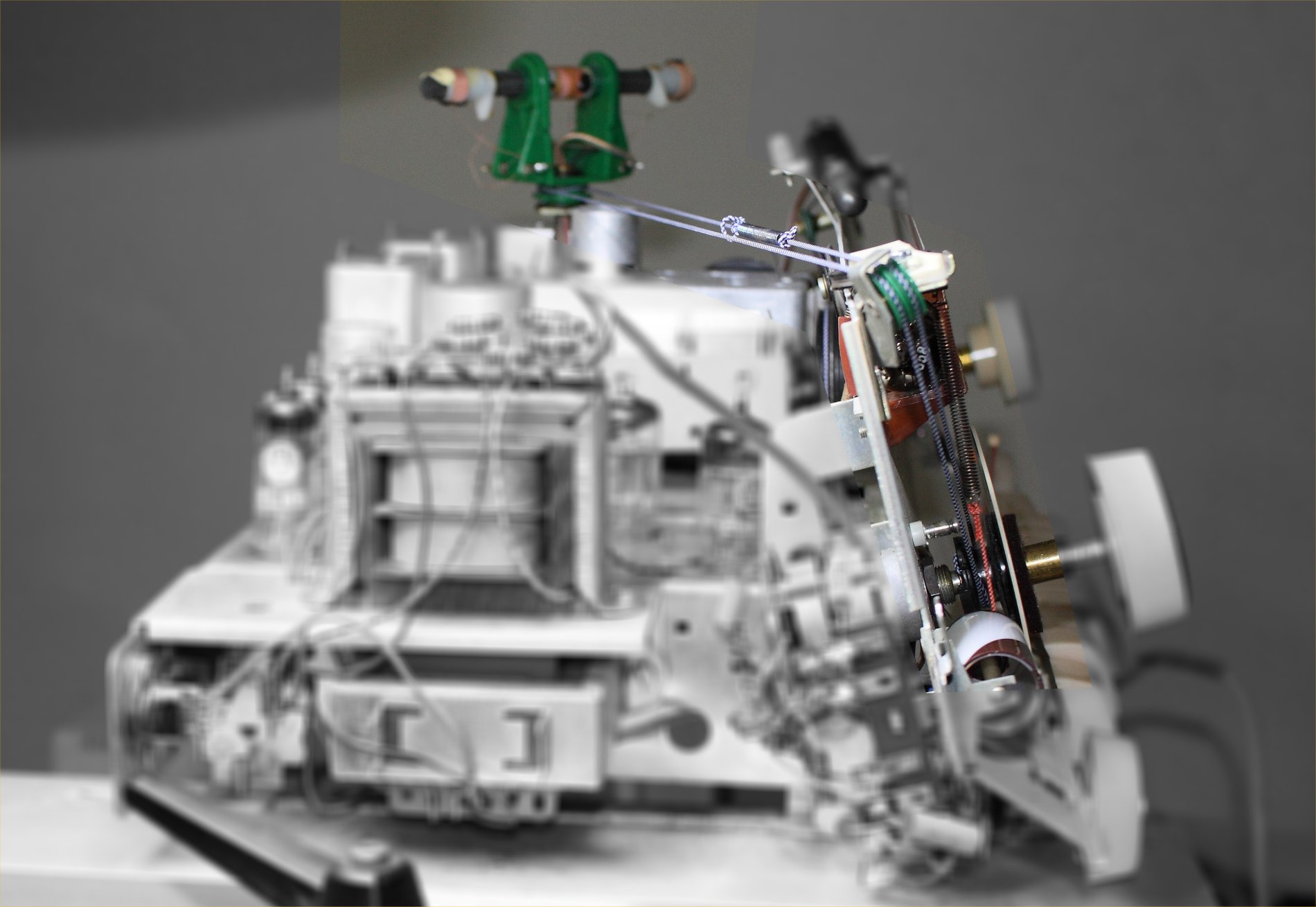
Inside the cabinet there is a dipole for FM reception and a ferrite rotating aerial for AM reception.
Ferrite aerial can be rotated from the outside to achieve a perfect tuning of the device in the AM.
In this picture you can see the rotation mechanism, and the aerial position indicator.
The reception sensitivity with internal aerials is very good. This unit was in fact produced when there were not many radio stations, and those available were far from each other.
Using an external aerial sensitivity is further increased.


The magic eye has of course been replaced.
The unit is equipped with mechanisms that keep AM and FM bands separate.
The tuning knob is single, but a selector switch commutes between cable systems (all steel made) and pulleys dedicated to each band.
The movement is transferred to both mechanisms with a system of pulleys and separated gears.











Left from the top:
- The Magic Eye that indicates the perfect tuning of each station.
- The antenna position indicator.
- The volume control (with built-in loudness)
- Axially this balancing.
- The rotation command of the ferrite antenna is still in axis.
- The bass control knob
In the center:
The AM display for long, medium, short waves and the FM display.
Right from the top:
The BANDBREITE indicator (High / Low selectivity in AM)
The tuning knob, whose movement is very pleasant being supported by a large flywheel
On the same axis there is a selector to control the selectivity in AM.
-The treble control knob.
The keyboard:
RAUMTON - Surround - Mono
STEREO - Stereo
MAG.BAND - Magic Eye
AUS - Switch off
TA - Turntables
TB (TA + FA) - Recorder
FA - Ferrite antenna for Medium and Long Waves
LW - Long Waves
MW - Medium Waves
SW - Shortwave
UKW - FM
SPREACHE - Voice
ONLY - Solo instrument
ORCHESTER - Orchestra

Output for external speakers.
Socket for recorder (tonbandgerat).
Turntable input (Tonabnehmer)
AM and FM aerial inputs and ground socket
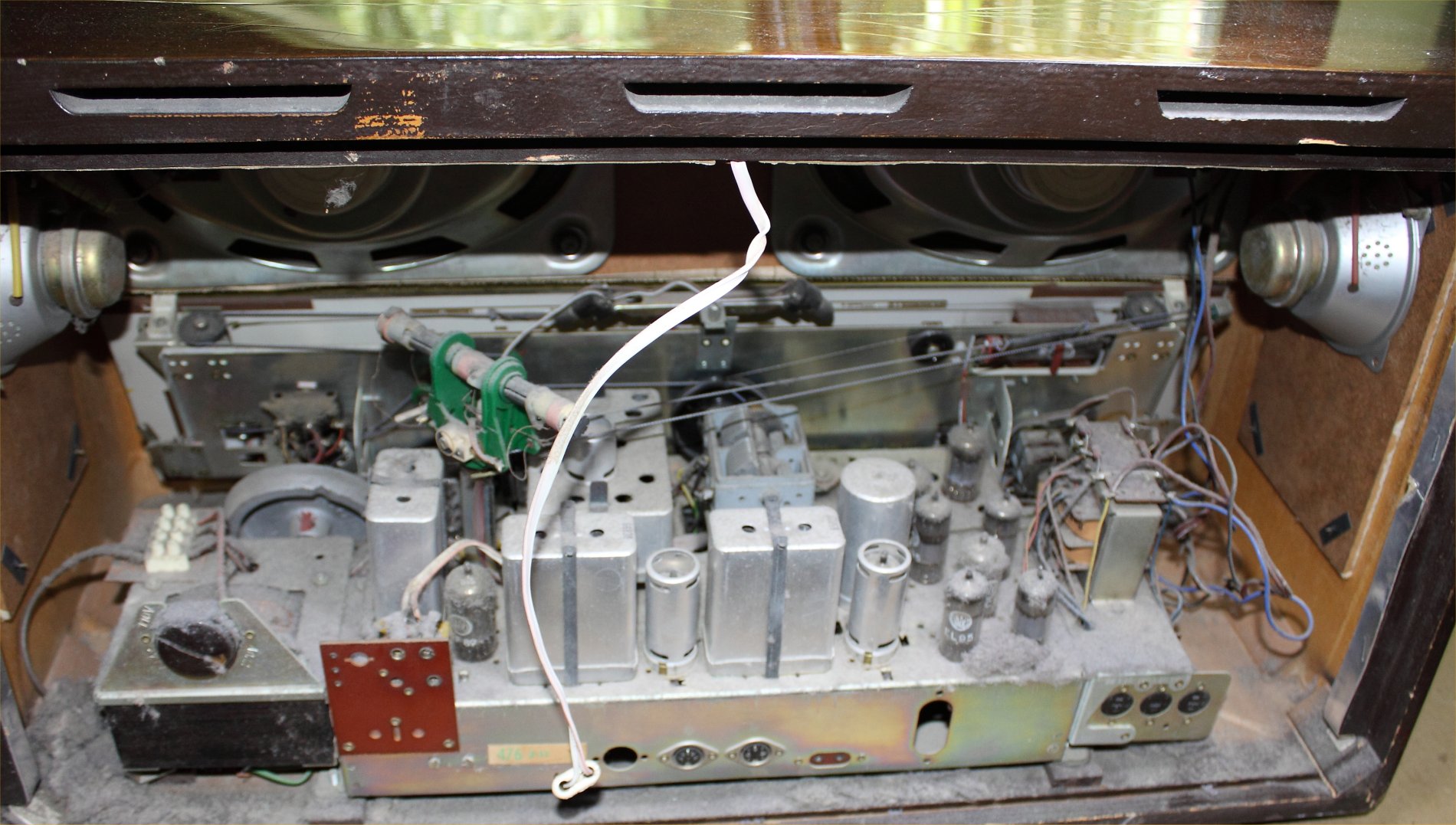








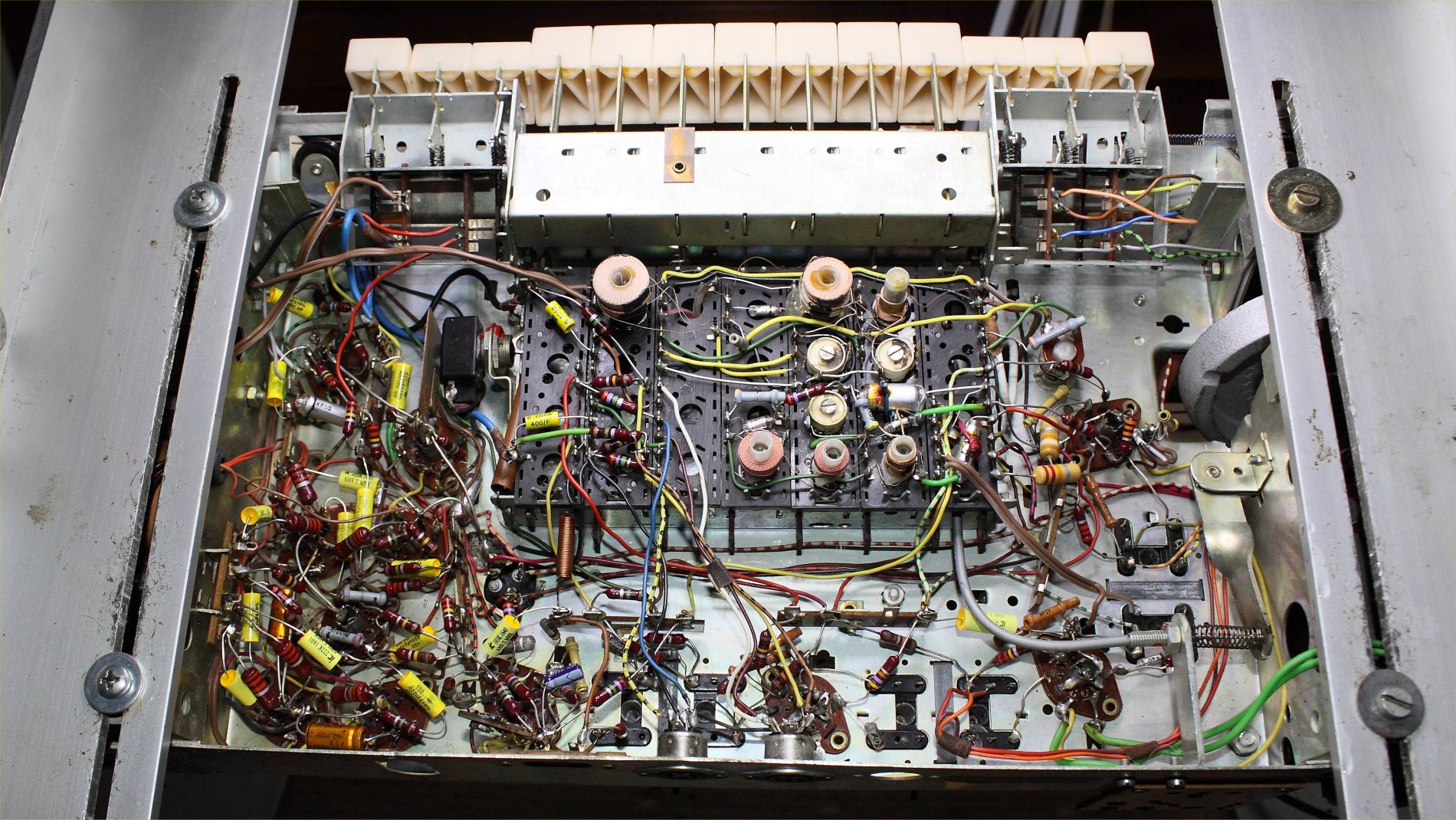
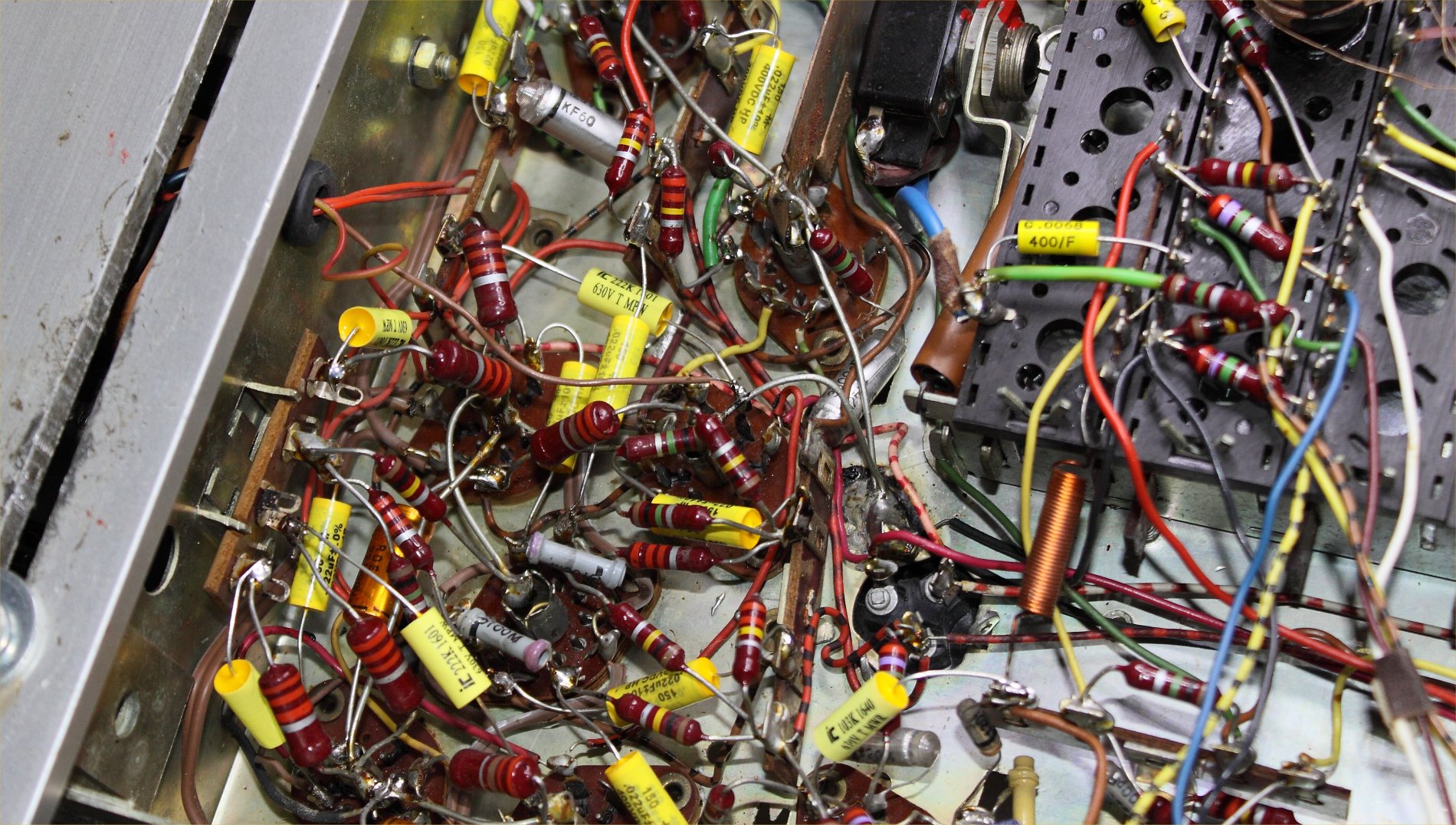
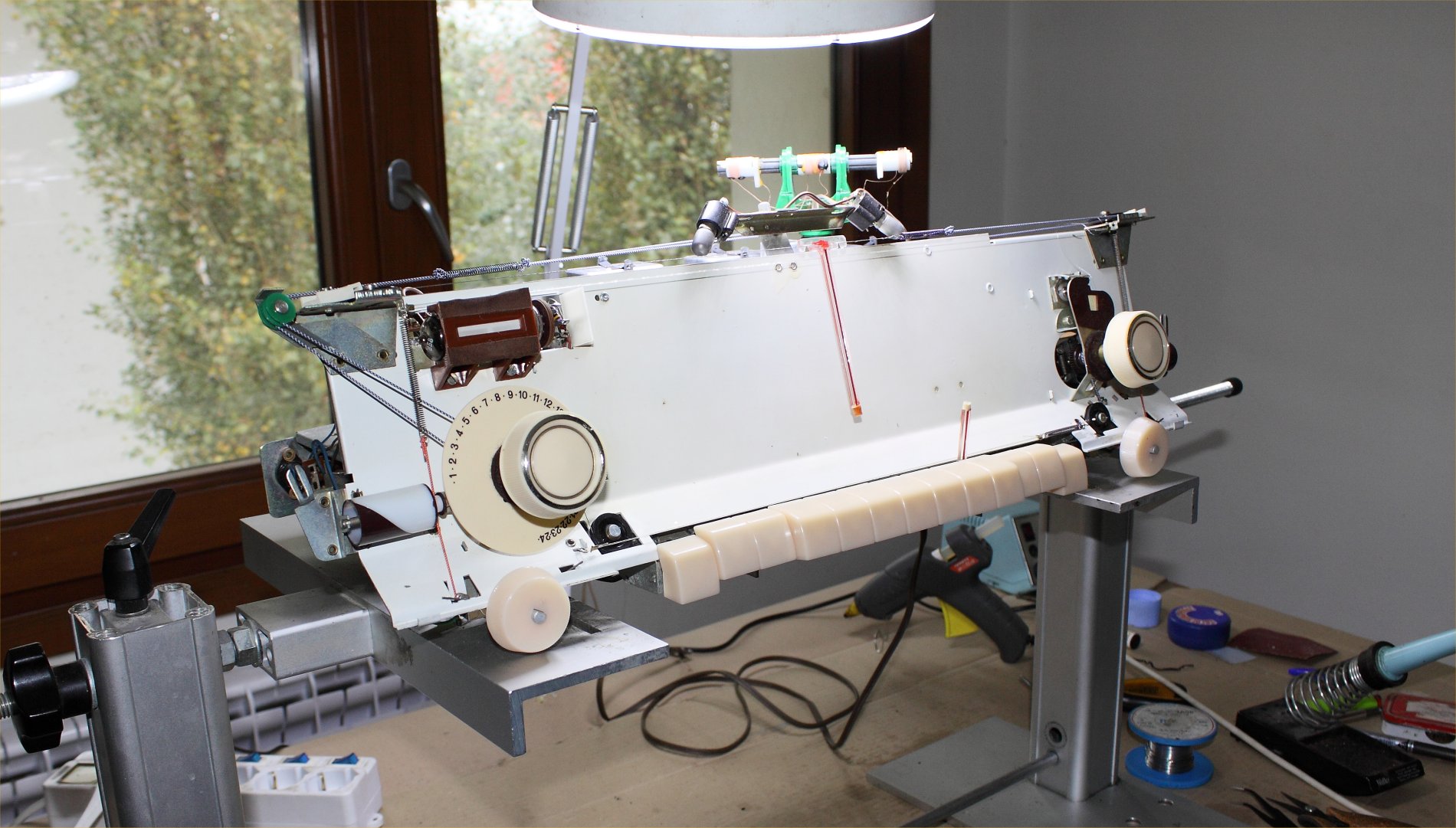





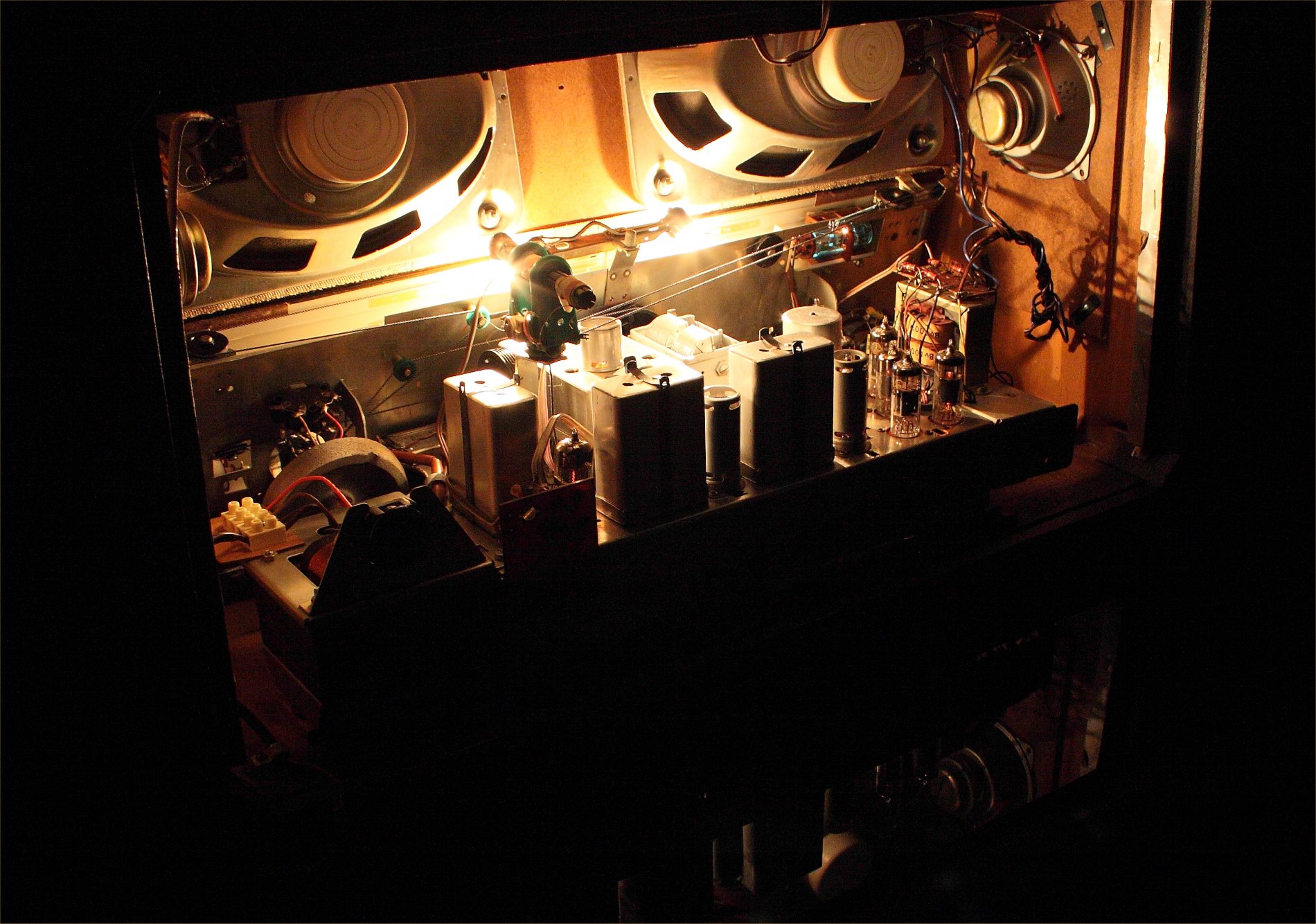
 gbc - cn
gbc - cn







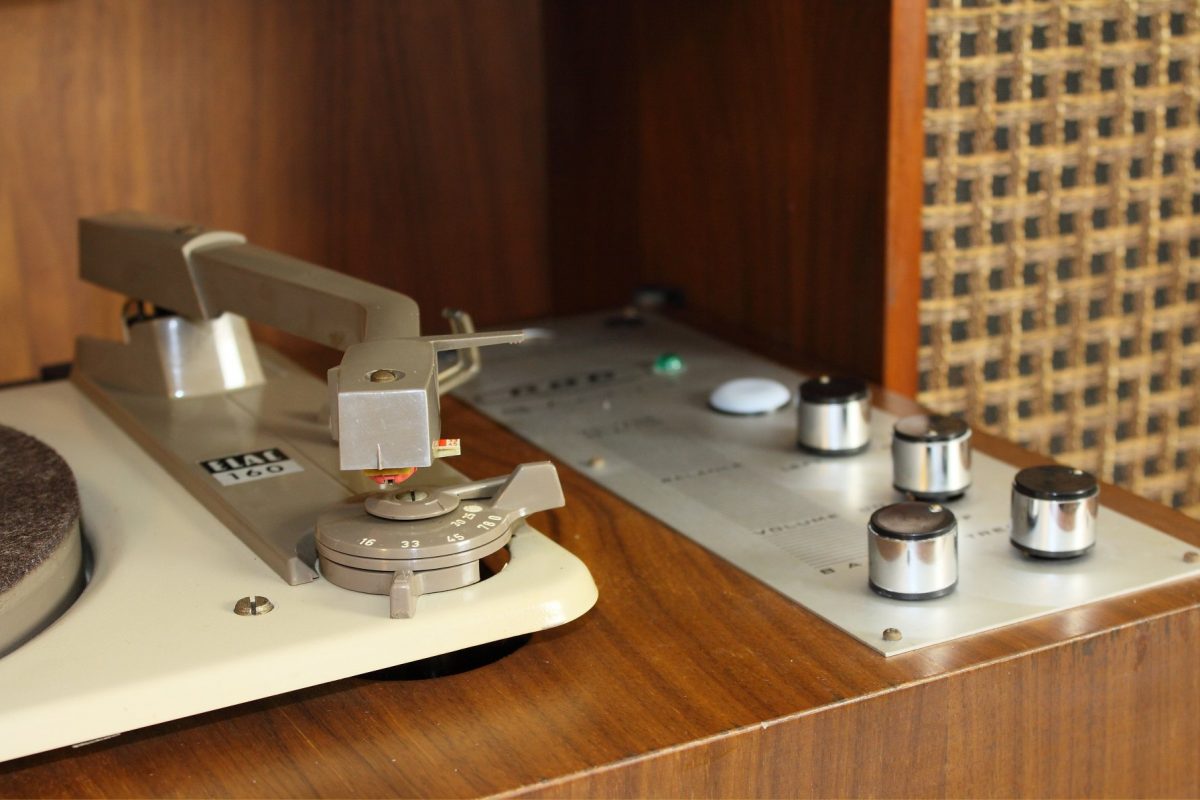





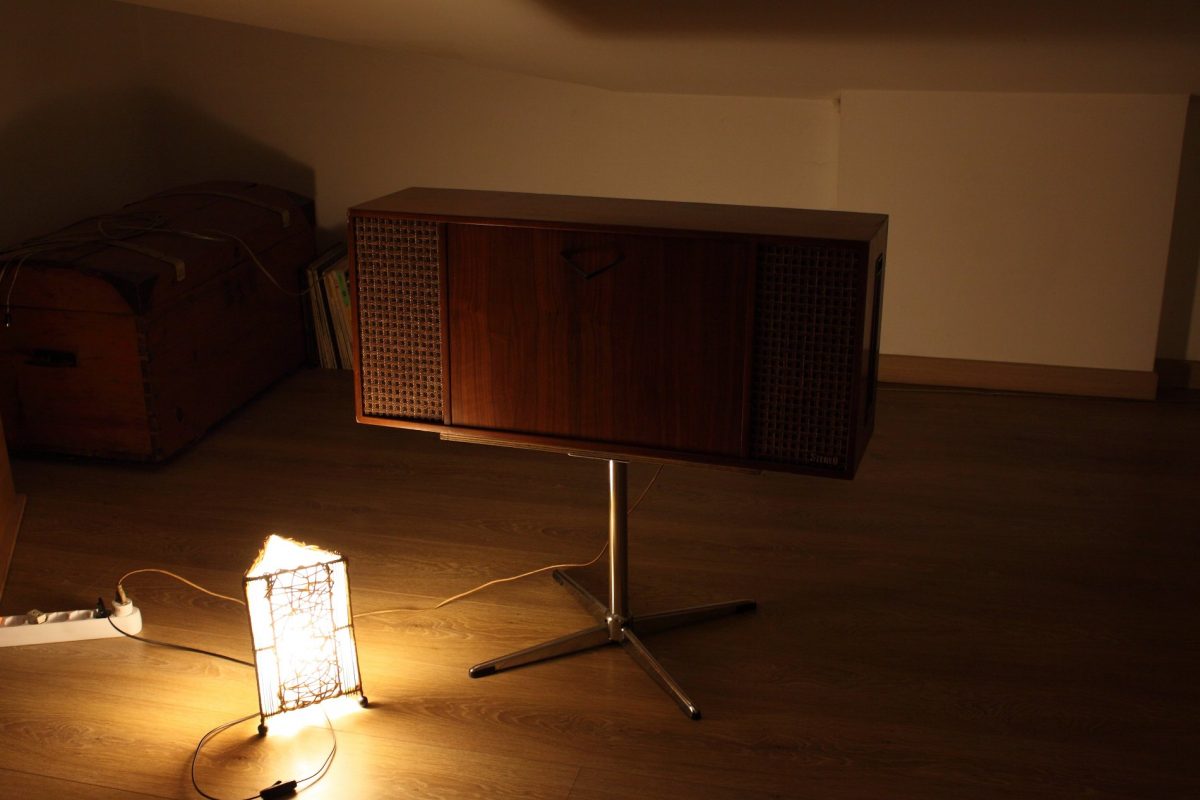


The GBC HALIFAX FV-81 was designed, produced and commercialised by GBC as its flagship model.
It was advertised as a “High-performance, High-Fidelity stereo system”.
Very curious is the definition of the “drop-down” furniture piece, which is basically a fold-out cabinet.
Also interesting is the possibility to mount the cabinet to a wall.
For this purpose, reinforced rear screws have been applied.
Both amplifiers consist of a triode-pentode ECL86, the ultimate evolution of the ECLxx tube range.
The triode is used as a preamplifier and the pentode as a power amplifier. The declared power is of 3W per channel.
It may seem little, but it is not. The IREL loudspeakers, produced in Italy, are very efficient. The boost given by the cabinet further increase the overall effect.
This cabinet effectively sonorises a medium-sized room.
It is not recommended to use a passive subwoofer because of the softening that would be introduced by its crossover filter.
This device is suitable for the listening of Jazz, instrumental, new age and ethnic music, in general.
Metal and other musical genres characterised by strong dynamics are a little too softened by ECL86.
The turntable will be described later.
This device is naturally provided with Bluetooth. The best and practically unavoidable way to use it.
Using any device, smartphone, Ipad etc. it is possible to listen to any radio station in the world, any compilation, podcast, CD and so on.
The sound, of course, is that of the tubes.

Bluetooth receiver embed
Each radio is equipped with a cable for connection to any digital device.
- Bluetooth receiver embed - The unit is equipped with a BLUETOOTH receiver powered directly by the receiver power supply. This makes it possible to control the amplifier from any external digital device as an IPAD, a Smartphone, or a sophisticated multimedia station. So you can hear your preferred web station or your lossesless file without cables on the room. Wireless Receiver can be equipped upon requests.
– Multi Platform Connection – A customized adaptation cable to connect any digital device as Iphone, Smartphone, Laptop, CD Player etc. will be provided with this radio. This special cable suits the different impedances between the modern equipment and the receiver. Furthermore the two stereo channels flow into one without increasing the load to the input unit.

Jacopo castelfranchi
GBC is the acronym for Gian Bruto Castelfranchi, who founded the company in 1958 in order to commercialize instrument accessories and related material.
It is his son Jacopo, however, who made GBC the biggest company in Italy for the commercialisation of electronic materials and devices.
Jacopo joins his father's company in 1946, starting to increase the number of represented products and expanding in the field of electronic components, tubes, passive components and various equipment such as tape recorders and turntables.
The company expands and diversifies and in 1957 the Selezione di Tecnica Radio TV periodical is born, for which is created the J.C.E., Jacopo Castelfranchi Editore.
Not to be confused with the Selezione Radio magazine, published from 1951.
In 1962 the head office is transferred to Cinisello Balsamo owing to a shortage of space.
In 1970, the magazine changes its name to Sperimentare Selezione di Tecnica Radio TV.
In 1970 it becomes a Sony distributor for Italy and it later creates a joint venture with it.
The sales points in Italy reach maximum expansion with over 150 shops.
GBC also designs and creates its own high-fidelity stereo systems and televisions.
In these years, GBC also commercialises assembly kits branded “High kit” and “Amtron”.
In the next few years, it also becomes an importer for Bang&Olufsen, Sinclair and Goldstar.
GBC is sold in 1980.

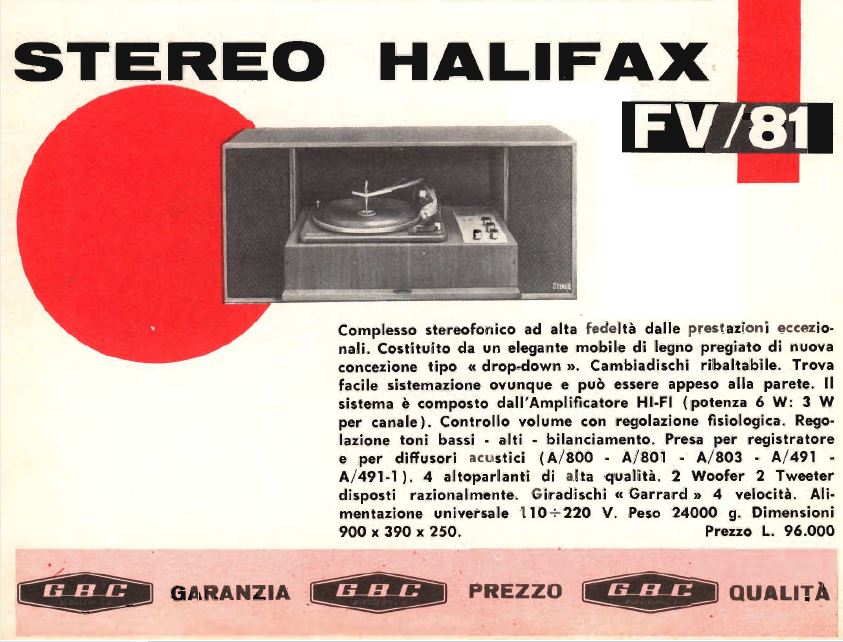
Year of production: 1965
Output power: 3 + 3 W
Turntable: ELAC 160
Loudspeakers:
2 elliptical mid-woofer
2 cone tweeter
Dimensions (LHD): ... mm / 27.6 x 17.9 x 10.8 inch
Net weight: ... kg / 39 lb 10.4 oz
Tubes: 2 x ECL86
The turntable is a semi-automatic ELAC KST106 with stereophonic piezoelectric cartridge.
The turntable is rather quiet for the time. It is very simple to use.
It can play 16-33-45-78 r.p.m. records either manually or automatically. It is also provided with Multi-LP Capable Turntables.
Moreover, it can be placed automatically on records with a 30-25-17 diameter.
The ELAC needle has got two positions 33-78 r.p.m. with two different needle diameters.
The frequency response is linear on the whole audio band.
The turntable/head complex was really good for the time.
Nevertheless, the weight of the piezoelectric cartridges is between 5 and 8 grams. This forced the builders to apply an antiskating of the same strength in grams.
The couple wight/antiskating so big damages vinyl records over time. This is why I advise against using it with rare or precious LPs.

There are four loudspeakers, two for each loudspeaker box.
The 10 cm diameter conical tweeter in cellulose is close on the rear. This kind of structure makes it completely independent from pressure variations generated by the woofer. This ensures a clean and distortion-free reproduction.
The 6 dB/oct filter is essentially composed of a good-quality condenser.
The woofer frequency cut, instead, is entrusted only to its mechanical features.
Above a given frequency, likely around 5-6000 Hz, the softening with which high notes are reproduced is such as to work as a natural filter.
This peculiar way of building filters, very common at that time, not only was economical, but practically generated a single-driver loudspeaker reproduction, with the great advantage of focusing on the audible image.


Starting from the bottom we find the tone controls: Bass and Treble
Above there is the power and volume control
Still above we find the balance control between the left and right channels.
Further up we find the input for external device, Recorder, CD player etc.
On the same line we find the outputs for external speakers.




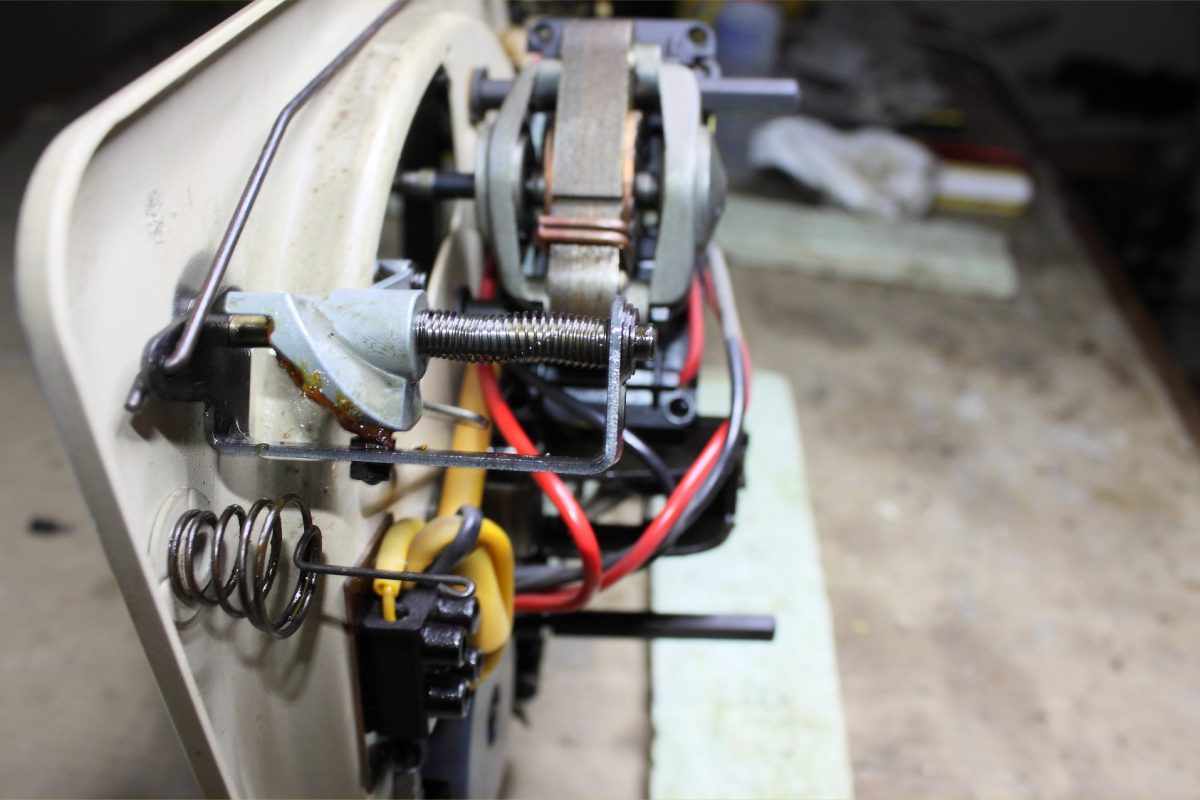


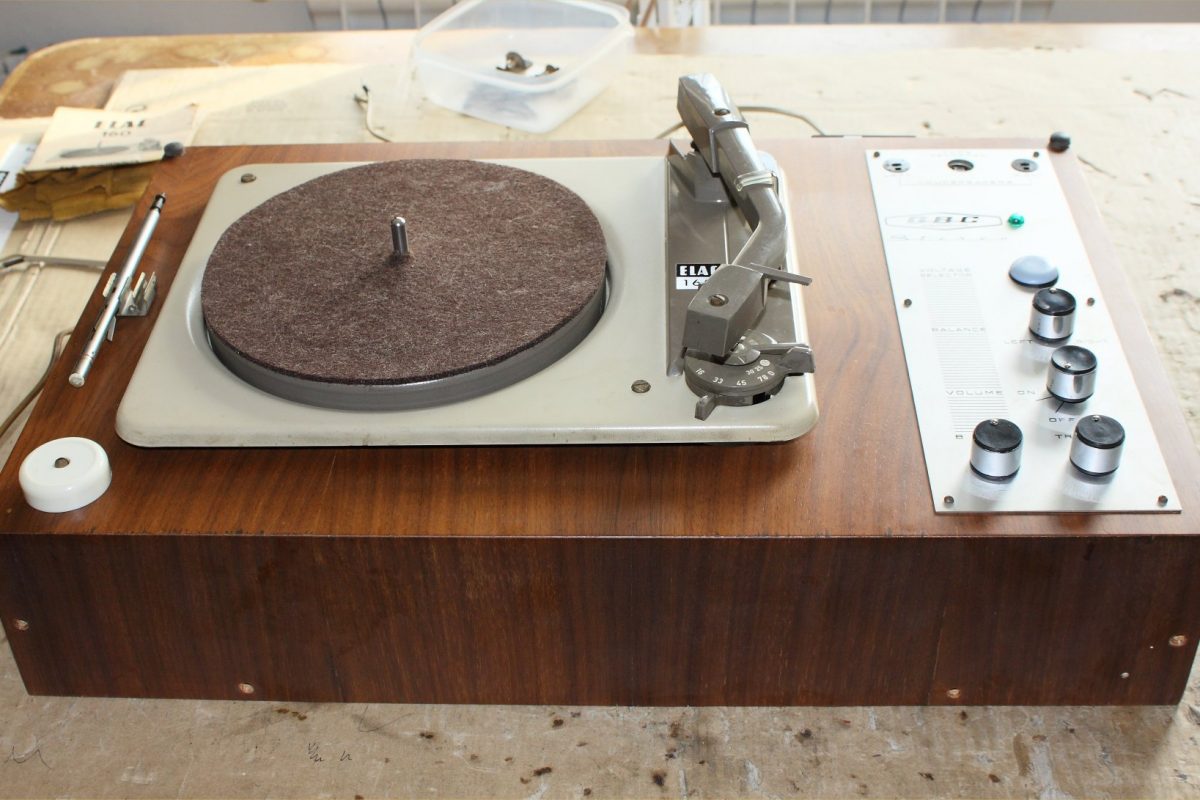



 german radios - cn
german radios - cn
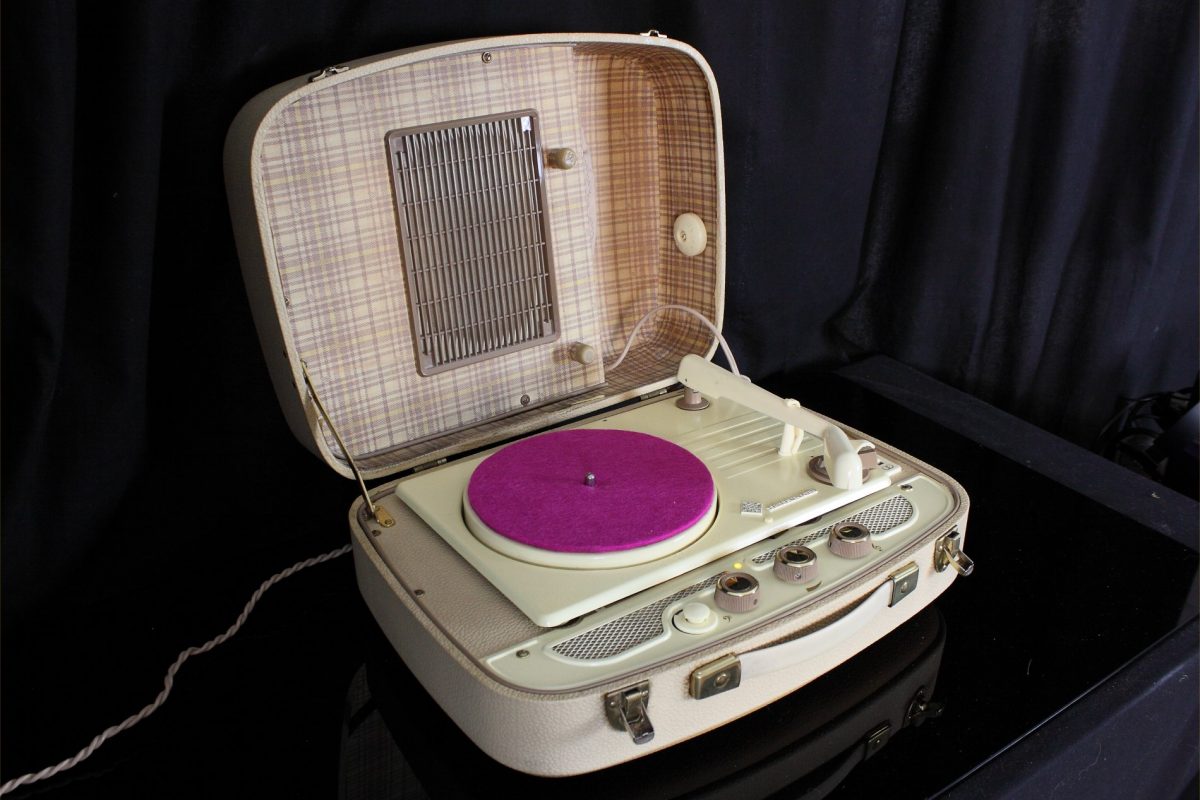
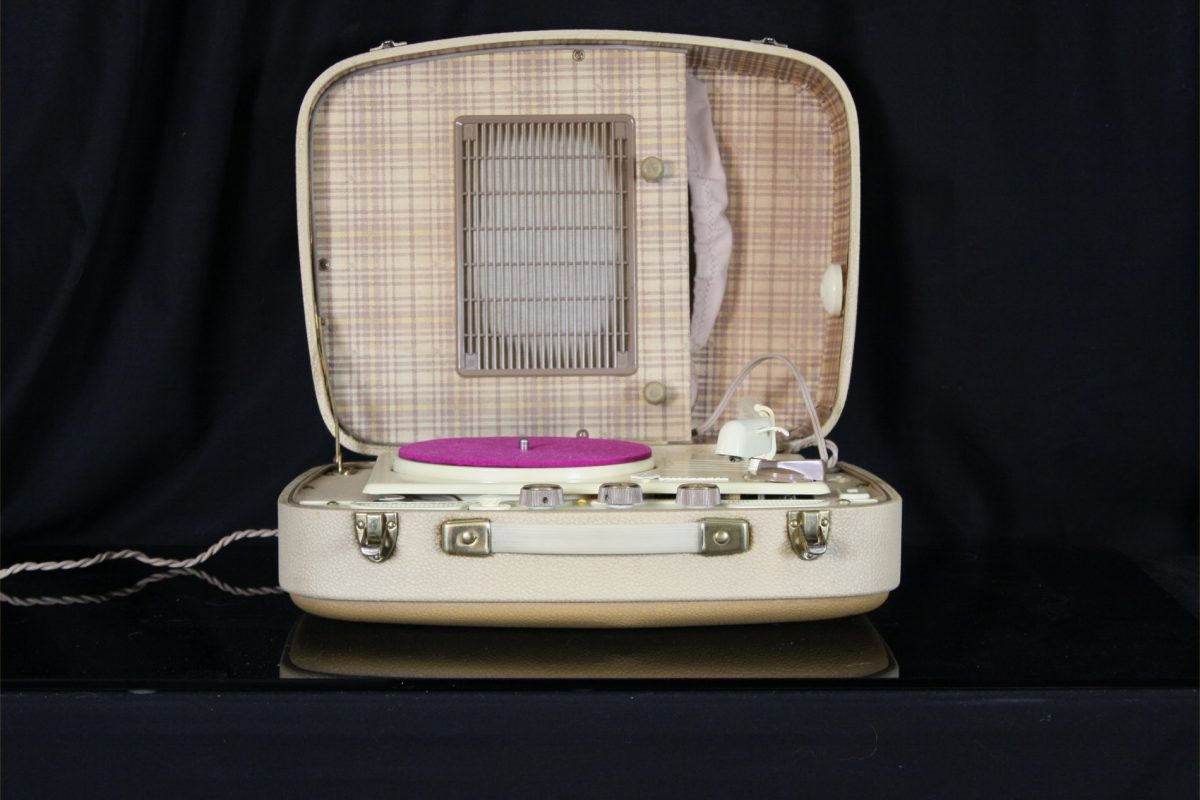






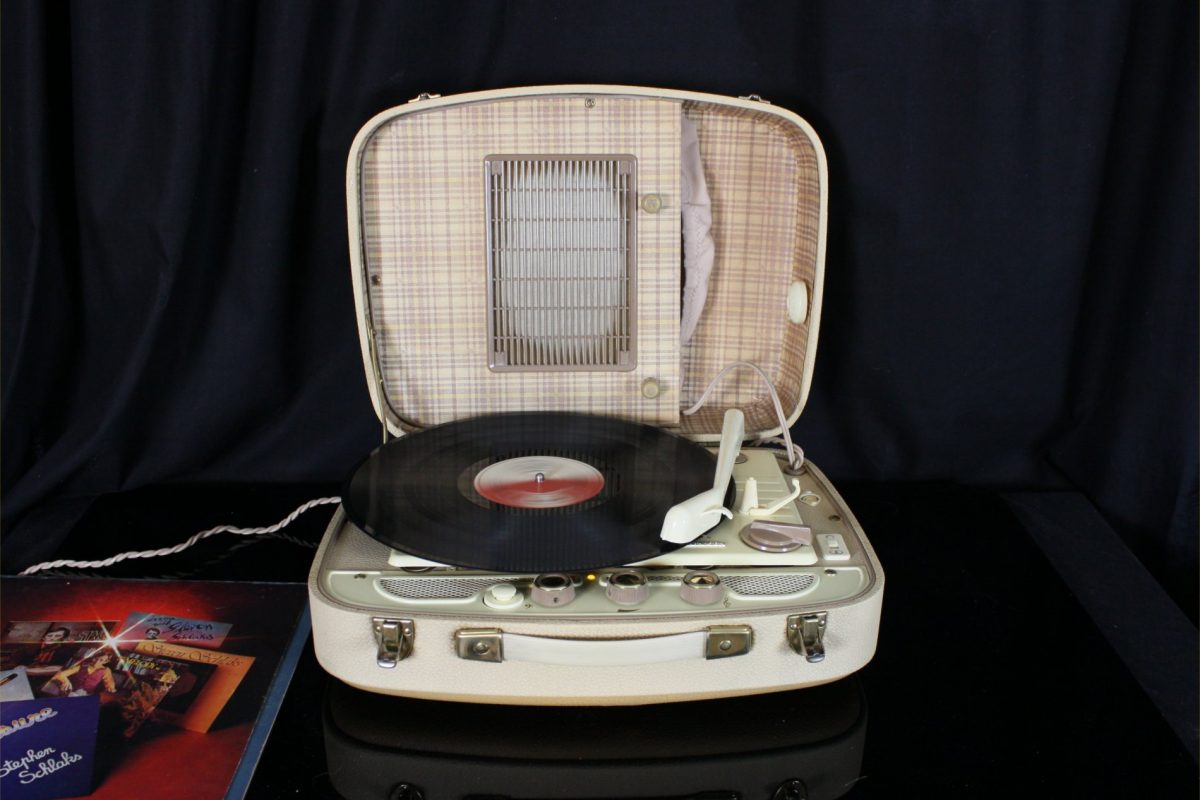


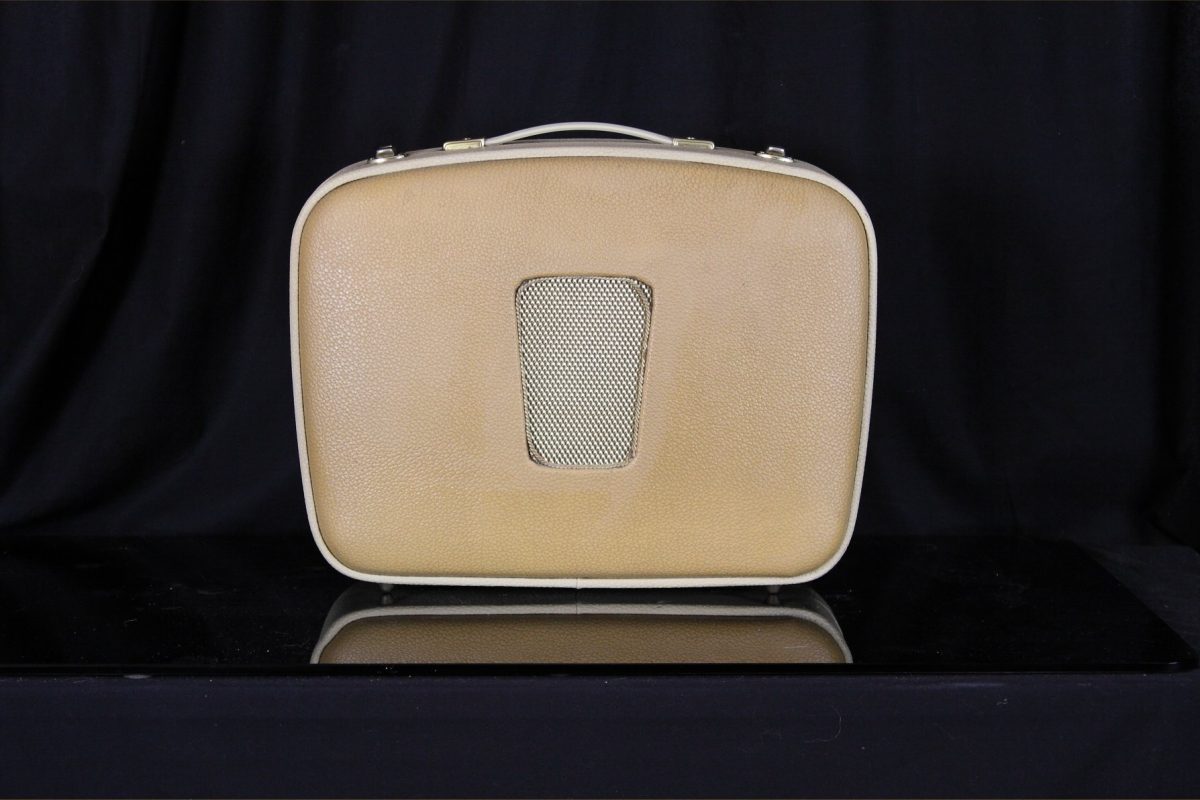
The Telefunken Musikus 5SV is one of the best portable record players built in Germany between 1960-1961.
The mechanical part is comprised of a robust Telefunken belt record player.
The record player is equipped with automatic antiskating set at the factory. It can play discs at 16/33/45/78 rpm.
It is not automatic for which the mechanics are very simple, robust and silent.
It can assemble monophonic or stereo stylus.
The electronics are established from an ECL82 polarized in A-Class.
The triode section of the ECL82 is used as a preamplifier. Between the preamplifier stage and the final stage there are separate tone controls for acute and bass.
Interestingly, the physiological control of the volume consists in three separate levels which intervenes in succession to the volume decreasing.
That physiological control is applied to both potentiometer sections. Another important feature is the ability to connect to an external amplifier, with its loudspeaker, to listen in stereophonic mode.
The traditional use is to connect the output of this record player to the input of a radio.
It is enough to turn the stylus and the Stereo/Mono switch to the Stereo position.
In this way, one channel will be audible from the loudspeaker of the portable record player, the other channel will be audible from the radio’s loudspeaker.
Activating the volume knob of the portable record player, it will act simultaneously on both channels.
The tone controls of the two devices remain separate and independent.
The listening in Mono does not require any additional equipment.
The sound is typical, substantial, sweet and obviously relaxing.
The acute tones are brilliant and the bass is quite quietly present …..within the limits imposed by the laws of physics.
A beautiful portable stereo player with the final stage “Single Ended” in A-Class, enclosed in very refined furniture.
An object which you can enjoy the transmissions of times past.
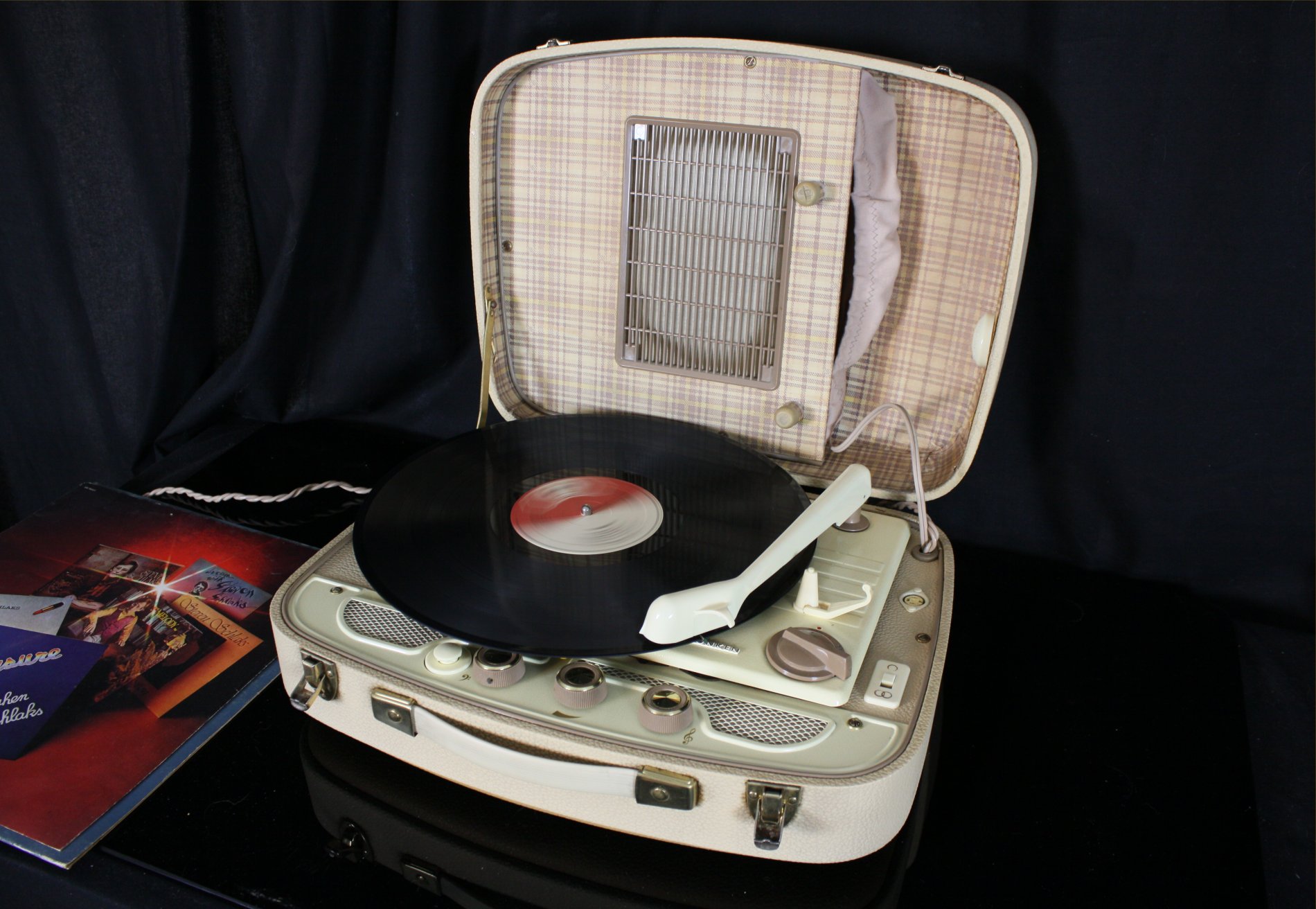



1903 To prevent the English Marconi Company from having a monopoly on wireless transmissions,,Kaiser Wilhelm II orders the company AEG and Siemens to set up a joint venture to develop wireless telegraphy in Germany. It was established under the name of Gesellschaft für drahtlose Telegrafen mbH.
1923 The company name is changed to Firmierung in Telefunken, Gesellschaft für drahtlose Telegrafen mbH. Abbreviated as Telefunken, where Tele means Telegraph and Funken means "Lightning" in the sense of being fast and immediate.
1930 Production gradually moves from military and Government equipment to the production of consumer appliances. During this period, Telefunken enters the market of radio-television, recorders and etching of records.
1930 As radio transmissions are now needed not only to transmit telegraph messages, but also true music and speech broadcasts, it becomes necessary to introduce the concept of sound compression, to avoid continual volume level changes of the radio. Telefunken designs and produces the U3, the first compressor for transmitting stations in the world,. TheU73b, as seen in the picture, represents the evolution of previous models—it allows you to change the compression level, the release times and the attack times.
1941 All Telefunken’s actions are transferred to AEG, which effectively becomes the sole owner of the trademark Telefunken, its factories and patents.
1948 Germany is not invited to the Copenhagen Conference, where the division of Medium and Short Wave radio frequencies of Central Europe is decided. The war has just ended, and officially Germany isn't considered as a technologically important nation. Because of this, Germany decides to develop FM broadcasts even if the quality of the transmissions is considerably higher than those in the AM. At this time, Telefunken develops the V72 microphone/amplification system and its evolutions, intended to be used in all German broadcasters and most European ones too, as well as at the most important recording studios, such as EMI, Decca, Telefunken, etc.
1955 The company becomes Telefunken GmbH.
1967 Telefunken is joined with AEG and the company becomes ‘’AEG-Telefunken’’.
1970 Poor management causes the company to lose market shares. AEG begins to outsource entire business segments and make constant rearrangements.
1985 Daimler-Benz AG buys what remains of AEG-Telefunken.
1996 The name Telefunken is cleared and all activities related to audio products stop.
Today The company name has been renewed in Telefunken Holding AG. Telefunken and its use worldwide are responsible for the name. In United States Telefunken USA buys the rights to build and market worldwide original microphones and some audio equipment under the brand Telefunken Elektroakustik.
The original company that helped spread the music throughout the world doesn’t exist anymore.
Year of production: 1963
VOLTAGE (AC): 110; 125; 160; 220 Volts
Loudspeaker Larga banda frontside magnet
Dimensions (LHD): 410 x 170 x 310 mm / 16.1 x 6.7 x 12.2 inch
Net weight: 4.5 kg / 9 lb 14.6 oz
1 tube: ECL82
Cartridge T20 - T20/2
Speed 16/33/46/78 rpm
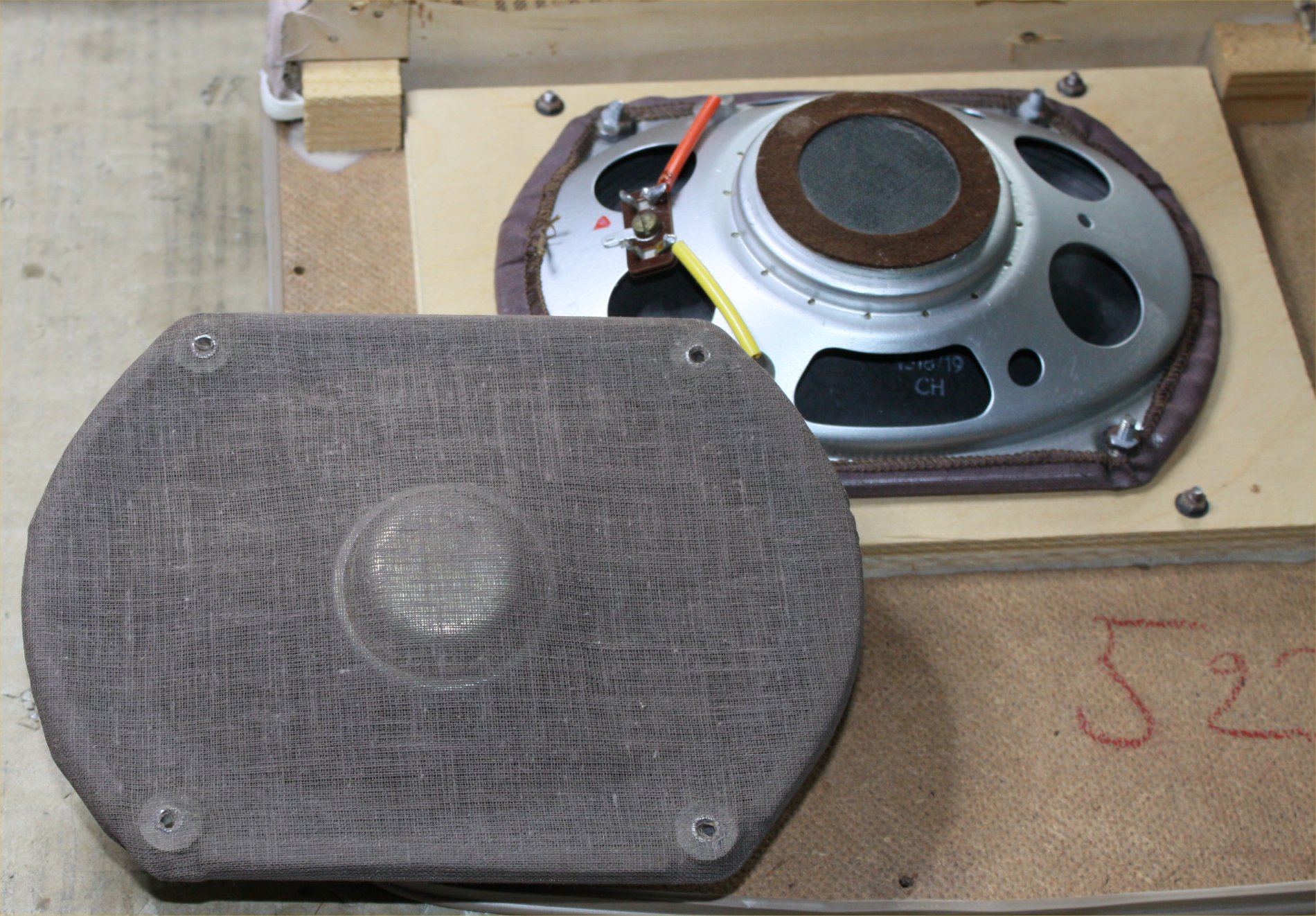
The loudspeaker of this device is very interesting.
Since it has been placed on the top of the lid of the cabinet, it has been necessary to contain the depth.
To do this, the magnet and the reel have been moved to the front of the speaker, in front of the cone.
The cone curvature is also minimized.
With these clever solutions the depth has been limited to a few inches.
The frequency response of a loudspeaker with the profile is shifted to the acute, which is really brilliant.
The cabinet built on the lid, allows the low range to be emphasized, so at the end the frequency response is rather linear.
Another important feature, that reveals the class of this device, is the tone control circuit, which consists of two separate sections for high and low frequencies.
Somewhat different to the circuits usually used in German production, here the controls are independent from the volume control position.
These controls act naturally only on the internal amplifier, not on that additional amplifier.


In the photo, on the left you can see the 3 poles DIN socket, to which it is possible to connect an additional amplifier, as specified in the presentation of the device.
When the switch is in the Mono position (a circle) on both amplifiers the internal one and the additional one, the same signal arrives.
When the switch is in the Stereo position (two circles) to the two amplifiers the signal arrives separately in the two channels. This is controlled by the volume potentiometer which consists of two equal sections.

The first command you can see to the left is the voltage changer. It should only be used at the beginning to adjust the voltage of the record players’ operation to that of the network.
Then, it must no longer be touched.
The second command is the control of low tones of the internal amplifier, to follow the potentiometer of the volume (of both channels)(di entrambi i canali)
and finally, the acute tones control knob.
Above you can see the big knob of the speed control of the record player.
At the end, the Mono/Stereo switch and the output for an additional amplifier.


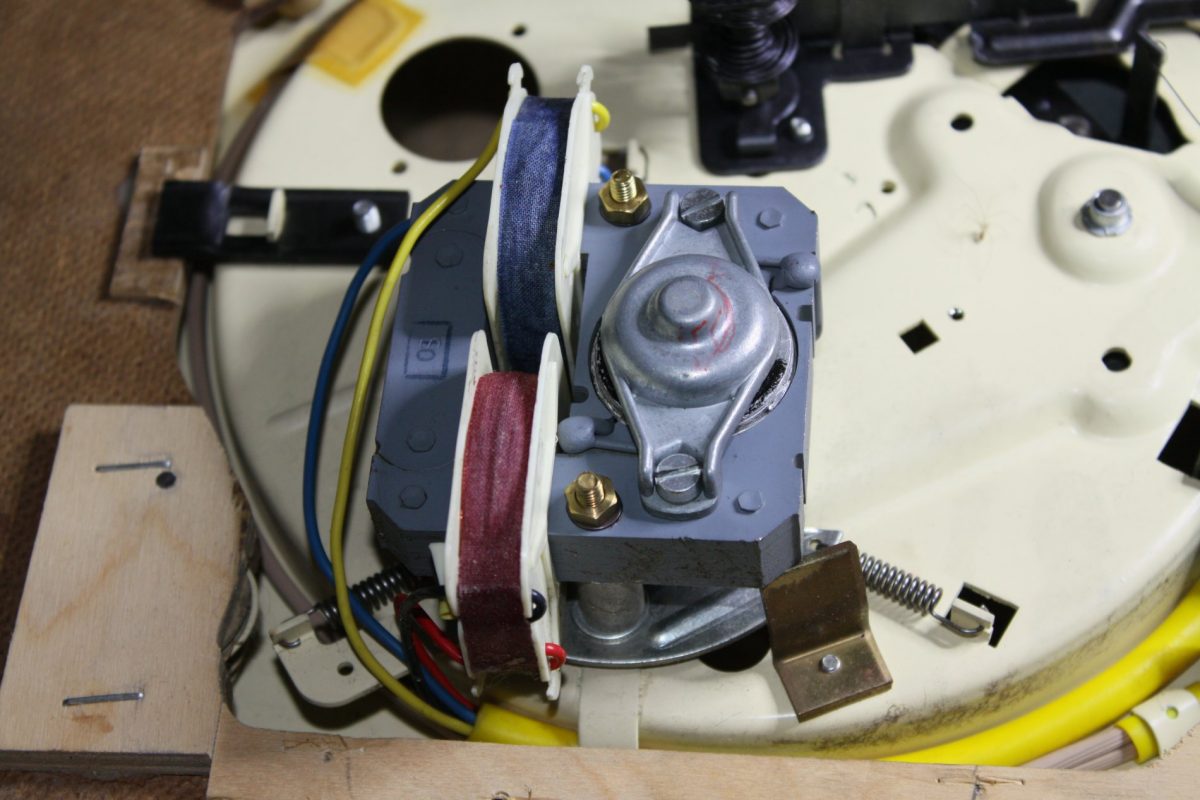
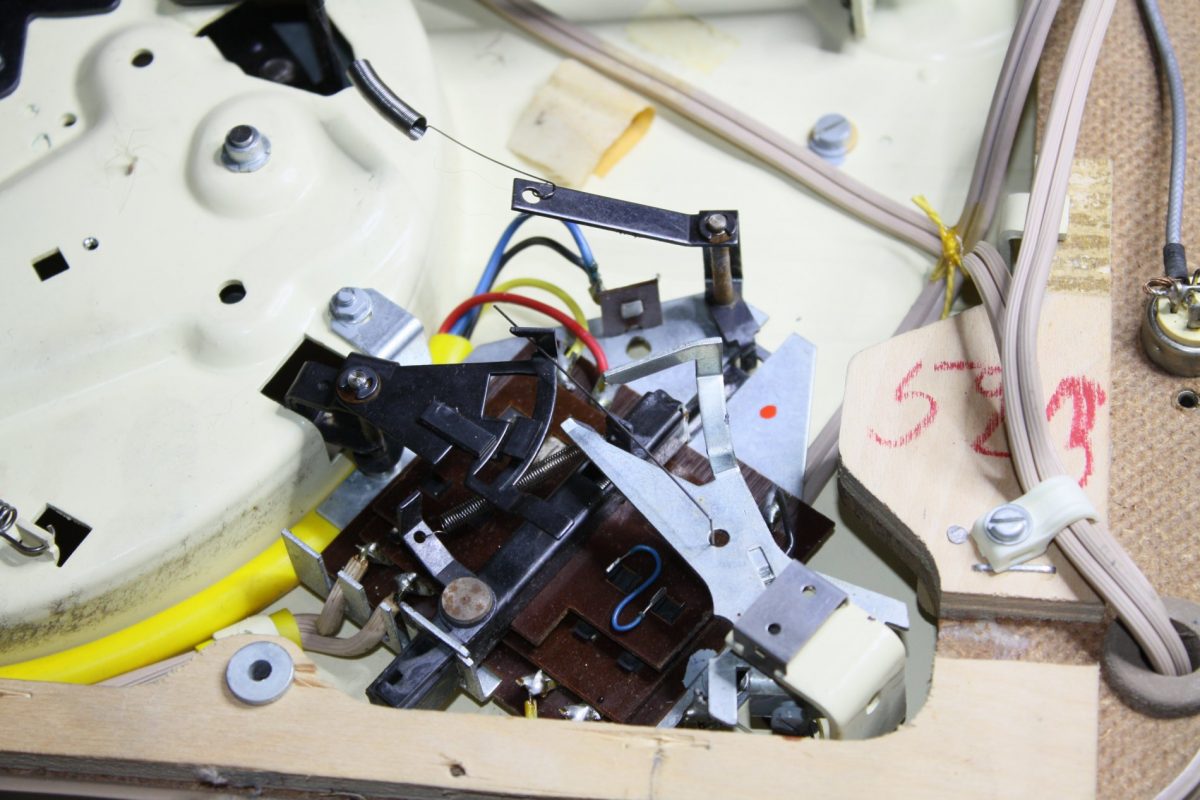




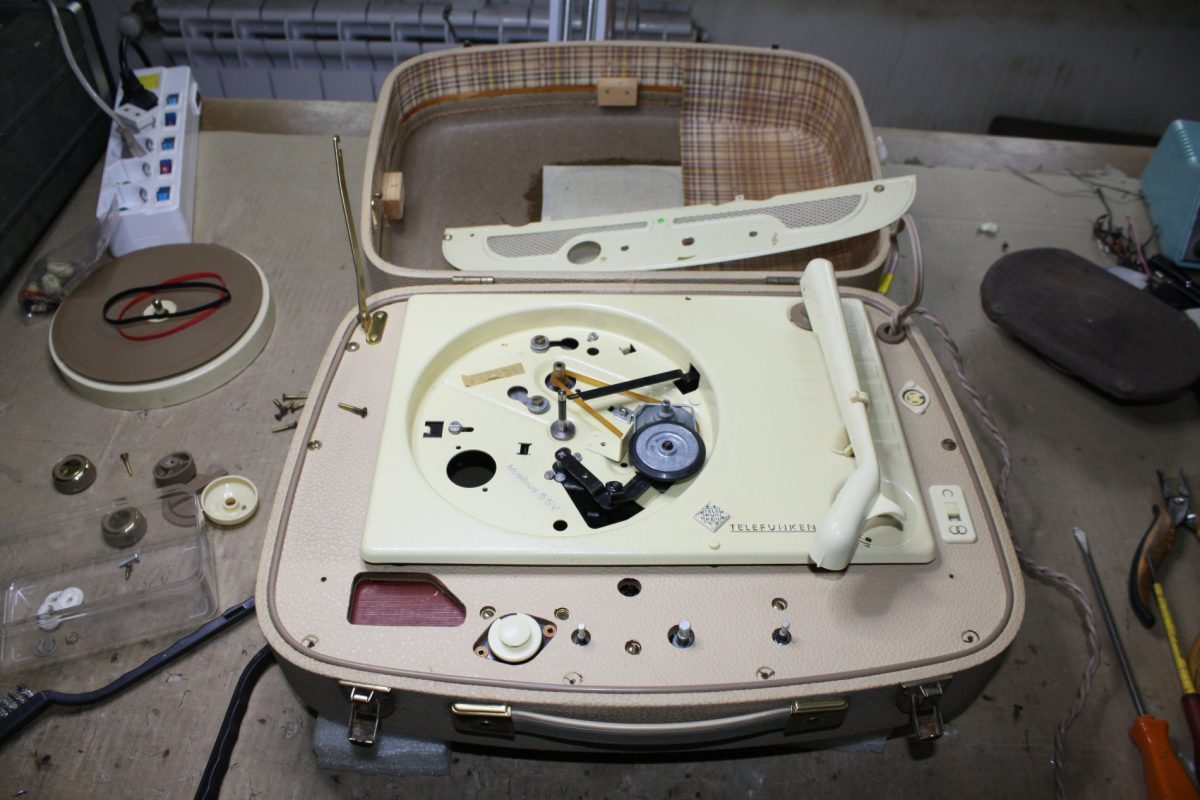
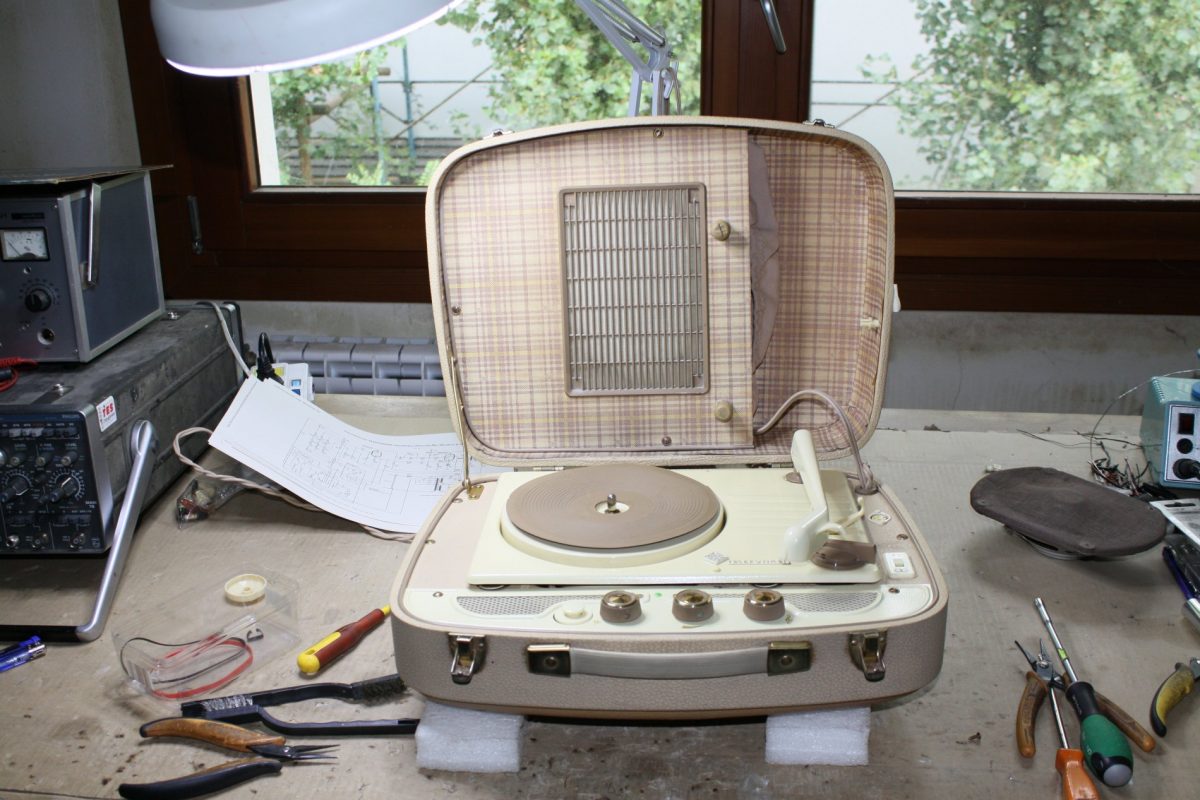
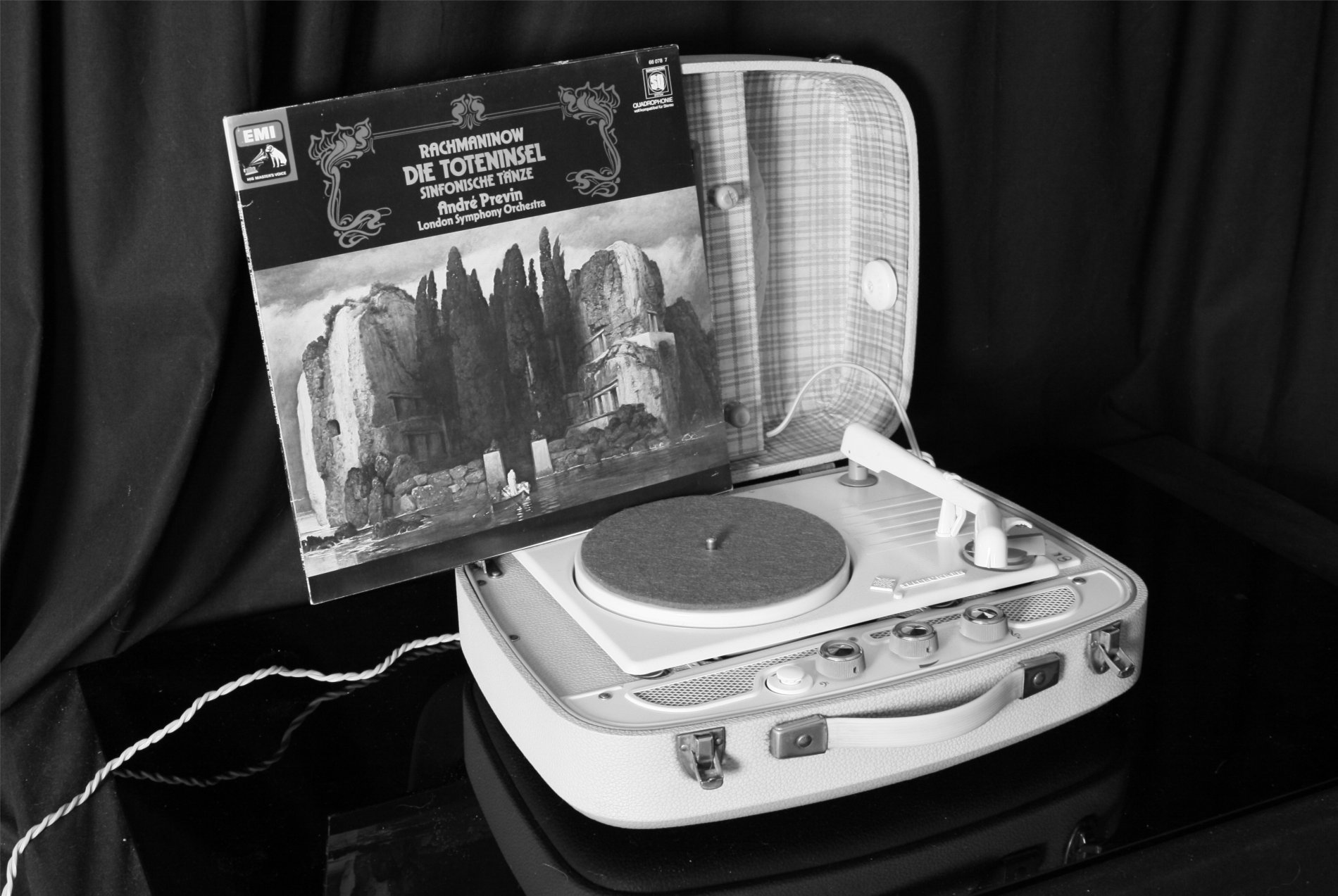
 steuergerät 3007 - cn
steuergerät 3007 - cn








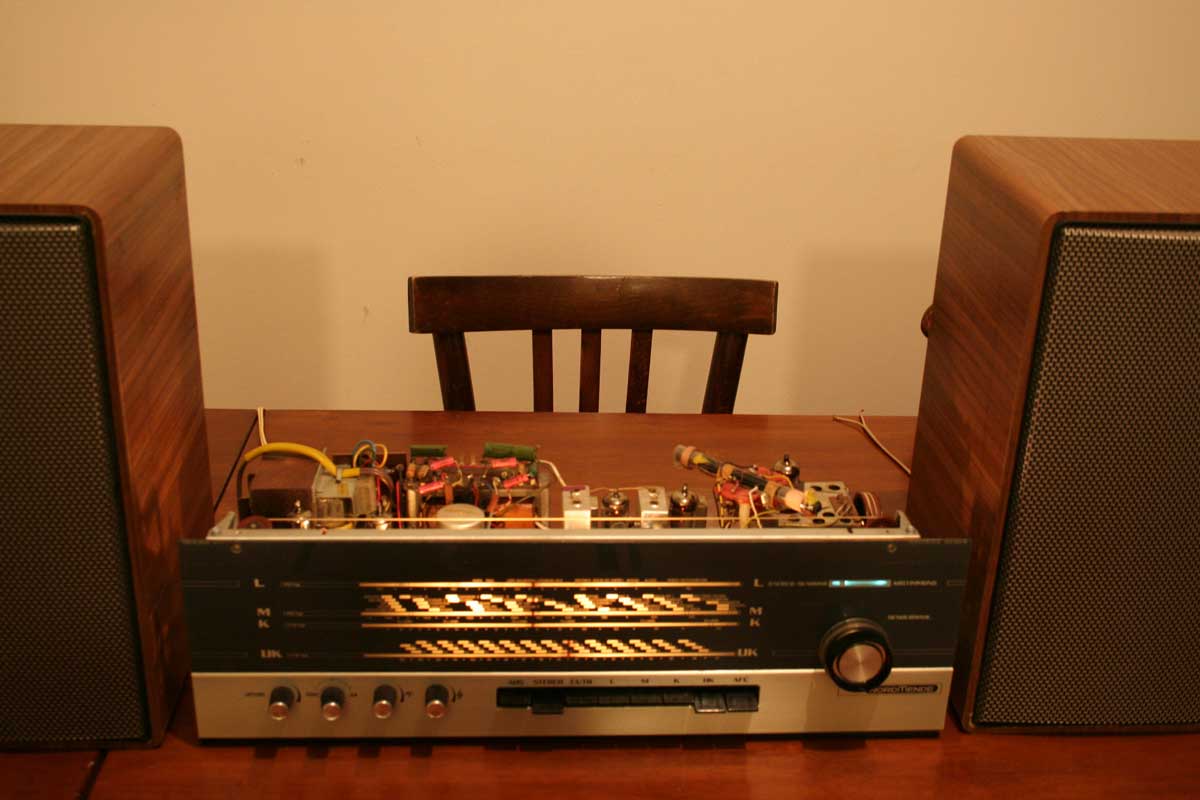
Finally we do not find passive correction or equalization filters on a machine, and this goes to advantage response linearity and signal transfer speed.
I put this note at the beginning to highlight the main characteristic of the NORDMENDE STEREO STEUERGERAT 3007, say, the extreme response linearity.
The power of the RMS output goes around 9W per channel, and its enough to pilot medium dimension and efficiency speakers.
Not having appearently a color of its own, this machine leaves musicality to the loudspeakers, that will have to be chosen with care.
This is in my opinion the harder side, but at the same time intriguing, of the placing of this Nordmende.
Very easy to use and very compact, represents a stylistc line at the top those years in Europe.
Shortly the Japanese will come with their professional-looking machines...talking about the appearence.
The cabinet is very beautiful and opaque-varnished.
The care and the precision by Nordmende in its production are notorious. The quality of the components is known over all by german collectors.
I personally prefere the “naked” machine.
Aesthetically it reminds me of the McIntosh look (don't blame me the evaluators of the legendary Chambers Street's company)
The deisgn is less heavy and immediately becomes current and this benefits the thermic balance increasing the functioning stability and the duration.
If I would have to do a tweaking and not a refurbishment, I'd protect the machine with a black shiny grid of the right dimension. I'm convinced that the result would be very interesting.
It is possible to connect any speaker, preferably with high efficiency.
The device is equipped with the rare Stereo Decoder, allowing you to listen to a multitude of FM Stereo broadcasts in stereo
Built-in Bluetooth receiver
Each radio is equipped with a special cable that connects with any digital source.
- Altoparlanti separati - Poter utilizzare diffusori separati è una possibilità importante per ricevitori stereofonici. In questo modo è possibile accoppiare al ricevitore i diffusori più adatti alle esigenze di spazio, di design o di prestazioni acustiche. I diffusori più adatti sono analizzati in seguito, nella sezione altoparlanti.
- Stereo Decoder - L'apparecchio è dotato di Decoder Stereo integrato. Questo permette di ascoltare in stereofonia le stazioni che usano tale sistema trasmissivo. Molti ricevitori stereofonici non sono dotati di Multiplexer per cui funzionano in stereofonia soltanto quando si seleziona l'ingresso Giradischi/Registratore/Aux. Tali ricevitori, nell'ascolto della radio, inviano ad entrambi i canali lo stesso segnale, per cui l'ascolto è monofonico. Non è il caso della Concertino 2380 che è totalmente stereofonica.
- Ricevitore Bluetooth integrato – Questa unità può essere equipaggiata con un ricevitore BLUETOOTH alimentato direttamente dall'apparecchio Questo rende possibile usare l'amplificatore da qualsiasi dispositivo digitale esterno, come IPAD, Smartphone, o sofisticate stazioni multimediali. Potrete ascoltare le vostre Stazioni Web o le vostre musiche preferite senza cavi in giro per la stanza. Su richiesta è possibile anche montare un Ricevitore Wireless.
- Connessione MultiPiattaforma - Con l'apparecchio viene fornito un cavo adattore di impedenza per connettere qualsiasi sorgente digitale, come Iphone, Smartphone, Computer, CD Player ecc. Questo cavo appositamente costruito adatta le differenti impedenze delle moderne apparecchiature digitali. Inoltre i due canali stereofonici vengono raccolti in un unico flusso senza aumentare il carico dellunità sorgente.
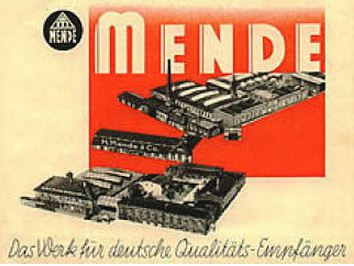
In 1923 Otto Hermann Mende founded Radio H. Mende & Co. in Dresden. After the bombing of the factory in 1945, Martin Mende (son of the founder) created a new company in Bremen, the "North German Mende Broadcast GmbH" whose name was later changed into NORDMENDE.
In the 50s and 60s it became one of the most prestigious German TV and radios manufacturer.
In the 70s the televisions by NORDMENDE became famous for their frames, cards and for the rigorous testing and quality controls carried out on their finished products. Unfortunately, the high cost involved in such detailed quality determined a competitive disadvantage when the price of color television began to fall.
In 1977 the majority of the shares was sold to the French Thomson. The following year, the family sold the remaining shares. In 1980, the factories of Bremen was closed, NORDMENDE becoming purely a trademark of Thomson.
Year of production: 1966/68
Superheterodyne IF 468/10700
6 AM Circuits
10 FM Circuits
Wavebands:
Medium Waves (OM), Long Waves (OL), Short waves (OC), FM (UKW)
AC Voltage: 110 - 220 Volt
External loudspeakers output
Dimensions (LHD) : 550 x 210 x 230 mm / 21.7 x 8.3 x 9.1 inch
Net weight: 9.2 kg / 20 lb 4.2 oz (20.264 lb)
Tubes 8: ECC85, ECH81, EAF801,ECC808, EMM803;ECC81, 2 x ECLL800

The tube sockets are made of ceramic and not bakelite.
The use of this expensive material ensures the grip of the contacts even with high temperatures and without spurious capacities and and interferences thanks to the best dielectric characteristics of the ceramic compared to other cheaper materials usually used in commercial devices.
Inside the cabinet there is a dipole for FM reception and a ferrite aerial for AM reception.
The reception sensitivity with internal aerials is very good.
This unit was in fact produced in a period when there were not many radio stations and those available fairly apart from each others.
Using an external aerial sensitivity is further increased.

The tuning system is interesting and different than other devices made in Germany.
The device is equipped with separate tuning mechanisms for AM and FM bands.
There are two tuning knobs, separate but coaxial, with cable and pulley systems separated depending on the band. This type of tuning has a very strong mechanics.
Regarding maintenance, cleaning and lubricating once every 10 to 15 years is sufficient.
The magic eye has of course been replaced.

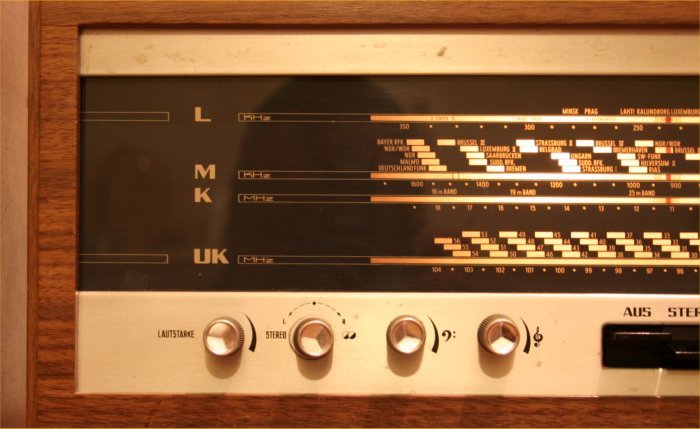
On the left we see the volume command with incorpored loudness.
After that on the right the L-R channels balance control.
Bass tones knob, treble tone knob.

We find then these buttons, in this order:
Power On/Power Off,
Stereo/Mono,
Turntable/Recorder Input,
Long, Medium, Short Waves,
FM,
Automatic Frequency Control (keeps an FM station centered once tuned in)

On the right we find then the magic eye that indicates with the left bar the presence and the level of a Stereo Station, with the two little bar on the left the perfect tuning of each station.
Finally we find the two axial knobs for the tuning of the AM and FM bands.

Output for external speakers.
Socket for recorder (tonbandgerat).
Turntable input (Tonabnehmer)
AM and FM aerial inputs and ground socket.
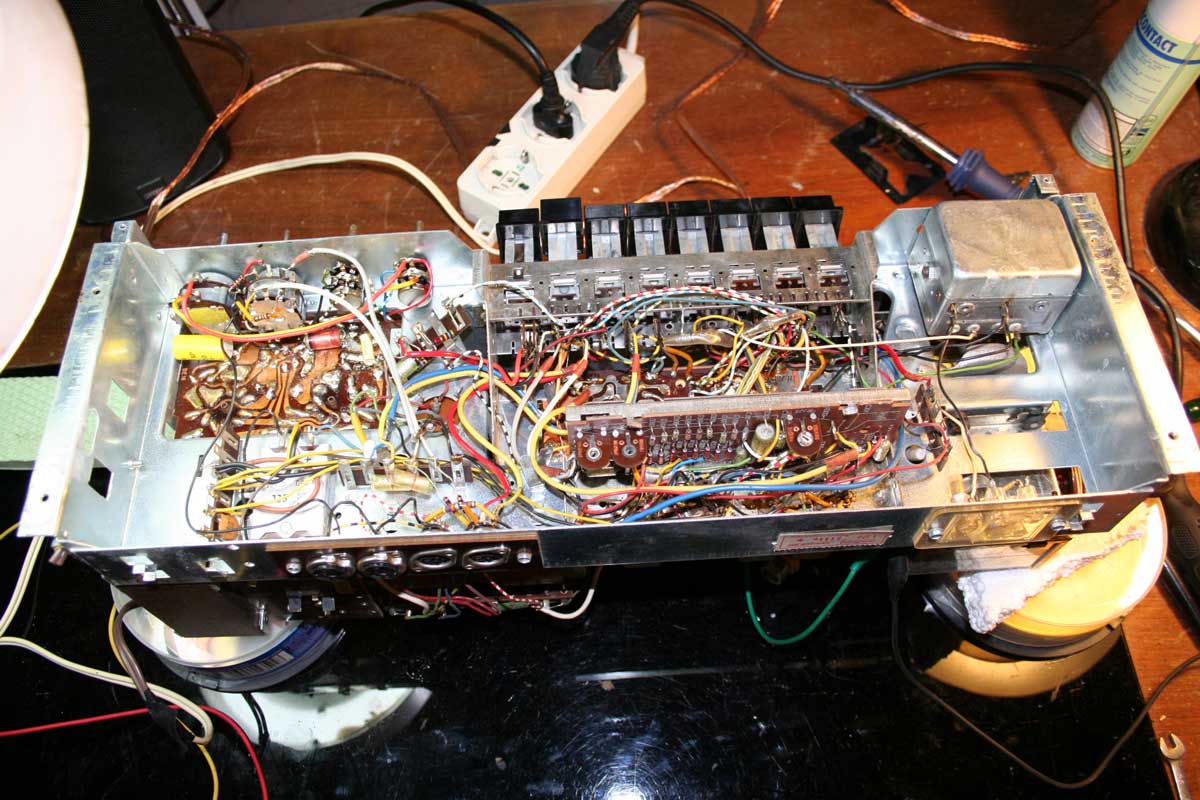



 freiburg studio a - cn
freiburg studio a - cn







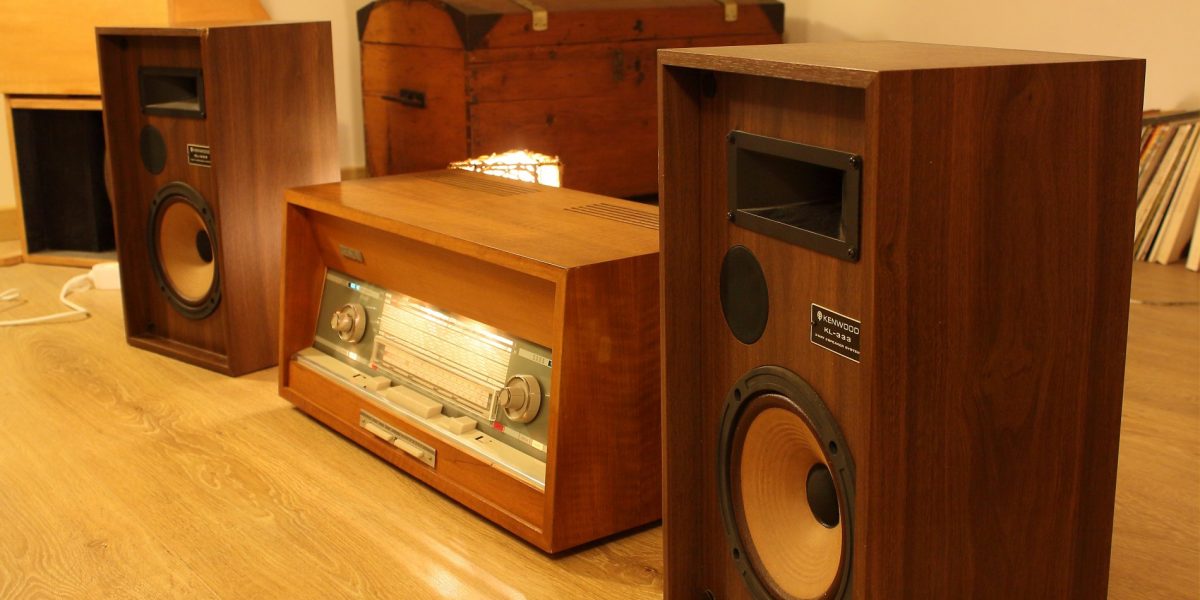



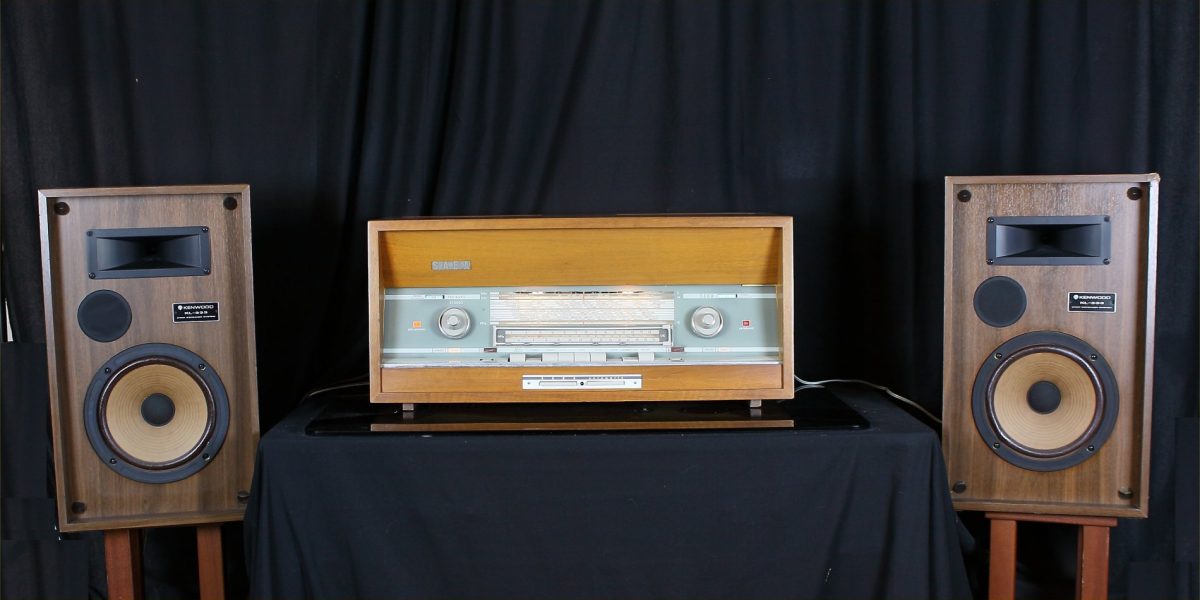

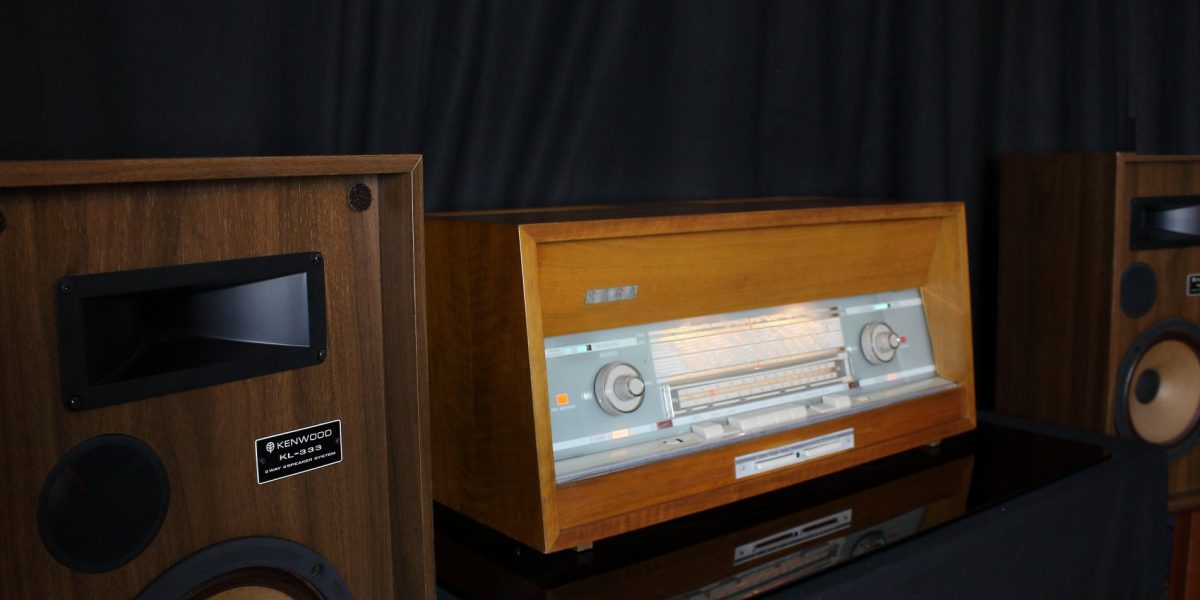

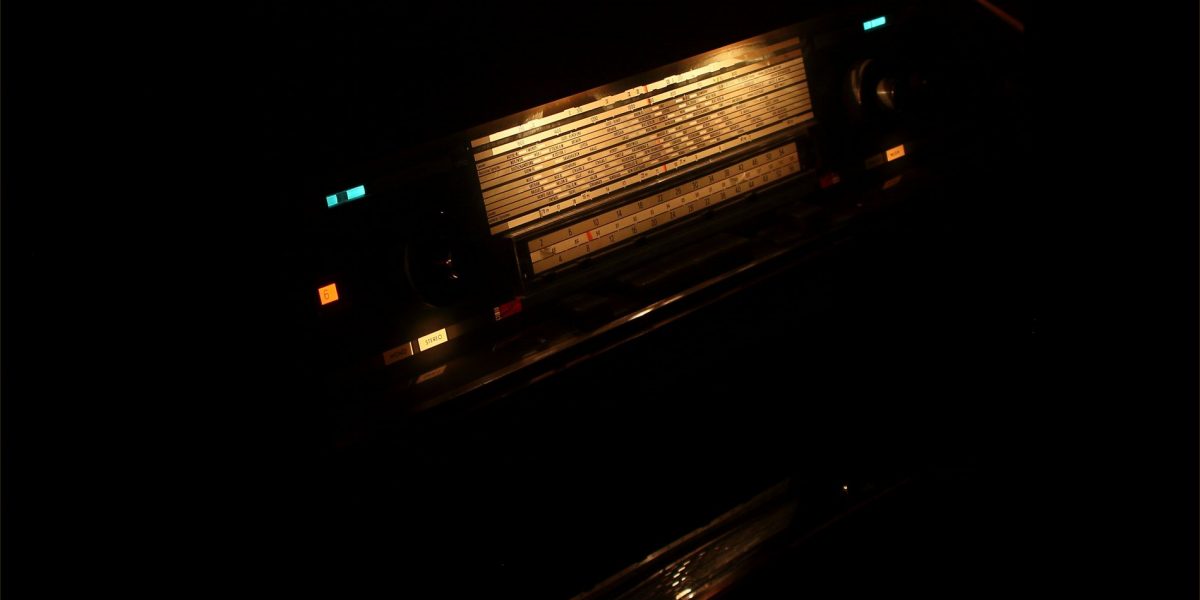
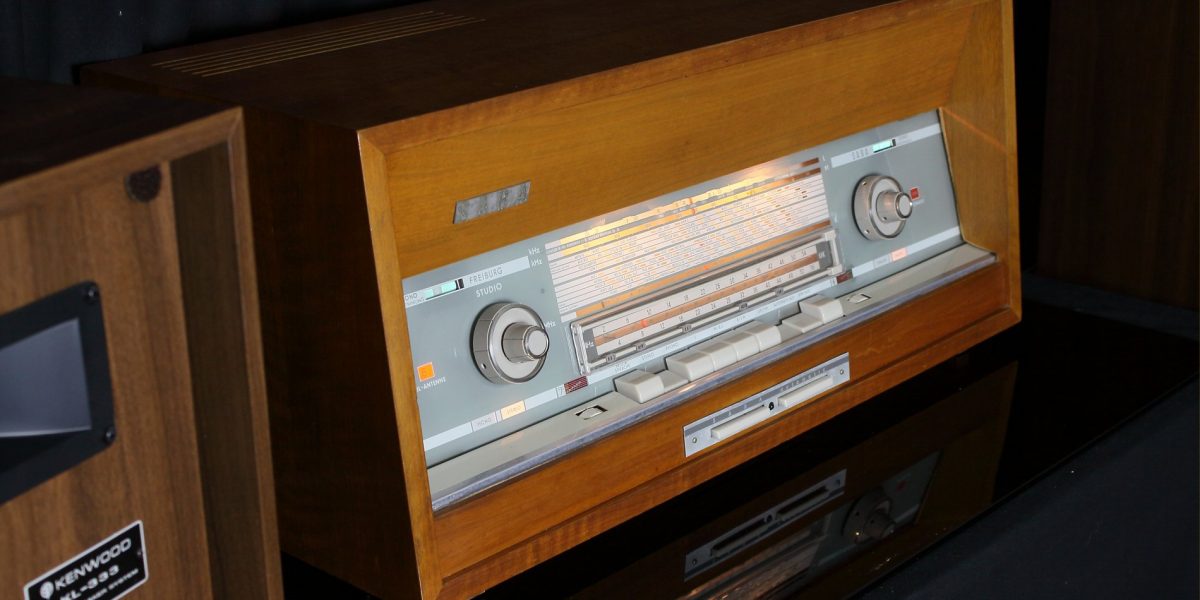
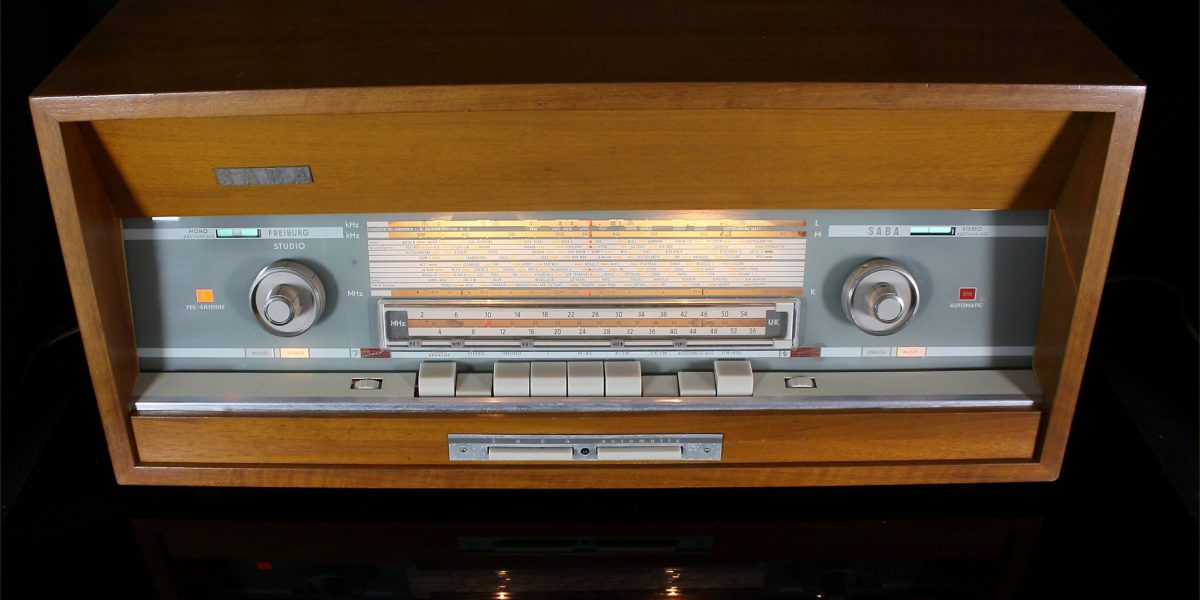





在德国生产並配有自动搜索的放大管接收器中,Saba Freiburg Studio A可以说是最极致的机种。
没有其他德国的接收器能像Saba Frieburg Studio A配备如此多的性能及特点的。
就电子而言,Saba Frieburg Studio A和Saba Frieburg 14使用相同的机械主体。对于这一技术的描述可以参考他们的网页,但使用的可能不尽相同。
第一个优势:没有扬声器,家具是更简化且更容易摆置在任何给定的空间。
第二个优势:设备可以连接至兼容的扬声器,并摆置在最适合的位置理想的聆听。
接收器提供许多可能性的,例如,对Saba Frieburg Studio A是非常重要的。如果使用得好,它们可以从根本上改变系统的声音。
针对这一特殊的评论部分,我强烈建议你考虑以下的建议以提高听觉的经验:
不要把电子设备放在两个扬声器之间。在图片中接收器是放在两个扬声器中间,这是因应特定摄影的需要。一个真正的配置,它必须放在一边。
聆听音乐是一个整合的经验,它吸引著其他感官超越听觉。您可以在家里分别试着在黑暗中及灯光照明下聆听同一首音乐。另外,播放电影下聆听同一首音乐。最后试着看演唱会视频下聆听同一首音乐。
在所有这些情况下以及许多其他情境下,大脑会侦察並发展出不同方式的声音。即使我们聆听同一首音樂,也会创造出不同的感受。把电子设备放在扬声器中间会扭曲我们对声音的感知。还要注意放置在扬声器中心的设备的机械共振。
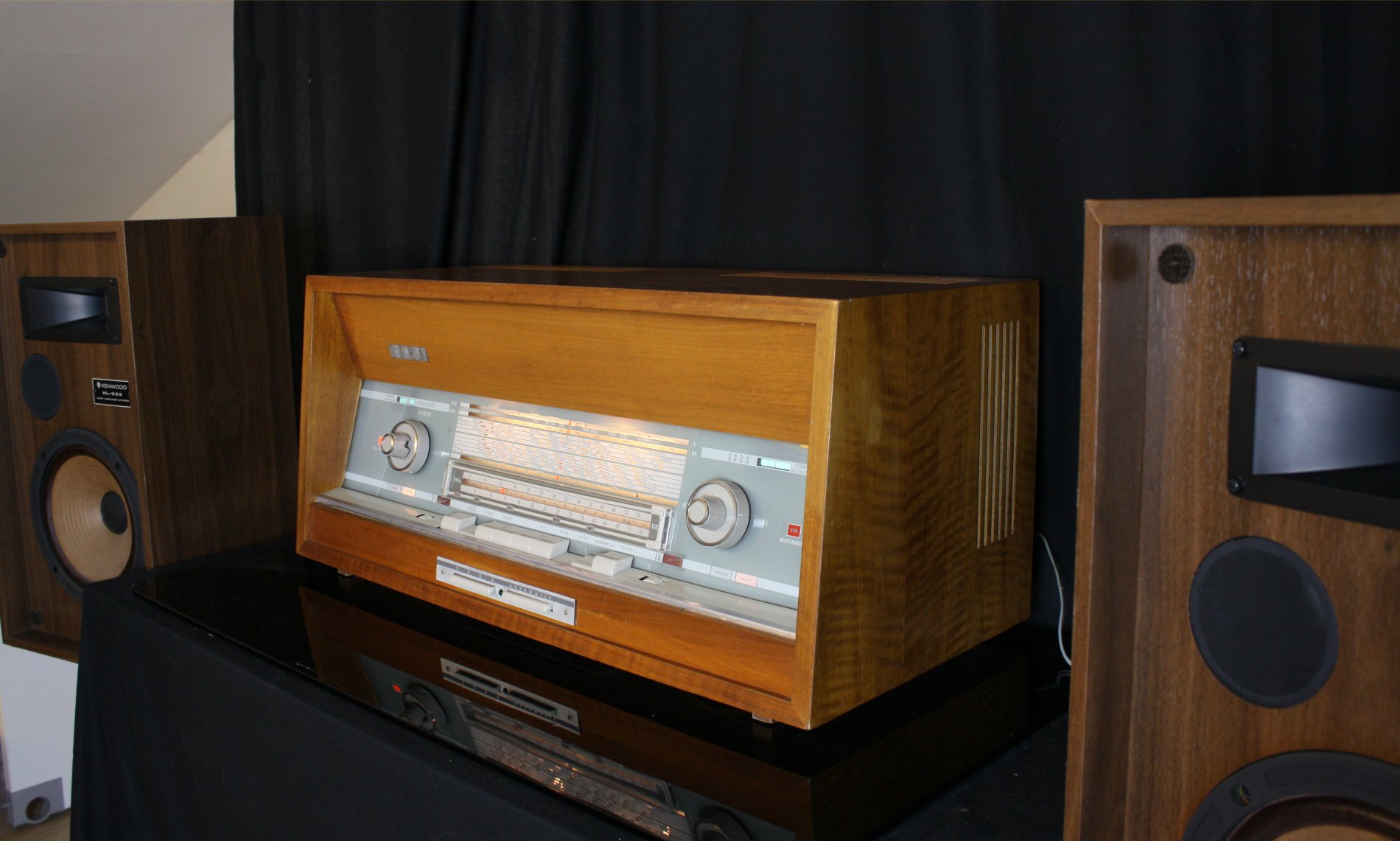
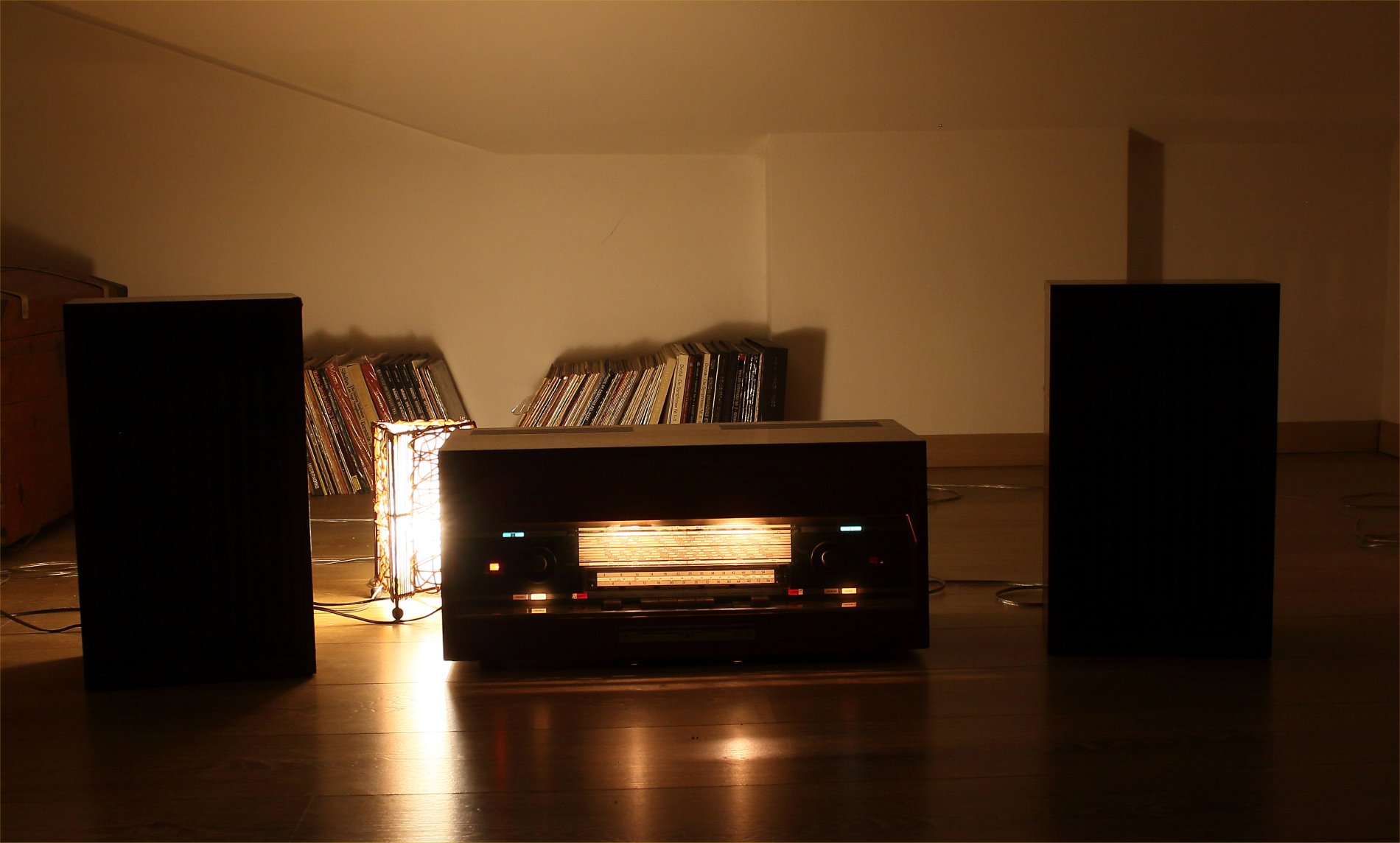


SABA是德文Schawarzwälder-Apparate-Bau-Anstalt的缩写,也就是黑森林技术设备工程学院。
公司在1835年由Joseph Benedikt成立,最初的公司名称是Jockele-Uhren,但只有1923年起的无线电设备生产开始,公司才以SABA的名义。
在20世纪末,SABA因制造S35而闻名.和在随后的几年,它仅次于TELEFUNKEN成为德国第二制造厂。战争期间,SABA生产军事装备并于1945年公司被彻底炸毁了。
1947年SABA是以收音机制造东山再起,和之前不同的是,现在是前卫和高质量的生产
他们也开始生产电视机(第一台PAL彩色电视就是SABA所生产),家用电器和医疗设备。许多意大利人曾经在那里工作。Alnico Greencone扬声器的高线性,高功率容量,恒定阻抗而成为流行.当时每一Hi-Fi音响设备都采用。
收音机电动调谐成为流行,同时SABA因其高质量、可靠性和精密度成为德国代表品牌。1970年代衰落开始。根据当时的专业杂志报导,如果你未拥有日本收音机,就表示你未曾拥有Hi-Fi。在上世纪80年代,Thompson(汤普森)接手SABA。在90年代,相反的,如果你拥有日本收音机,就表示你未曾拥有Hi-Fi。他们发现他们有96%逆反应,即便设备从1到100千赫只有0.001分贝的延伸也不一定是好声音。
即便没有好的目的,我们总会不相信自己的耳朵,而是相信别人所说的。
2007年:自从TLC(中国)和汤普森(法国)合资经营后,SABA因财务困难而不复存在。
生产年份:1963 / 64年
超外差式收音机IF 472/10700
10 AM电路,13 FM电路.
无线电波段: LW, MW, SW, FM
工作电压: 110; 125; 160; 220 Volts
尺寸(长高深):680 x 310 x 310毫米
净重: 20.5公斤
14 放大管: 2xEC92 ECH81 EF89 EM87 EBF89 2xEF86 ECC83 2xELL80 EM84 EABC80 ECL80
AM採用旋转镍锌铁氧体天线s






音调控制系统是非常有效的,在音调控制旋钮上,你可以找到一个小窗口,逐渐显示出对乐队的重点。

机壳内有一个半波偶极天线FM调频接收和旋转镍锌铁氧体天线AM调幅接收。
旋转镍锌铁氧体天线可以从外部旋转,实现了在AM调幅完美的调整。
在这张图片中,看到旋转机构和空中的位置指示器。具有内部天线的接收灵敏度很好。
生產这收音機的那年代,那時的廣播电台是寥寥可數的。
使用外部天线会使接收灵敏度进一步增加。
调谐系统是另一个特点
该单元配备了保持独立的AM调幅和FM调频带的机制。
调谐钮是单一的,但有一个选择器开关通到电缆系统(全不锈钢)和滑轮分离。
这转动是伴随着两个复杂的滑轮和分离齿轮的转移机制

调谐系统是一项杰作。
它是由一些电容器移相的绕组所提供的电动机。它可根据是否搜寻到电台而允许改变电机的旋转方向。
调谐中心点是由CAC电路和一电子管继电器的信号共同控制。
正如已经提到的,是相当复杂的,如果没有Saba原始使用手册是无法执行校准的。
下面详细说明引擎和模式控制的自动化。


另一个有趣的功能是音量控制。
旋钮不自动控制音量电位器。它通过活动的推拨钮控制。
电动遥控器有轻微的摩擦效果,加强旋钮转动时的阻力。





另一个显着特点是照亮键盘。
点亮所选按钮。
小灯泡非常稀有,很难找到。
该接收器可与任何高效率扬声器连接。如果空间不足以放置Open Baffle或大形扬声器,建议可以改连接我最喜欢的其他扬声器。一组是KL333,配备二声道Bass Reflux喇叭及高音喇叭,1972年Trio-Kenwood制造。这些优秀的扬声器的音效令人非常愉悦和清晰。
他们有98db的灵敏度和接近线性的频率响应(45~20.000Hz)。这些扬声器是精心设计的。
低音回流管道可以完全消除低音的尾音---这种类型的扬声器最弱的点。
最有趣的特点是倾斜的频率为6400赫兹。
这种倾斜是非常高的,产生的效果几乎像全范围扬声器。
设备的定位和声音有着巨大的风采和精确性。
相比于典型的全范围扬声器,因有一个管道系统使得低音增强了,高音喇叭则增强了声音的真实感。在扬声器精准的摆置过程中,声音的新鲜度和深度会让你意想不到。

左侧第一个小窗口的指示,可见铁氧体曲线是否插入和它的位置。
在左侧,您还可以找到音量控制(合并响度)和铁素体曲线旋转控制。
音量控制上方有一个猫眼,它可以显示电台信号是否被完美调谐。
下面你可以看到单声道/立体声指示器,在更下方是低音控制旋钮。
调幅AM和短,中,长波和FM显示器。
从左下角可以看到的按键分别是:音乐/语言选择,立体声/单声道选择,AUX输入按钮,长、中、短波和FM调频和电动调谐系统按键。
最后是开关按键。
往右侧过去有控制旋钮。
音乐/语言均衡指标。
在右边是调谐旋钮,它是由一个大飞轮支撑,使其能够柔顺转动。
自动调谐功能指示器也可以在右边找到。
调谐旋钮下方是立体声调制指示灯,正下方是两个按钮是自动调谐功能键。
每个按钮激活自动调谐机制中的一个或另一个方向。
压下其中一个按钮引擎不断激活调谐指示器并快速定位。

外部扬声器输出。
录音机输入。
唱片机输入。
AM调幅和FM调频天线输入和接地插座。
遥控器输入插座
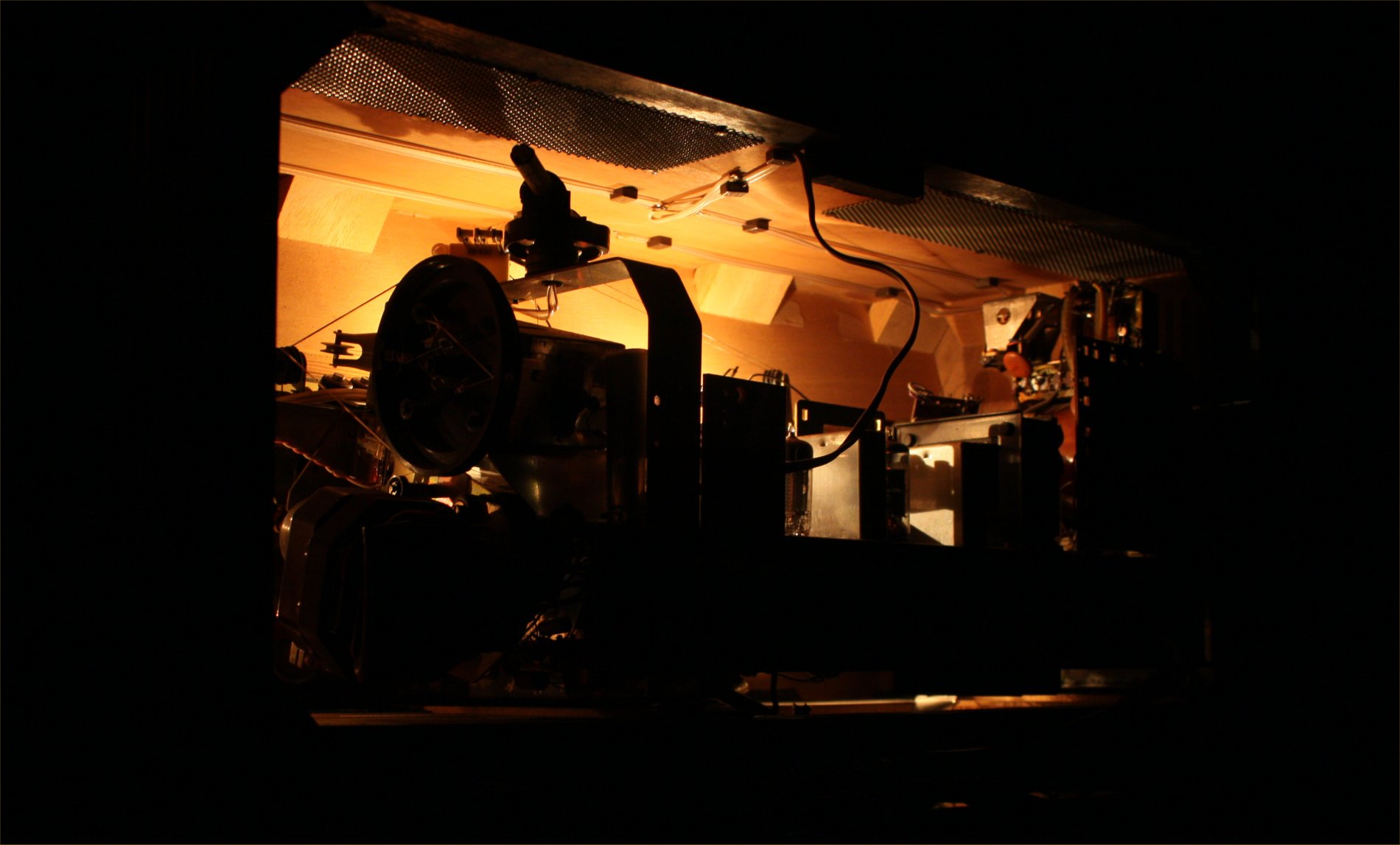
 tambour 61 - cn
tambour 61 - cn











即使是同一家公司,原始的机壳是由AEG制造,但框架、电子零件和各部件是来自德律风根。例如,AEG Tambour 61和Telefunken Concertino 2194是相同的,只是名称不同。该设备特别之处是,相对其他老式收音机而言,它在中频设计有几个亮点。
在这种情况下,该设备具有中频放大器和自动频率控制(AFC),一旦调整到电台时,AFC会自动锁定这个频道。
在其他厂牌的设备,按下AFC按钮,你得到完美的调谐稳定性,但在搜索过程中,才有可能接收最强的站;反之,不按AFC按钮,它是可能接收所有的电台但调谐是不稳定的。
AEG和德律风根开发了一个美好的的系统来解决这一问题,说明如下:
在FM模式,无线接收是绝对完美的,摆脱不稳定的结果。
在后端配备一对A级推挽ECL86电子管,低频段声音是壮丽的。优秀的ECL86电子管:
它的优点使喇叭表现更高效率,而且声音很甜,精力充沛。
关于扬声器的位置, 从任何角度听, 设备声音保持不变。
这使得它更令人愉快,同时有多种音调控制提供听音乐和节目的效果。
最后,木制机壳是闪亮的并且在一个良好的状态。它是均匀对称的,具有创新的设计---感觉像是天琴座的波型。
虽是9支电子管,但几乎是一倍或三倍17个单电子管的总量。這意味著某些管子有兩個或更多的功能。例如,ECC85是一支电子管,但裡面有兩個三極管(双三极管)。
。
-
自动频率控制(AFC)自动排他性




1883年AEG“Allegemaine Electricitats Gesellschaft“(德国电器公司)的诞生得要感谢Emil Rathenau,一名来自柏林的工程师。他买了爱迪生灯泡的专利,在德国通过他的公司“德国爱迪生协会”(OEG)(德国爱迪生公司),开始商业化。
1887年 AEG公司在世界展览期间展示了第一件电子器具:铁壶和卷发钳。
AEG公司成为德国最重要的电器产品生产商。
1903年AEG与Siemans A. G一起创立了德律风根。这个想法要把将德律风根在德国转变为一家与视频-广播–电气和军事技能第一的技术公司。
1907年 AEG公司雇用了建筑师和设计师 Peter Behrens 担任工业工程师。
1911年德皇Kaiser Guglielmo派德律风根的工程师至West Sayville(纽约)建立一个无线电塔,高180米。一个类似建于Nauen(德国)的塔,创造了独特的北美洲与欧洲之间的无线通信网络。在纽约建造塔时,于工作区德国工作人员被禁止接近美国工作人员。
1912年AEG公司生产的有名的”Dandy”吸尘器,从那一刻起,AEG不断创新及其专业的环境下在德国市场占主导地位。今天,AEG公司属于Electrolux Group ( 伊莱克斯集团 )。
主要特点
生产年份:1961年
超外差式收音机IF: 472/10700
8 AM电路,11 FM电路.
无线电波段: LW, MW, SW, FM
工作电压: 110; 125; 160; 220 Volts
Loudspeakers:
2 elliptical fullrange
2 Tweeters
尺寸(长高深): 640 x 375 x 270毫米
净重: 14.3 公斤
9 放大管: ECC85 ECH81 2xEF89 EM84 EABC80 ECC83 2xECL86
AM採用旋转镍锌铁氧体天线
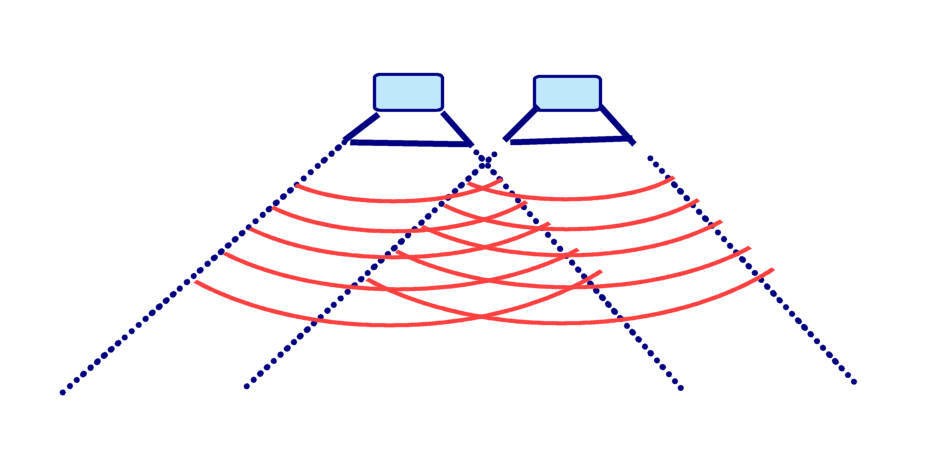
双前置扬声器 发射特性
两个前扬声器中的每一个具有相当宽的发射角。
站在收音机中央前方,两个扬声器的输出区域相交。
在单声道听,声的感觉是听到一个单一的中央扬声器。
但如果是两个扬声器,发射表面是非常高的,声音产生的效果如同一个大的低音扬声器一样。
同时,前置的两个扬声器比一个大的低音扬声器,具有体积小、重量轻的振膜及线圈,所以他们会更快。
因此,低频率更即时的,在高频率范围是非常广阔的。这是一个昂贵但高性能的选择。
音调控制系统是非常有效的,在音调控制旋钮上,你可以找到一个小窗口,逐渐显示出对乐队的重点。







Klangregister是音效预设器,按钮介绍预设的均衡曲线。它们被分为两组,在按钮的左边和右边的范围选择。
Bass:强调低响度
Solo:独奏,介绍中等响度
Intimi:降低高音
Jazz:爵士乐,增強高音

机壳内有一个半波偶极天线FM调频接收和旋转镍锌铁氧体天线AM调幅接收。
旋转镍锌铁氧体天线可以从外部旋转,实现了在AM调幅完美的调整。
在这张图片中,看到旋转机构和空中的位置指示器。具有内部天线的接收灵敏度很好。
生產这收音機的那年代,那時的廣播电台是寥寥可數的。
使用外部天线会使接收灵敏度进一步增加。
调谐系统是另一个特点
该单元配备了保持独立的AM调幅和FM调频带的机制。
它是一个非常可靠和精致的系统。


这个收音机有一个独特的功能: 自动频率控制(AFC)自动排他性。
工作机制如下:
它必须是旋转右侧最大的银边旋钮,调谐到任何调频电台,。
要旋转它,只需按下的白色小管的AFC,通过旋钮的内部接触,然后它可以藉由最强和最弱的信号调谐到所有的站都。
当您释放旋钮,通过相同的接触,AFC自动插入本身并在最大功率下锁住电台。
其他设备似乎不使用此系统。我想是AFC太贵了!
调谐指示当然已经被更換
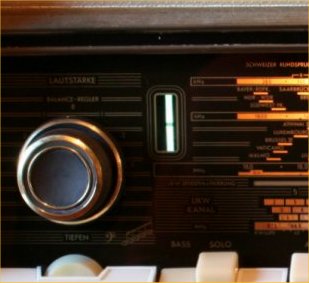
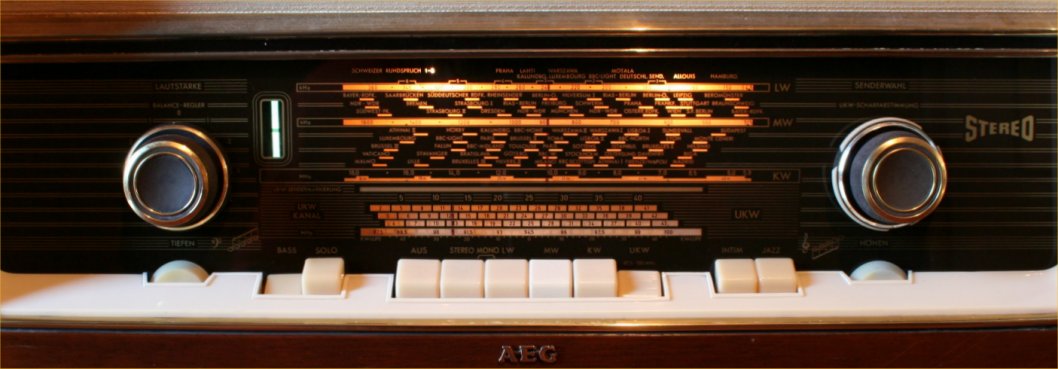
在左边有音量旋钮(与合并响度)。
魔眼可以显示电台的信号是否被完美调谐。
AM调幅波段( 长,中,短波 )和FM调频波段。
下面从左到右,还有以低音旋钮,低音和Solo( 独奏 )按钮,关闭电源,立体声录音机,单声道录音机,长,中、短波、FM调频按钮,Intim和爵士乐,高音旋钮。
在每个按钮下显示的频段。
最后,有调谐旋钮,同轴小旋钮為AM调幅和大的银边旋钮為FM调频,因为它是由兩个飞轮支持,这使得转动顺畅。

AM调幅和FM调频天线输入和接地插座
外部扬声器输出
录音机插座(1)
唱片机输入(2)












